Forums
- Forums
- Duggy's Reference Hangar
- USAAF / USN Library
- McDonnell F-101 Voodoo
McDonnell F-101 Voodoo
Post a reply
- Go to Previous topic
- Go to Next topic
- Go to Welcome
- Go to Introduce Yourself
- Go to General Discussion
- Go to Screenshots, Images and Videos
- Go to Off topic
- Go to Works in Progress
- Go to Skinning Tips / Tutorials
- Go to Skin Requests
- Go to IJAAF Library
- Go to Luftwaffe Library
- Go to RAF Library
- Go to USAAF / USN Library
- Go to Misc Library
- Go to The Ops Room
- Go to Made in Germany
- Go to Campaigns and Missions
- Go to Works in Progress
- Go to Juri's Air-Raid Shelter
- Go to Campaigns and Missions
- Go to Works in Progress
- Go to Skinpacks
- Go to External Projects Discussion
- Go to Books & Resources
-
4 years agoSat Jun 05 2021, 04:34pmDuggy
 Main AdminDesign and development
Main AdminDesign and development
The Voodoo's career as a fighter-bomber was relatively brief, but the reconnaissance versions served for some time. Along with the US Air Force's Lockheed U-2 and US Navy's Vought RF-8 Crusaders, the RF-101 reconnaissance variant of the Voodoo was instrumental during the Cuban Missile Crisis and saw extensive service during the Vietnam War. Interceptor versions served with the Air National Guard until 1982, and in Canadian service, they were a front line part of NORAD until their replacement with the CF-18 Hornet in the 1980s.
While the Voodoo was a moderate success, it may have been more important as an evolutionary step towards its replacement in most roles, the F-4 Phantom II, one of the most successful Western fighter designs of the 1950s. The Phantom would retain the twin engines, twin crew for interception duties, and a tail mounted well above and behind the jet exhaust but was an evolution of the F3H Demon while the Voodoo was developed from the earlier XF-88 Voodoo.
Initial design
Initial design on what would eventually become the Voodoo began just after World War II in response to a USAAF Penetration Fighter Competition in 1946. This called for a long-range, high-performance fighter to escort a new generation of bombers, much as the North American P-51 Mustang had escorted the Boeing B-17 Flying Fortresses and Consolidated B-24 Liberators in World War II. Several companies responded with designs, and the Air Force provided funds for several of them to produce prototypes.
After being awarded a contract (AC-14582) on 14 February 1947, McDonnell built two prototypes, designated the XF-88 Voodoo.
XF-88 Voodoo. See here -- http://axis-and-allies-paintworks.com/e107_plugins/forum/forum_viewtopic.php?id=18354
The F-88 was redesignated the F-101 Voodoo in November 1951
Design changes for new engines
The new design was considerably larger, carrying three times the initial fuel load and designed around larger, more powerful Pratt & Whitney J57 turbojets. The greater dimensions of the J57 engines required modifications to the engine bays, and modification to the intakes to allow a larger amount of airflow to the engine. The new intakes were also designed to be more efficient at higher Mach numbers. In order to increase aerodynamic efficiency, reduce structural weight and alleviate pitch-up phenomena recently identified in-flight testing of the Douglas D-558-2 Skyrocket, an aircraft with a control surface configuration similar to the XF-88, the horizontal tail was relocated to the top of the vertical stabilizer, giving the F-101 its signature "T-tail". In late 1952, the mission of the F-101 was changed from "penetration fighter" to "strategic fighter", which entailed equal emphasis on both the bomber escort mission and on nuclear weapons delivery. The new Voodoo mock-up with the reconfigured inlets, tail surfaces, landing gear, and dummy nuclear weapon was inspected by Air Force officials in March 1953.The design was approved, and an initial order for 29 F-101As was placed on 28 May 1953, no prototypes being required as the F-101 was considered a simple development of the XF-88, with the Cook-Cragie production policy, in which initial low-rate production would be used for testing without the use of separate prototypes, chosen instead
First production
F-101A serial number 53-2418 was the first production aircraft; its maiden flight was on 29 September 1954 at Edwards AFB where it reached Mach 0.9 (961.0 km/h) at 35,000 feet .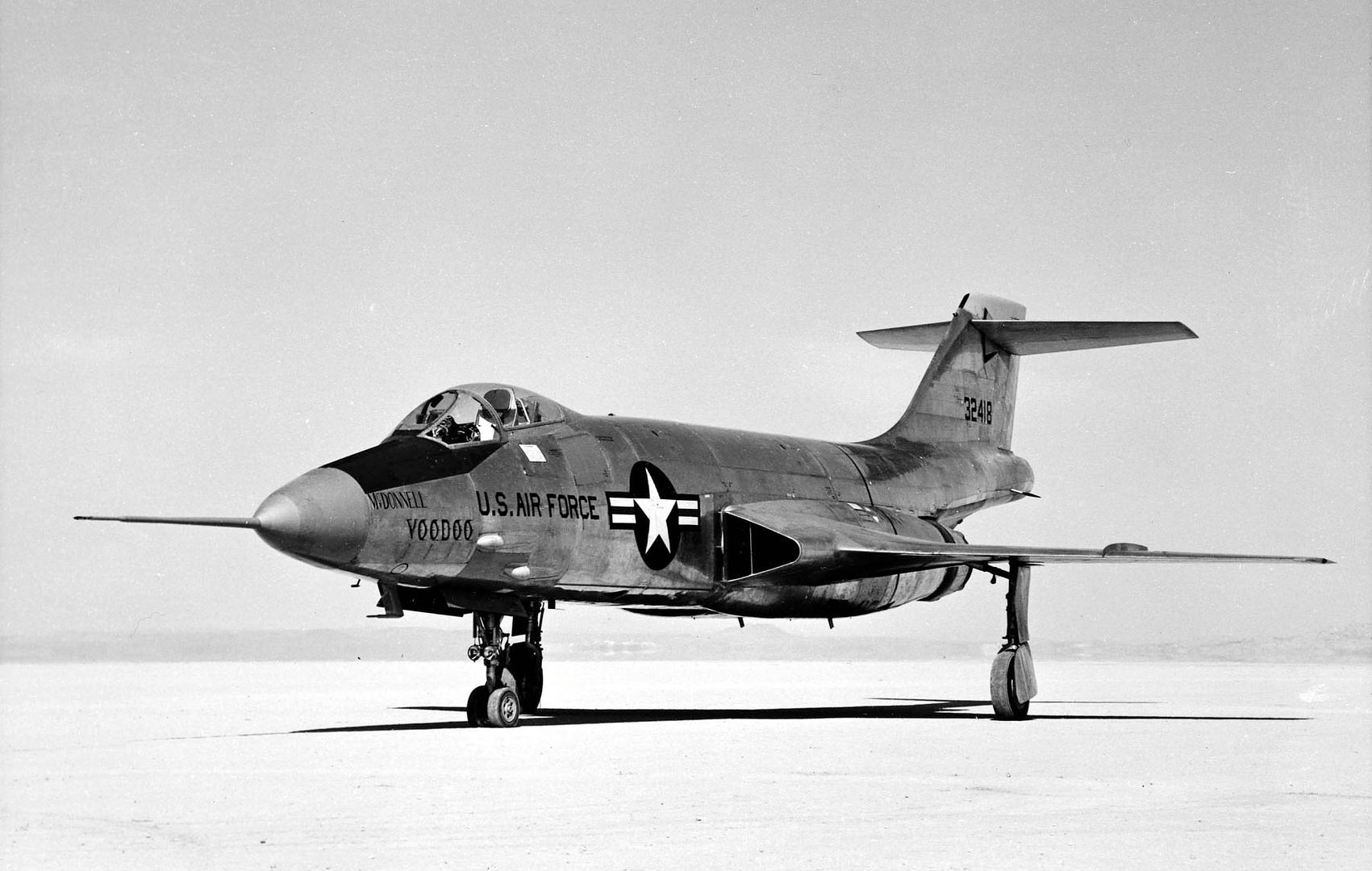
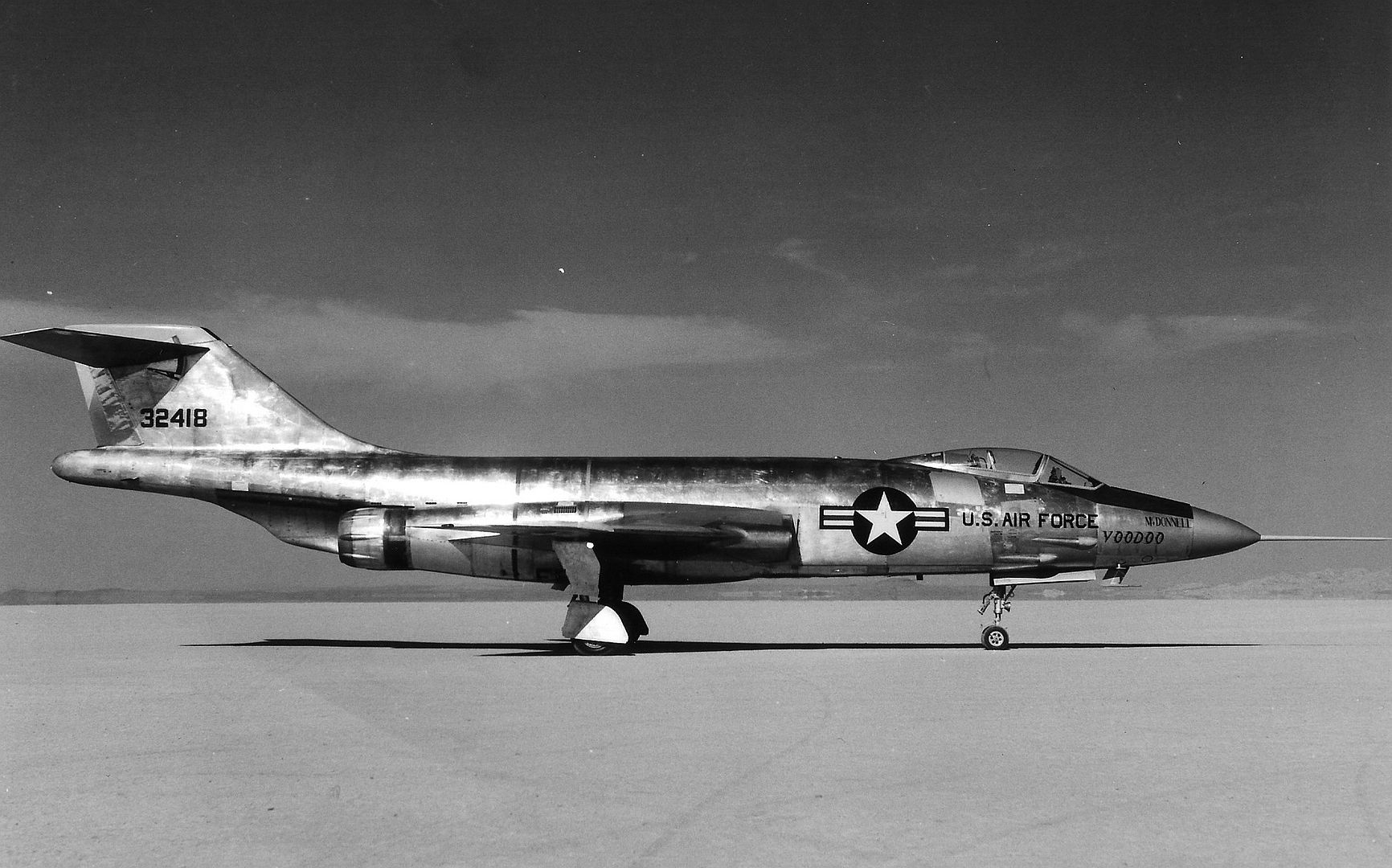
The end of the war in Korea and the development of the jet-powered Boeing B-52 Stratofortress negated the need for fighter escort and Strategic Air Command withdrew from the program.
Despite SAC's loss of interest, the aircraft attracted the attention of Tactical Air Command (TAC), and the F-101 was reconfigured as a fighter bomber, intended to carry a single nuclear weapon for use against tactical targets such as airfields. With the support of TAC, testing was resumed, with Category II flight tests beginning in early 1955. A number of problems were identified during development, with many of these fixed. The aircraft had a dangerous tendency toward severe pitch-up at high angle of attack that was never entirely solved. Around 2,300 improvements were made to the aircraft in 1955–56 before full production was resumed in November 1956.
Operational history
F-101A / RF-101G
The first F-101A was delivered on 2 May 1957 to the 27th Strategic Fighter Wing, which transferred to TAC in July that year, replacing their F-84F Thunderstreak. The F-101A was powered by two Pratt & Whitney J57-P-13 turbojets,allowing good acceleration, climb-performance, ease in penetrating the sound barrier in level flight, and a maximum performance of Mach 1.52. The F-101's large internal fuel capacity allowed a range of approximately 3,000 mi (4,828 km) nonstop. The aircraft was fitted with an MA-7 fire-control radar for both air-to-air and air-to-ground use, augmented by a Low Altitude Bombing System (LABS) for delivering nuclear weapons, and was designed to carry a Mk 28 nuclear bomb. The original intended payload for the F-101A was the McDonnell Model 96 store, a large fuel/weapons pod similar in concept to that of the Convair B-58 Hustler, but was cancelled in March 1956 before the F-101 entered service. Other operational nuclear payloads included the Mk 7, Mk 43, and Mk 57 weapons. While theoretically capable of carrying conventional bombs, rockets, or Falcon air-to-air missiles, the Voodoo never used such weapons operationally. It was fitted with four 20mm M39 cannon, with one cannon often removed in service to make room for a TACAN beacon-receiver.
The F-101 set a number of speed records, including: a JF-101A (the ninth F-101A modified as a testbed for the more powerful J-57-P-53 engines of the F-101B) setting a world speed record of 1,207.6 mph (1,943.4 km/h) on 12 December 1957 during "Operation Firewall",[19] beating the previous record of 1,132 mph (1,811 km/h) set by the Fairey Delta 2 in March the previous year. The record was then subsequently taken in May 1958 by a Lockheed F-104 Starfighter. On 27 November 1957, during "Operation Sun Run," an RF-101C set the Los Angeles-New York City-Los Angeles record in 6 hours 46 minutes, the New York to Los Angeles record in 3 hours, 36 minutes, and the Los Angeles to New York record in 3 hours 7 minutes.
A total of 77 F-101As were built. They were gradually withdrawn from service starting in 1966.Twenty-nine survivors were converted to RF-101G specifications with a modified nose, housing reconnaissance cameras in place of cannons and radar. These served with the Air National Guard through 1972.
RF-101A
In October 1953, the USAF requested that two F-101As be built as prototype YRF-101A tactical reconnaissance aircraft. These were followed by 35 RF-101A production aircraft.The RF-101A shared the airframe of the F-101A, including its 6.33 g (62 m/s²) limit, but replaced the radar and cannons with up to six cameras in the reshaped nose.Like all other models of the F-101, it had provision for both flying boom and probe-and-drogue in-flight refueling capability, as well as for a buddy tank that allowed it to refuel other aircraft.It entered service in May 1957,replacing the RB-57 Canberra.
USAF RF-101As from the 363d Tactical Reconnaissance Wing at Shaw AFB, SC flew reconnaissance sorties over Cuba during the Cuban Missile Crisis in October 1962.
In October 1959, eight RF-101As were transferred to Taiwan, which used them for overflights of the Chinese mainland. These ROCAF RF-101A were modified with the C-model vertical fins and air intake. The intake is used to cool the drag chute compartment and eliminates the 5-minute limit on using the afterburners on the A model.Two were reportedly shot down.
F-101B
In the late 1940s, the Air Force had started a research project into the future interceptor aircraft that eventually settled on an advanced specification known as the 1954 interceptor. Contracts for this specification eventually resulted in the selection of the F-102 Delta Dagger, but by 1952 it was becoming clear that none of the parts of the specification other than the airframe would be ready by 1954; the engines, weapons, and fire control systems were all going to take too long to get into service. An effort was then started to quickly produce an interim supersonic design to replace the various subsonic interceptors then in service, and the F-101 airframe was selected as a starting point.
Although McDonnell proposed the designation F-109 for the new aircraft (which was to be a substantial departure from the basic Voodoo),the USAF assigned the designation F-101B. It was first deployed into service on 5 January 1959, with the 60th Fighter-Interceptor Squadron.The production ended in March 1961. The Voodoo featured a modified cockpit to carry a crew of two, with a larger and more rounded forward fuselage to hold the Hughes MG-13 fire control radar of the F-102. It had a data link to the Semi-Automatic Ground Environment (SAGE) system, allowing ground controllers to steer the aircraft towards its targets by making adjustments through the plane's autopilot. The F-101B had more powerful Pratt & Whitney J57-P-55 engines, making it the only Voodoo not using the −13 engines. The new engines featured a substantially longer afterburner than J57-P-13s. To avoid a major redesign, the extended afterburners were simply allowed to extend out of the fuselage by almost 8 ft (2.4 m). The more powerful engines and aerodynamic refinements allowed an increased speed of Mach 1.85.
The F-101B was stripped of the four M39 cannons and carried four AIM-4 Falcon air-to-air missiles instead, arranged two apiece on a rotating pallet in the fuselage weapons bay. The initial load was two GAR-1 (AIM-4A) semi-active radar homing and two GAR-2 (AIM-4B) infrared-guided weapons with one of each carried on each side of the rotating pallet. After the first two missiles were fired, the door turned over to expose the second pair. Standard practice was to fire the weapons in SARH/IR pairs to increase the likelihood of a hit. Late-production models had provision for two 1.7-kiloton MB-1/AIR-2 Genie nuclear rockets on one side of the pallet with IR-guided GAR-2A (AIM-4C) on the other side. "Project Kitty Car" upgraded most earlier F-101Bs to this standard beginning in 1961.
The AIM-4 Falcon side of the F-101B missile door
From 1963–66, F-101Bs were upgraded under the Interceptor Improvement Program (IIP; also known as "Project Bold Journey"), with a fire control system enhancement against hostile ECM and an infrared sighting and tracking (IRST) system in the nose in place of the in-flight refueling probe.
The F-101B was made in greater numbers than the F-101A and C, with a total of 479 being delivered by the end of production in 1961.Most of these were delivered to the Air Defense Command (ADC) beginning in January 1959.
The F-101B was withdrawn from ADC service from 1969 to 1972, with many surviving USAF aircraft transferred to the Air National Guard (replacing F-102s), serving until 1982. The last Voodoo in US service (F-101B-105-MC, AF Ser. No. 58-300) was finally retired by the 2nd Fighter Weapons Squadron at Tyndall AFB, Florida on 21 September 1982.
F-101C / RF-101H
The F-101A fighter-bomber had been accepted into Tactical Air Command (TAC) service despite a number of problems. Among others, its airframe had proven to be capable of withstanding only 6.33 g (62 m/s²) maneuvers, rather than the intended 7.33 g (72 m/s²).An improved model, the F-101C, was introduced in 1957. It had a 500 lb (227 kg) heavier structure to allow 7.33-g maneuvers as well as a revised fuel system to increase the maximum flight time in afterburner. Like the F-101A it was also fitted with an underfuselage pylon for carrying nuclear weapons, as well as two hardpoints for 450-US-gallon (1,700 l) drop tanks.A total of 47 were produced.
Originally serving with the 27th Tactical Fighter Wing at Bergstrom AFB, Texas, the aircraft was transferred in 1958 from TAC to the 81st Tactical Fighter Wing, part of United States Air Forces in Europe (USAFE) which operated three squadrons from the twin RAF air stations Bentwaters & Woodbridge. The 78th Tactical Fighter Squadron was stationed at Woodbridge, while the 91st and 92nd were stationed at Bentwaters. The 81st TFW served as a strategic nuclear deterrent force, the Voodoo's long-range putting almost all of the Warsaw Pact countries, and targets up to 500 miles (800 km) deep into the Soviet Union within reach.
Both the A and C model aircraft were assigned to the 81st TFW and were used interchangeably within the three squadrons. Operational F-101A/C were upgraded in service with Low Angle Drogued Delivery (LADD) and Low Altitude Bombing System (LABS) equipment for its primary mission of delivering nuclear weapons at extremely low altitudes. Pilots were trained for high speed, low-level missions into Soviet or Eastern Bloc territory, with primary targets being airfields. These missions were expected to be one-way, with the pilots having to eject behind Soviet lines.
The F-101C never saw combat and was replaced in 1966 with the F-4C Phantom II.Thirty-two aircraft were later converted for unarmed reconnaissance use with the RF-101H designation. They served with Air National Guard units until 1972.
RF-101C
Using the reinforced airframe of the F-101C, the RF-101C first flew on 12 July 1957,entering service in 1958. Like the RF-101A, the RF-101C had up to six cameras in place of radar and cannons in the reshaped nose and retained the bombing ability of the fighter-bomber versions. 166 RF-101Cs were built, including 96 originally scheduled to be F-101C fighter-bombers.
The 1964 Project "Toy Tiger" fitted some RF-101C with a new camera package and a centerline pod for photo-flash cartridges. Some were further upgraded under the Mod 1181 program with automatic control for the cameras.
The RF-101C saw service during the Cuban Missile Crisis and soon followed the North American F-100 Super Sabres in October 1961, into combat when RF-101s from the 67th Tactical Reconnaissance Wing deployed to Vietnam. The RF-101C was deployed operationally during the Vietnam War, sustaining losses with the first F-101 being lost in November 1964 to ground fire. From 1965 through November 1970, its role was gradually taken over by the RF-4C Phantom II. In some 35,000 sorties, 39 aircraft were lost, 33 in combat,including five to SAMs, one to an airfield attack, and one in air combat to a MiG-21 in September 1967. The RF-101C's speed made it largely immune to MiG interception. 27 of the combat losses occurred on reconnaissance missions over North Vietnam. In April 1967, ALQ-71 ECM pods were fitted to provide some protection against SAMs. Although the Voodoo was again able to operate at medium altitudes, the added drag and weight decreased the speed enough to make RF-101 vulnerable to the maneuverable (and cannon-equipped) MiGs and thus requiring fighter escort.
On 27 November 1957 during Operation Sun Run, an RF-101C piloted by then-Captain Robert Sweet set the Los Angeles-New York City-Los Angeles record in 6 hours 46 minutes, and New York to Los Angeles record in 3 hours, 36 minutes. Another RF-101C, piloted by then-Lieutenant Gustav Klatt, set a Los Angeles to New York record of 3 hours 7 minutes.
After withdrawal from Vietnam, the RF-101C continued to serve with USAF units through 1979.
In service, the RF-101C was nicknamed the "Long Bird"; it was the only version of the Voodoo to see combat.
TF-101B / F-101F
Some of the F-101Bs were completed as dual-control operational trainer aircraft initially dubbed TF-101B, but later redesignated F-101F. Seventy-nine new-build F-101Fs were manufactured, and 152 more existing aircraft were later modified with dual controls. Ten of these were supplied to Canada under the designation CF-101F. These were later replaced with 10 updated aircraft in 1971.
[b]RF-101B[b]
In the early 1970s, a batch of 22 former Royal Canadian CF-101Bs was returned to the US Air Force and converted to RF-101B reconnaissance aircraft with their radar and weapons bay replaced with a set of three KS-87B cameras and two AXQ-2 TV cameras. An in-flight refueling boom receptacle was also fitted. These aircraft served with the 192d Tactical Reconnaissance Squadron of the Nevada Air National Guard through 1975. They were expensive to operate and maintain and had a short service life.
Variants
F-101A
initial production fighter bomber, 77 produced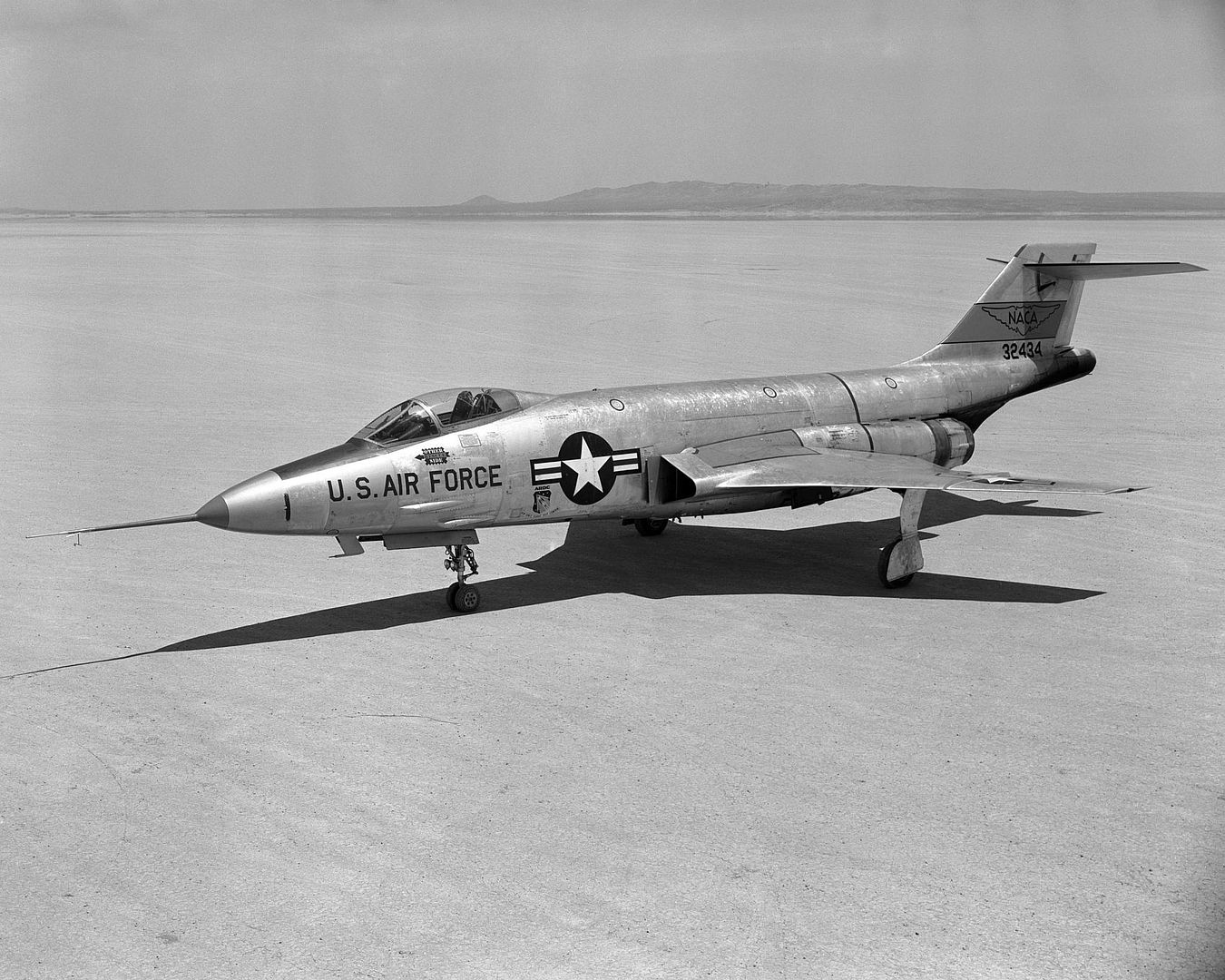
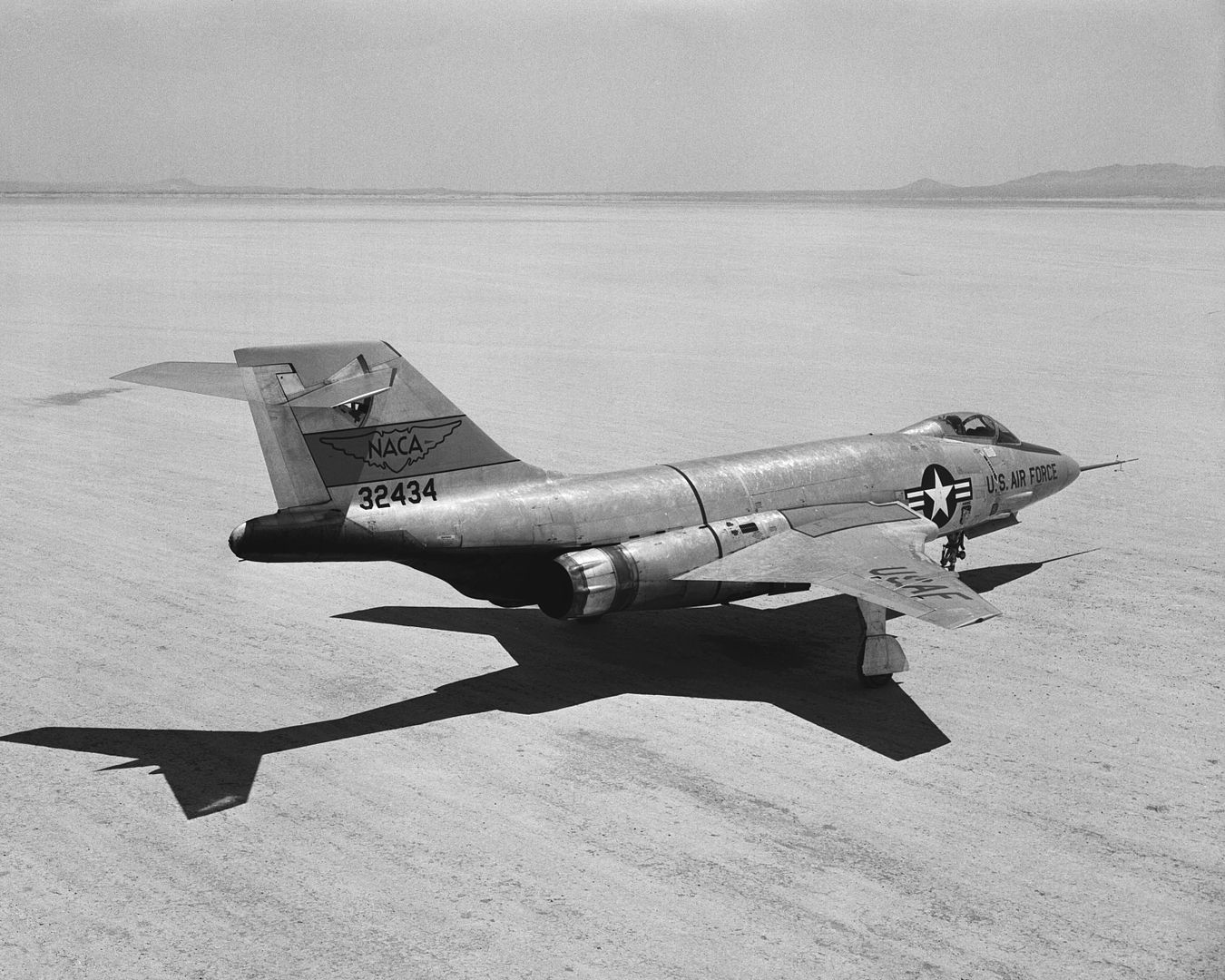



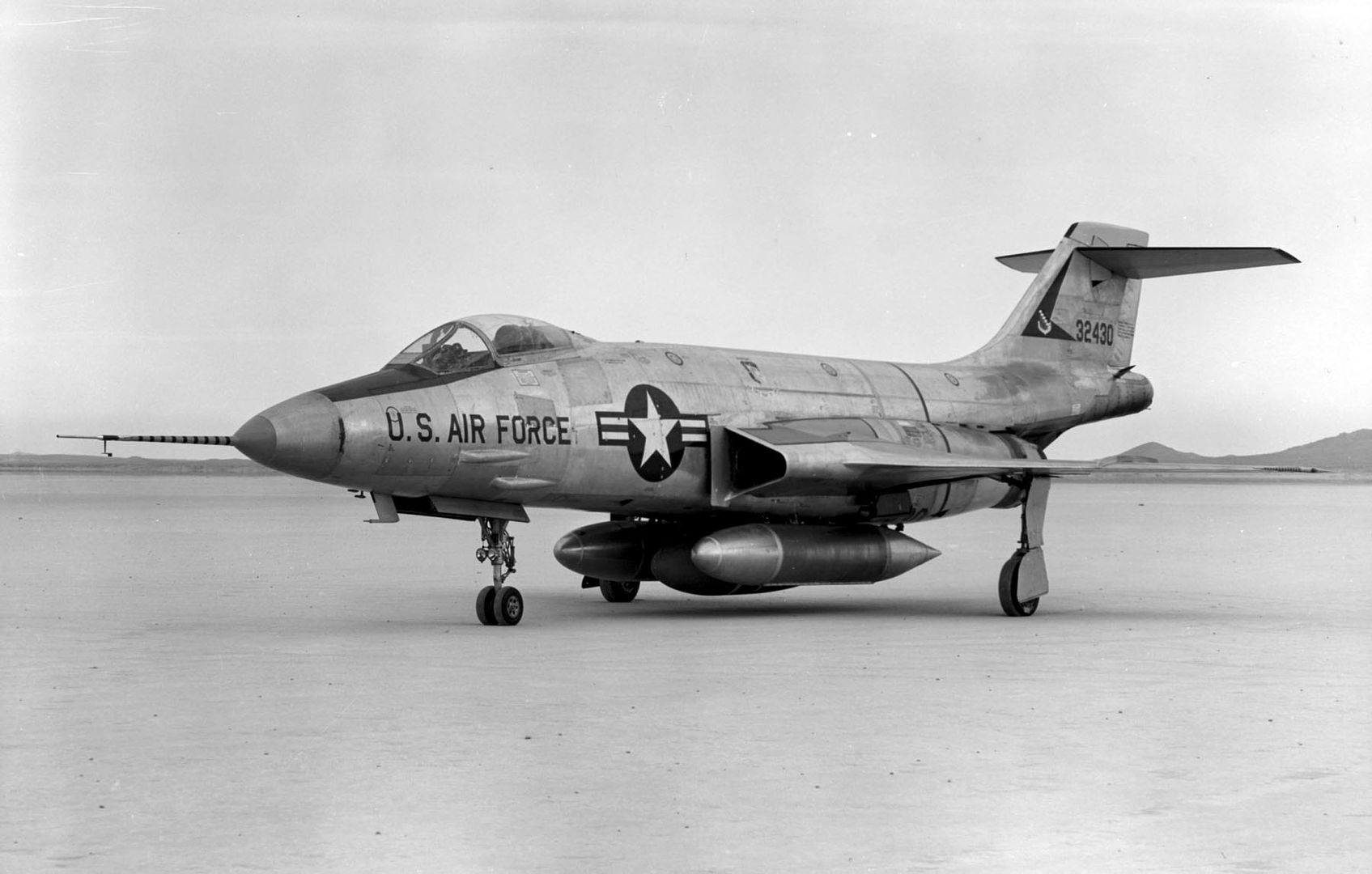

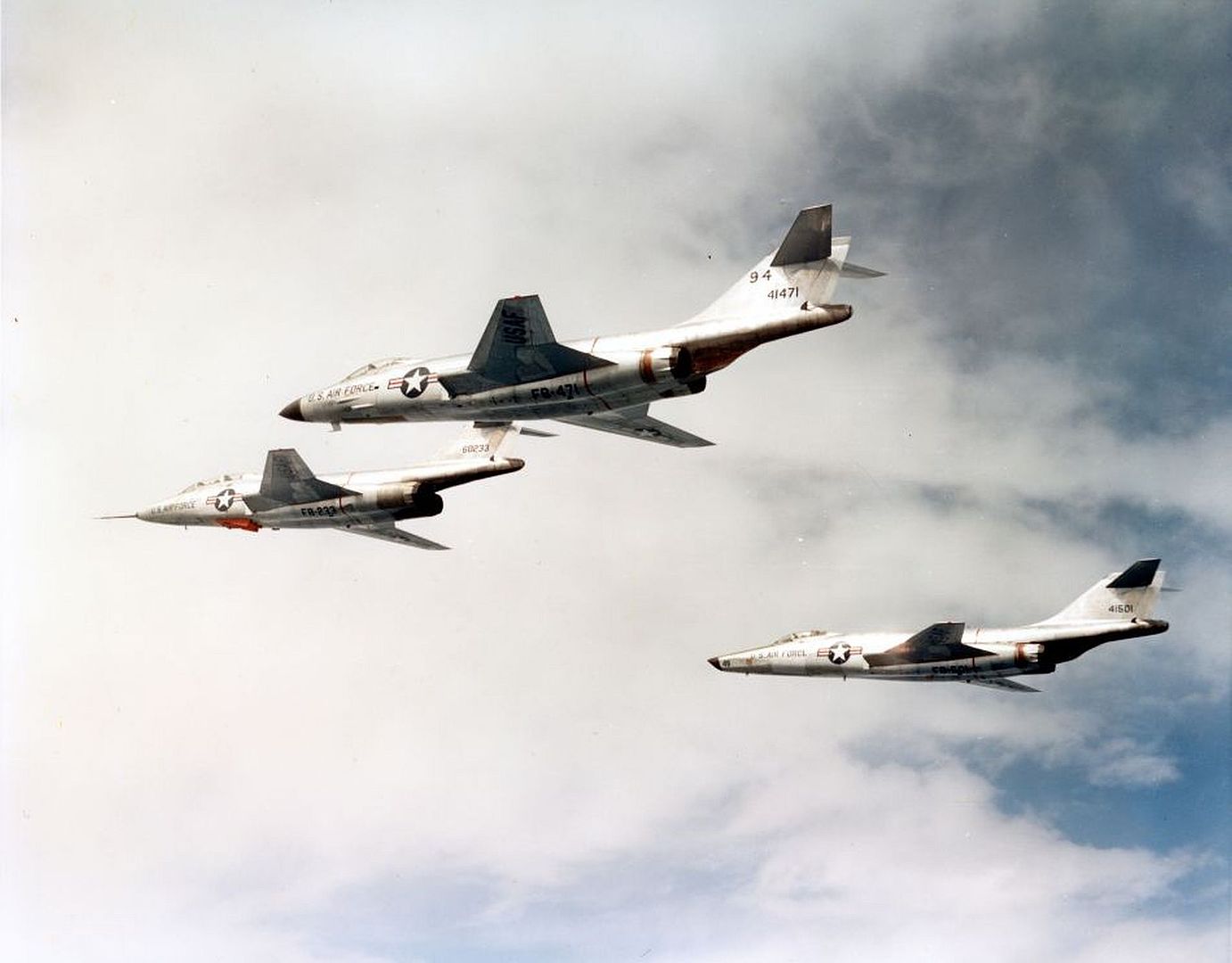
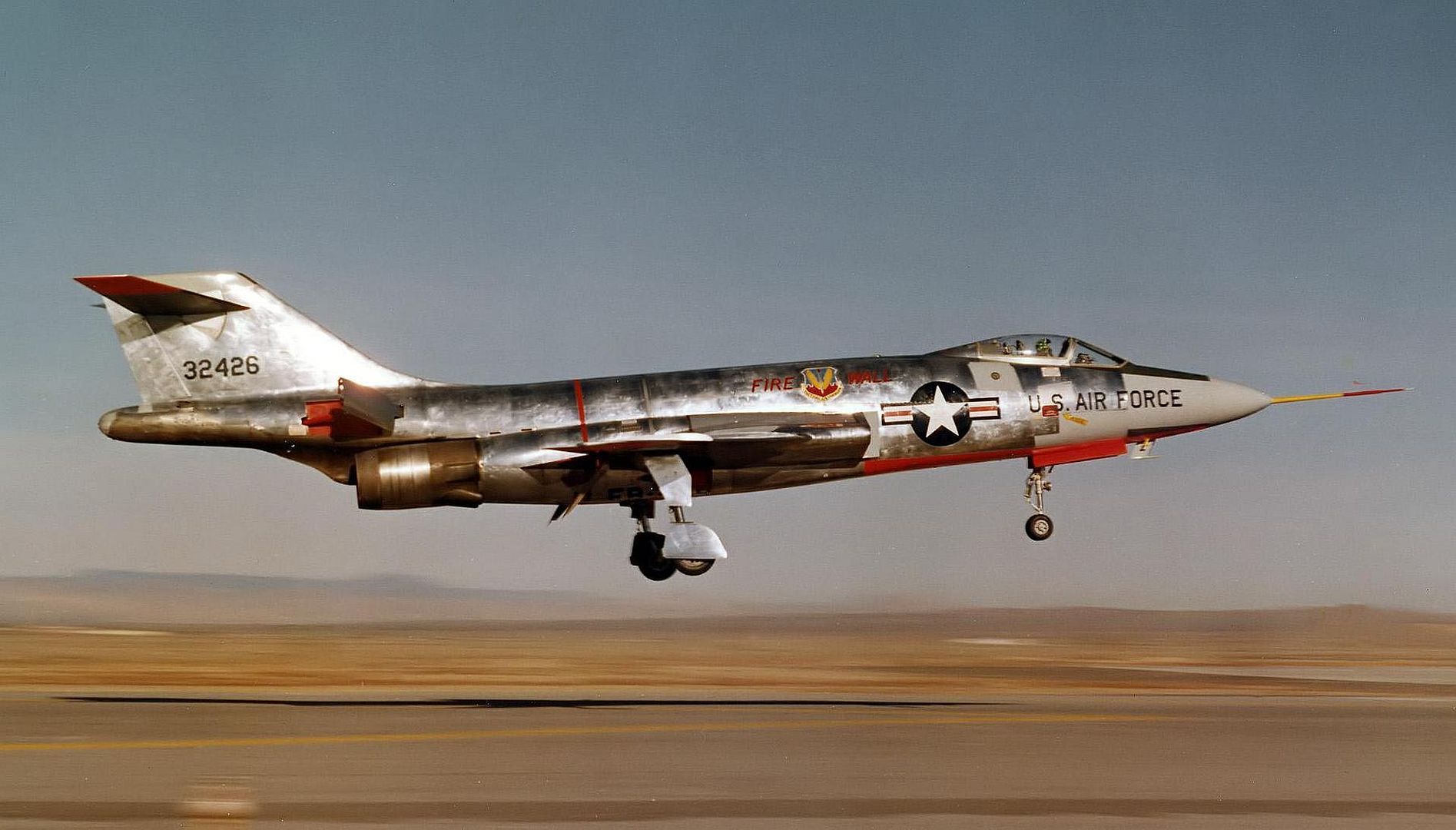
NF-101A
one F-101A used by General Electric for testing of the General Electric J79 engine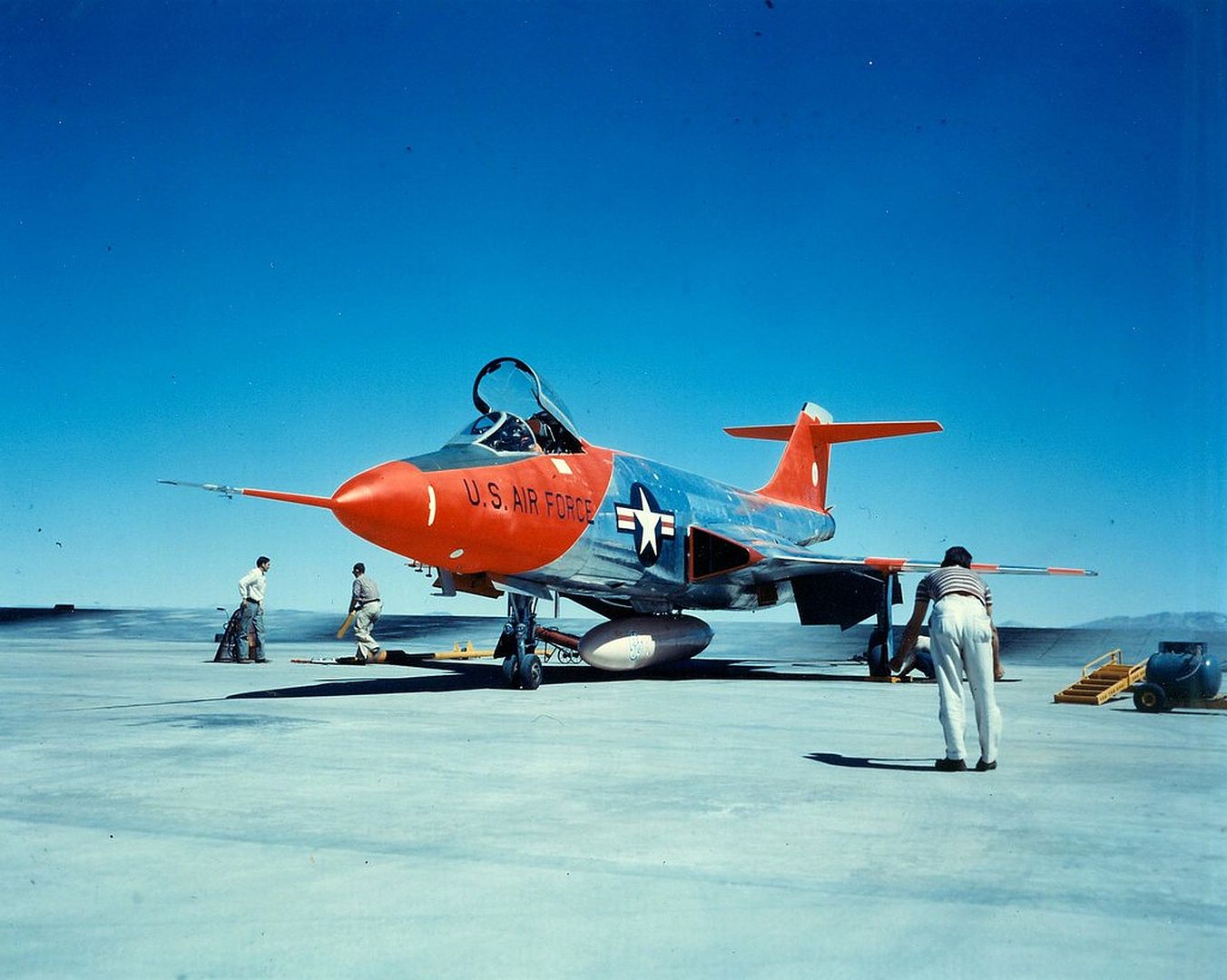
YRF-101A
two F-101As built as prototype reconnaissance models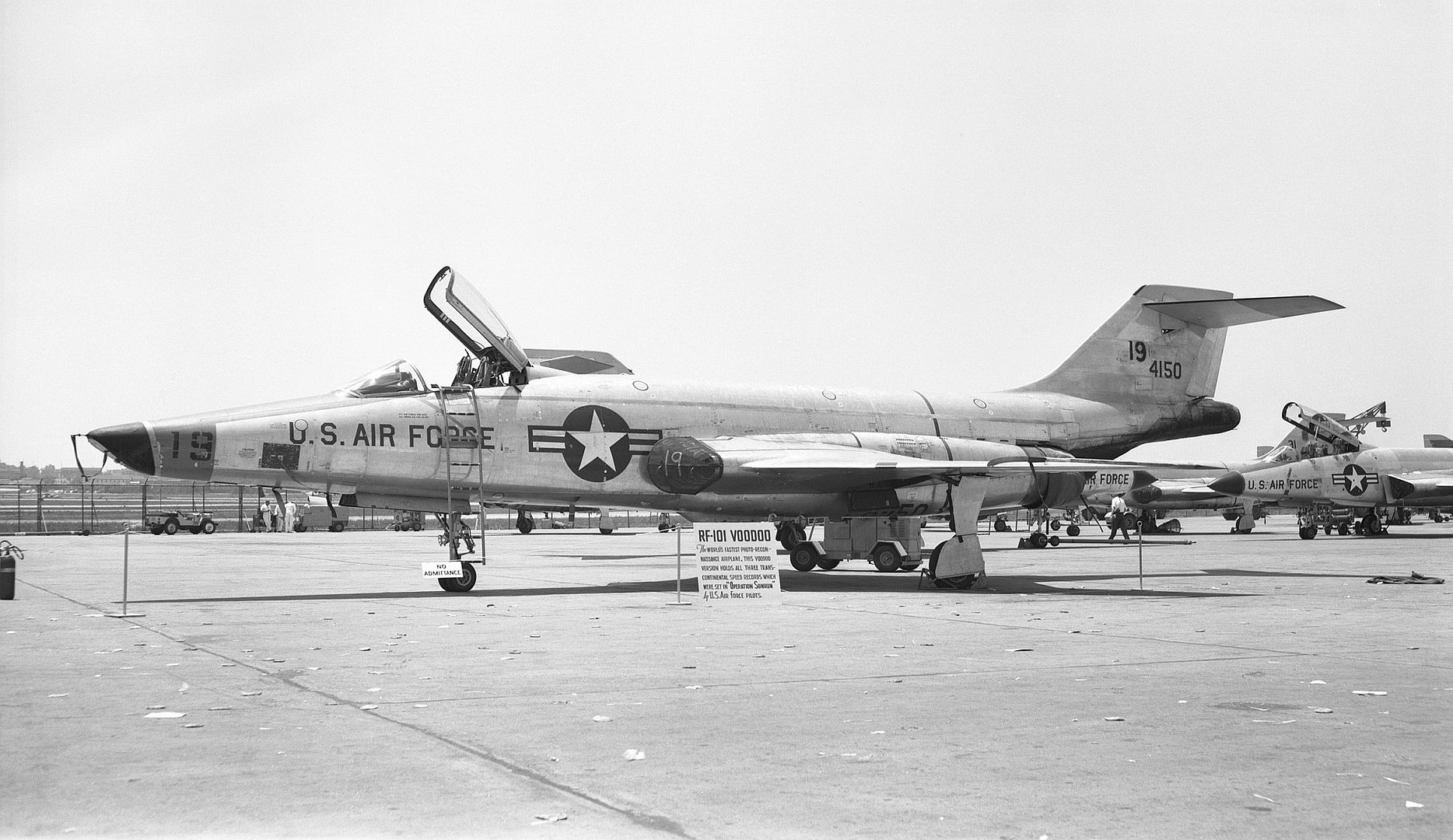
RF-101A
first reconnaissance version, 35 built
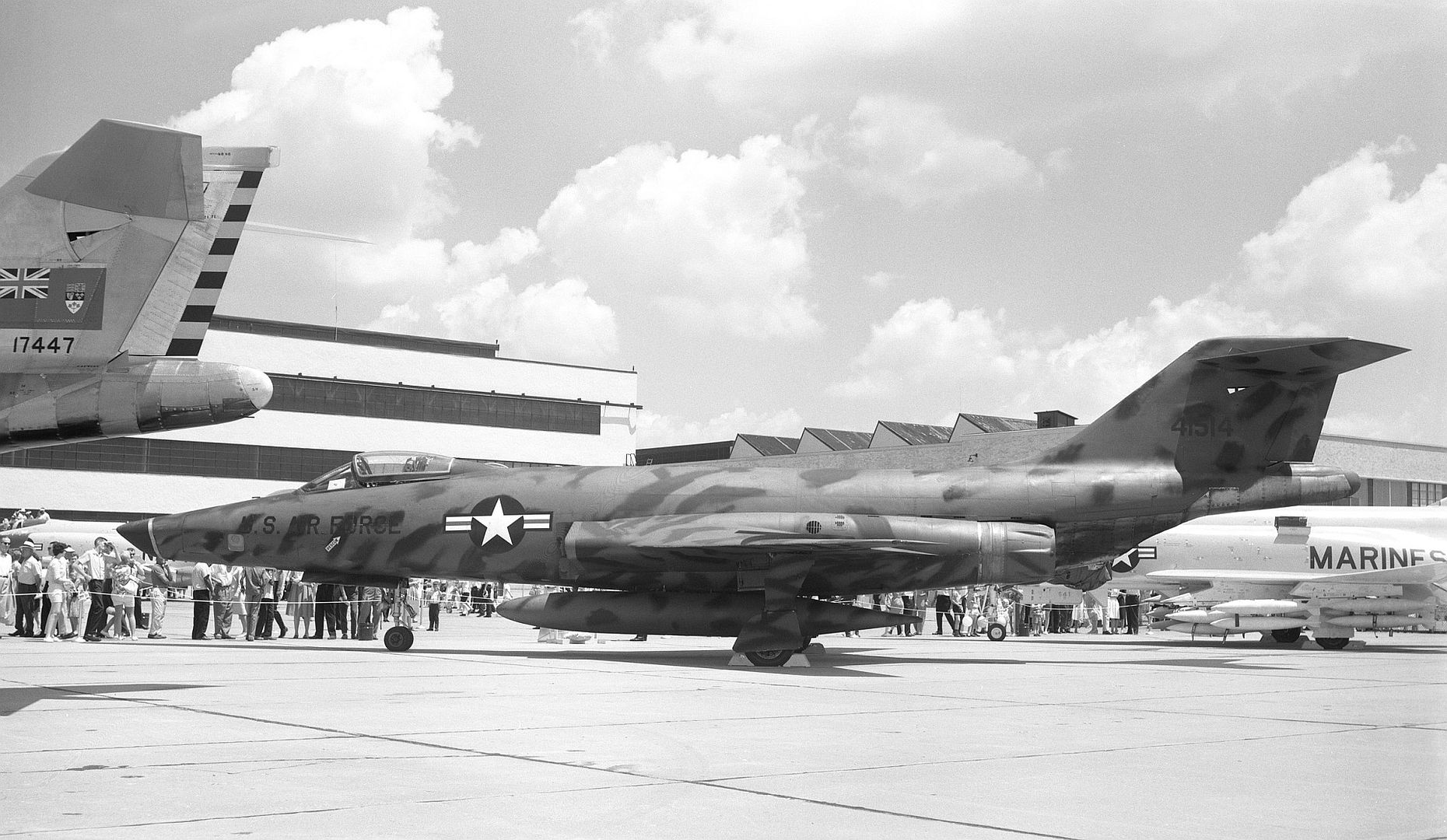
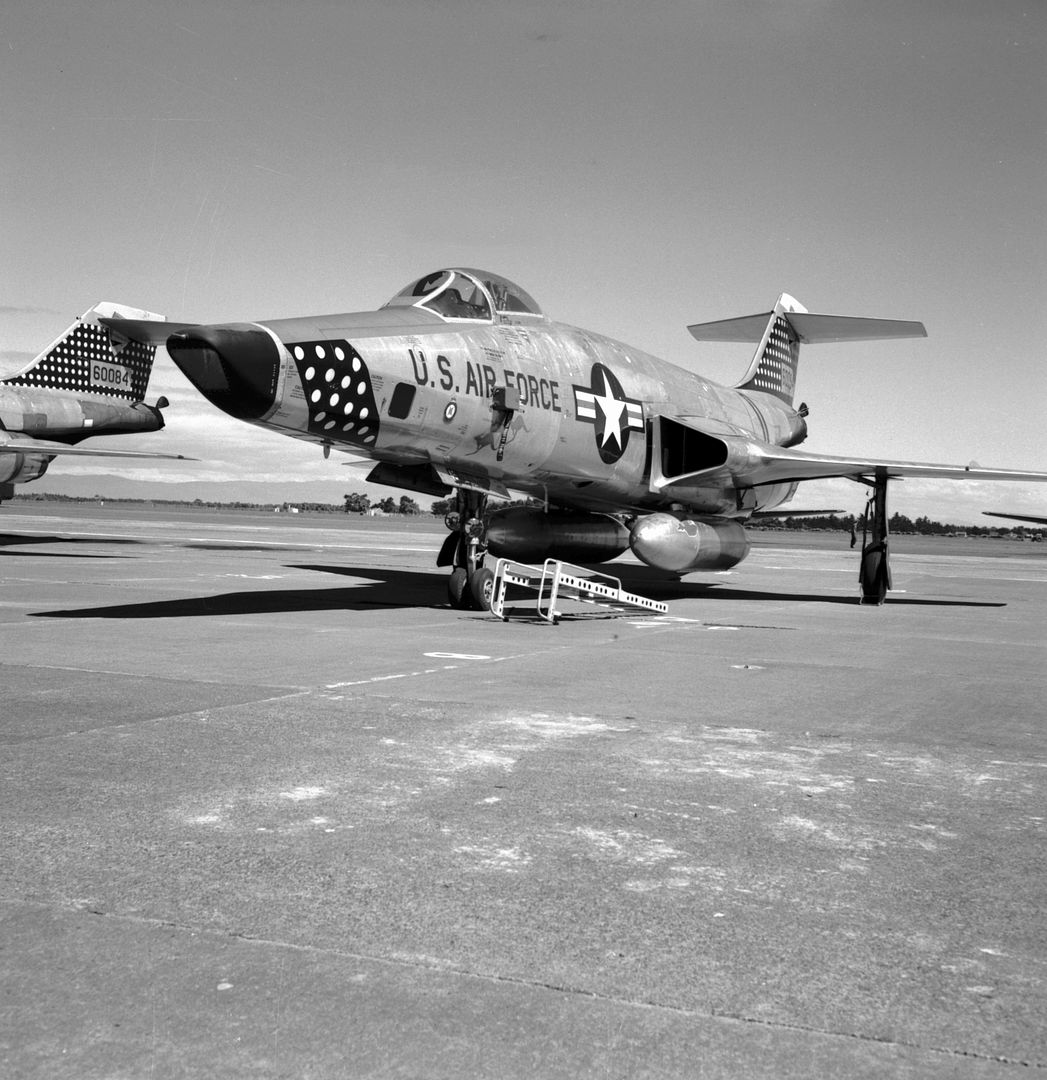
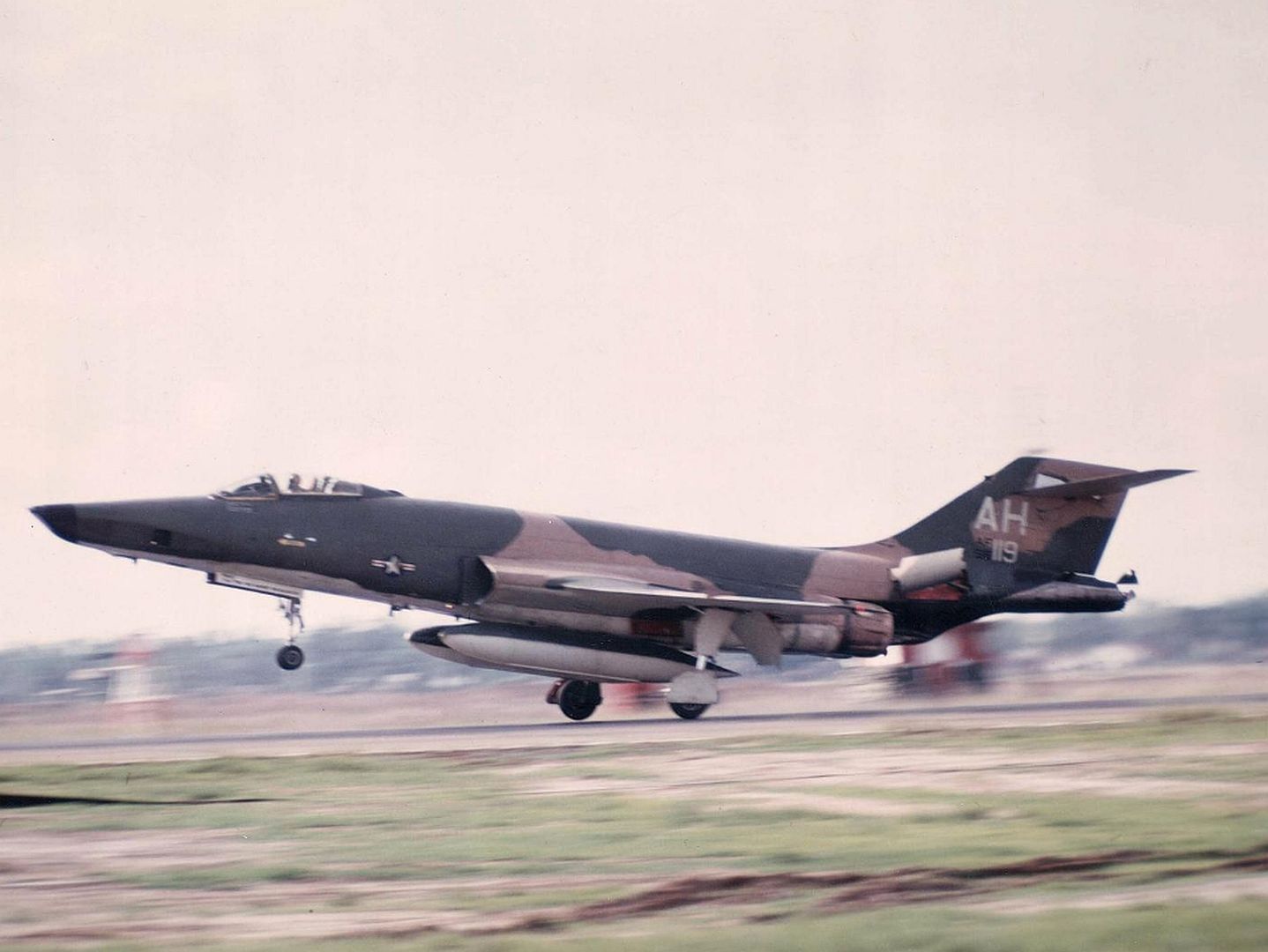
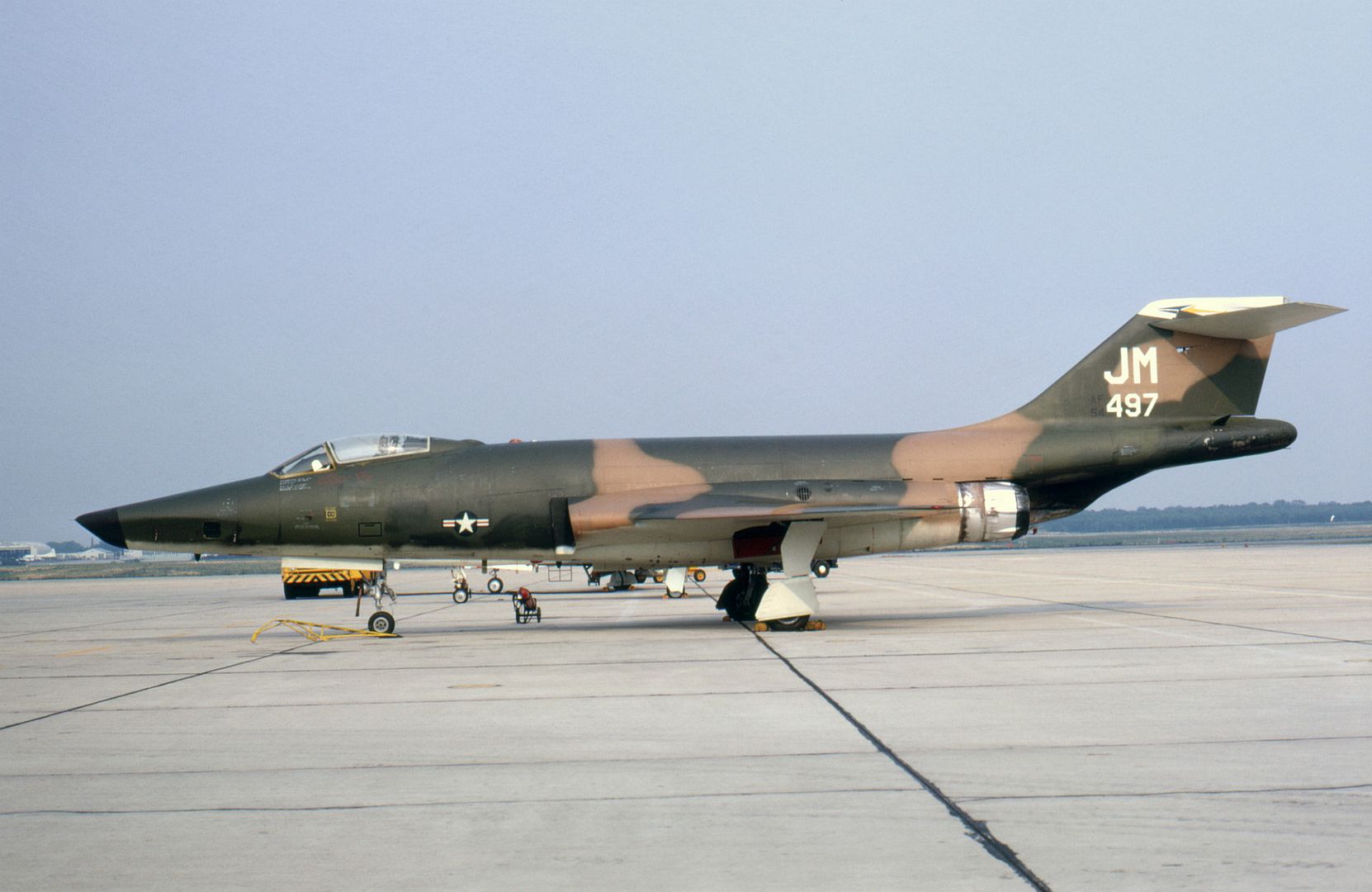
F-101B
two-seat interceptor, the most numerous version with 479 built (including CF-101B)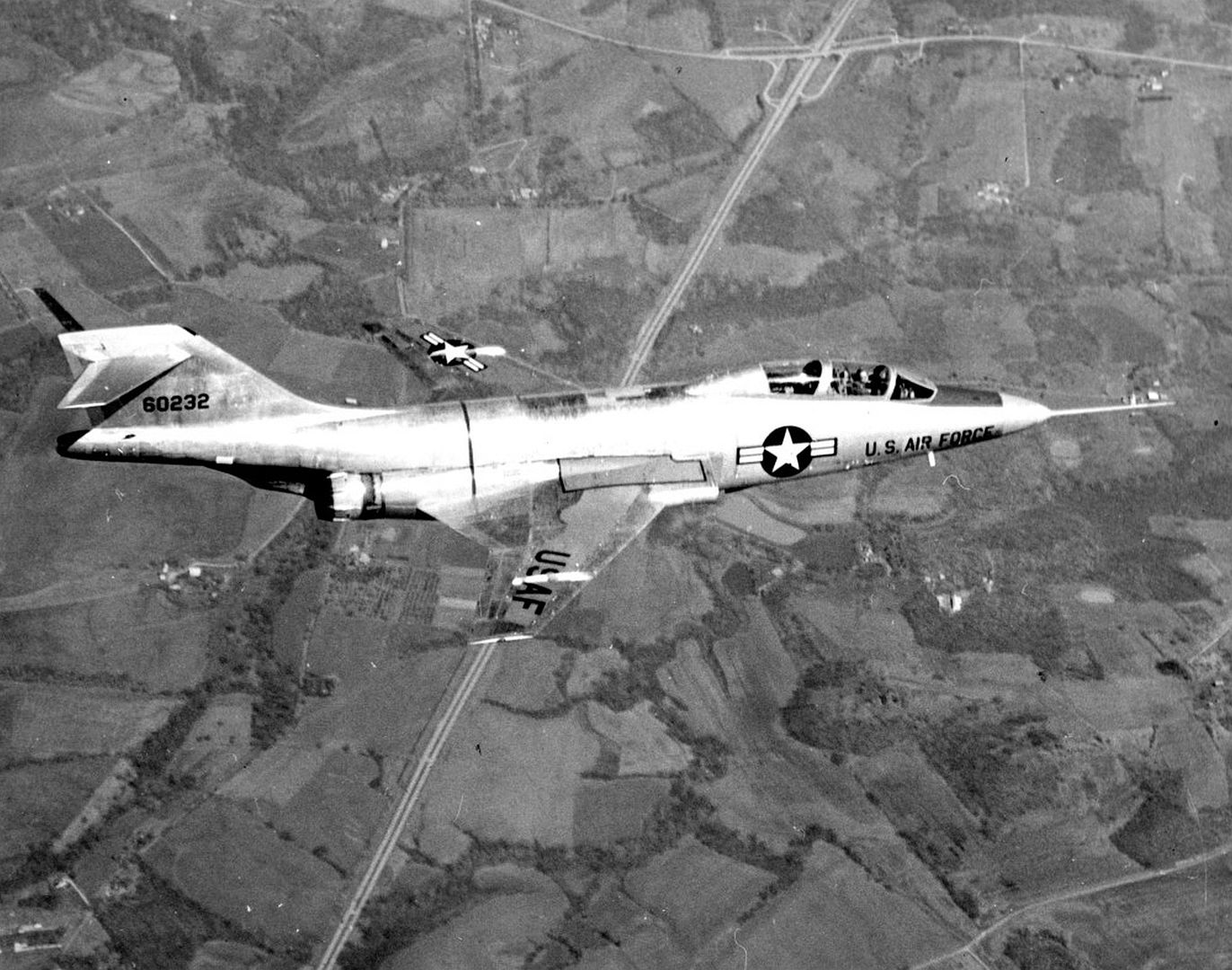
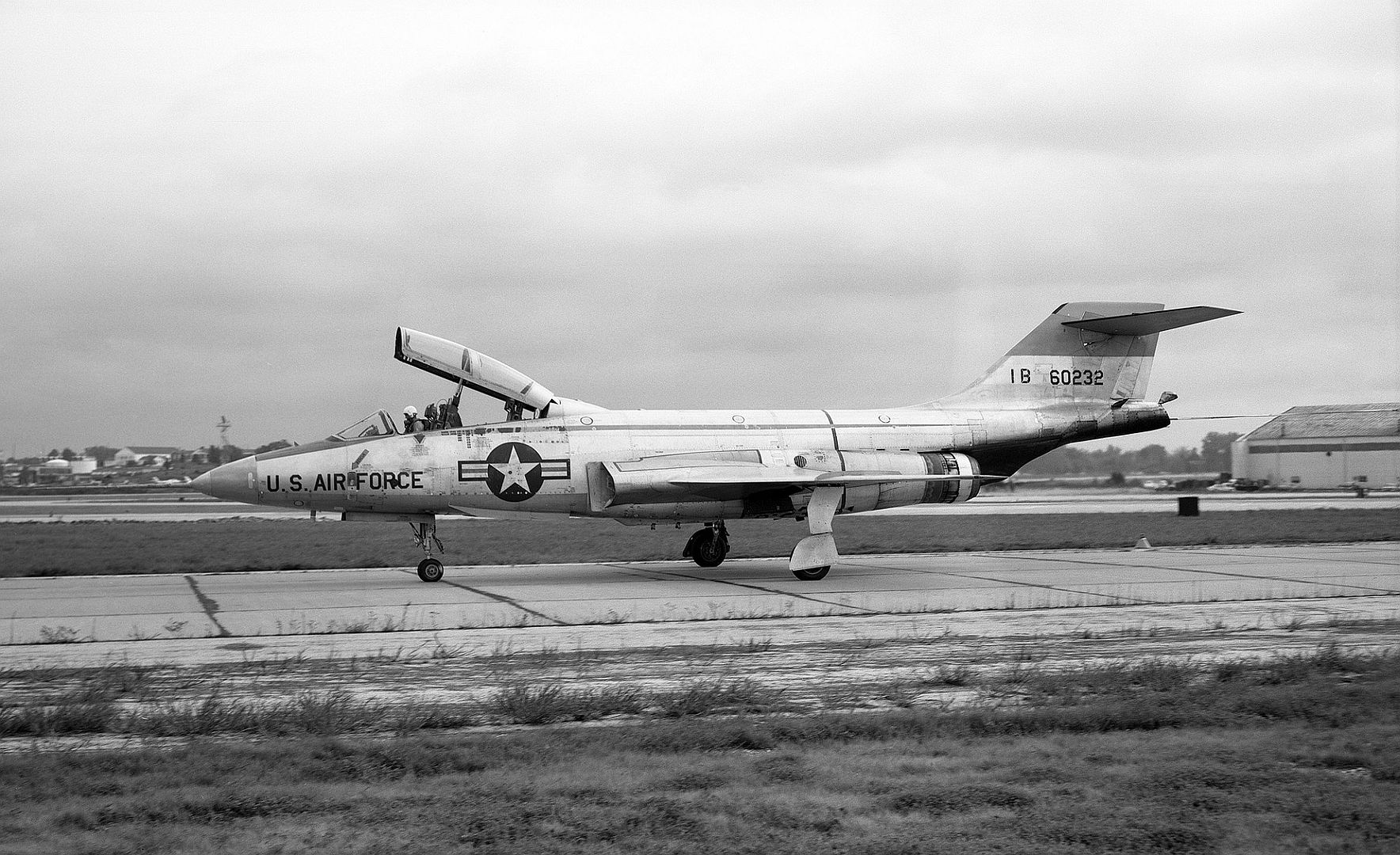
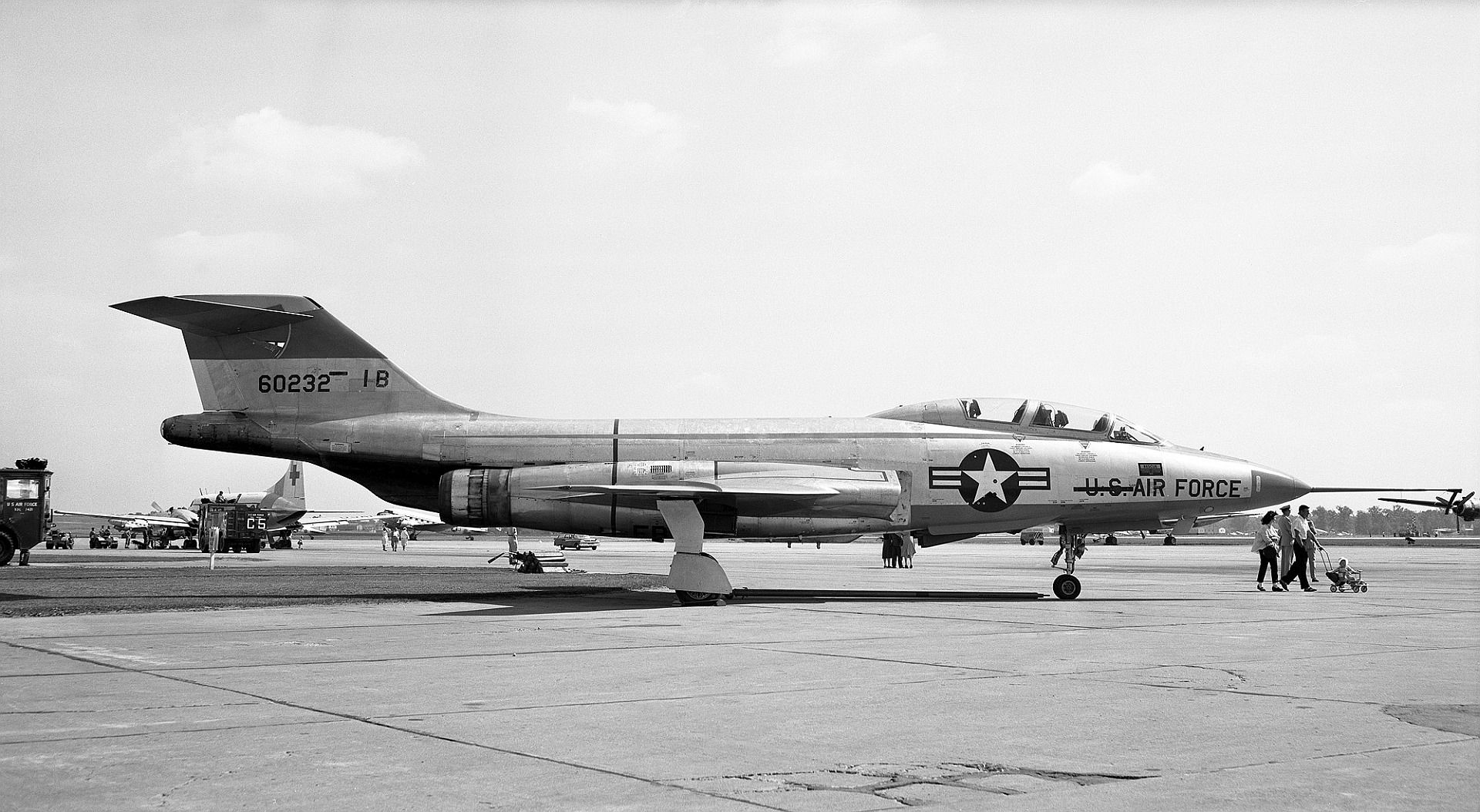
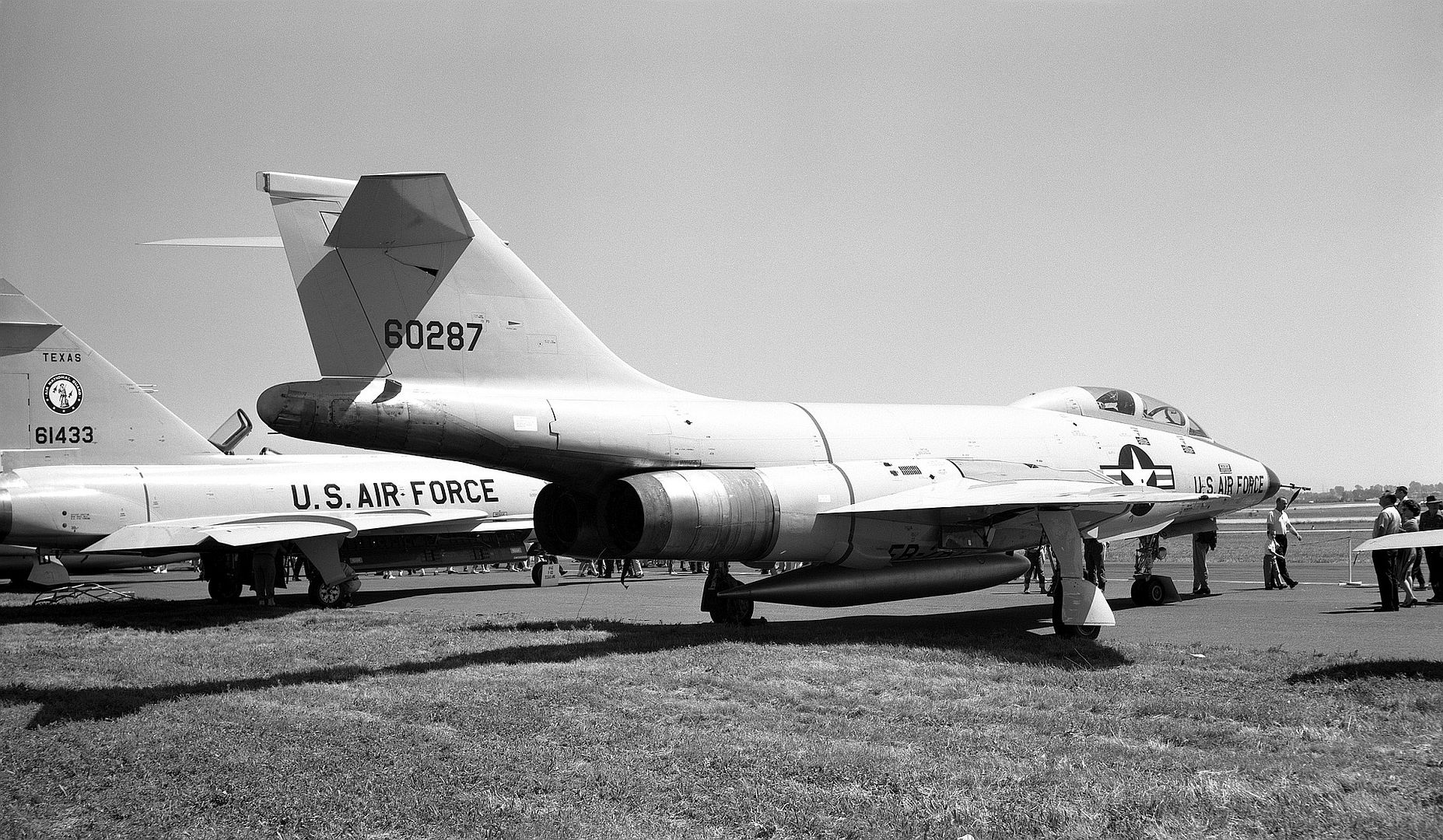
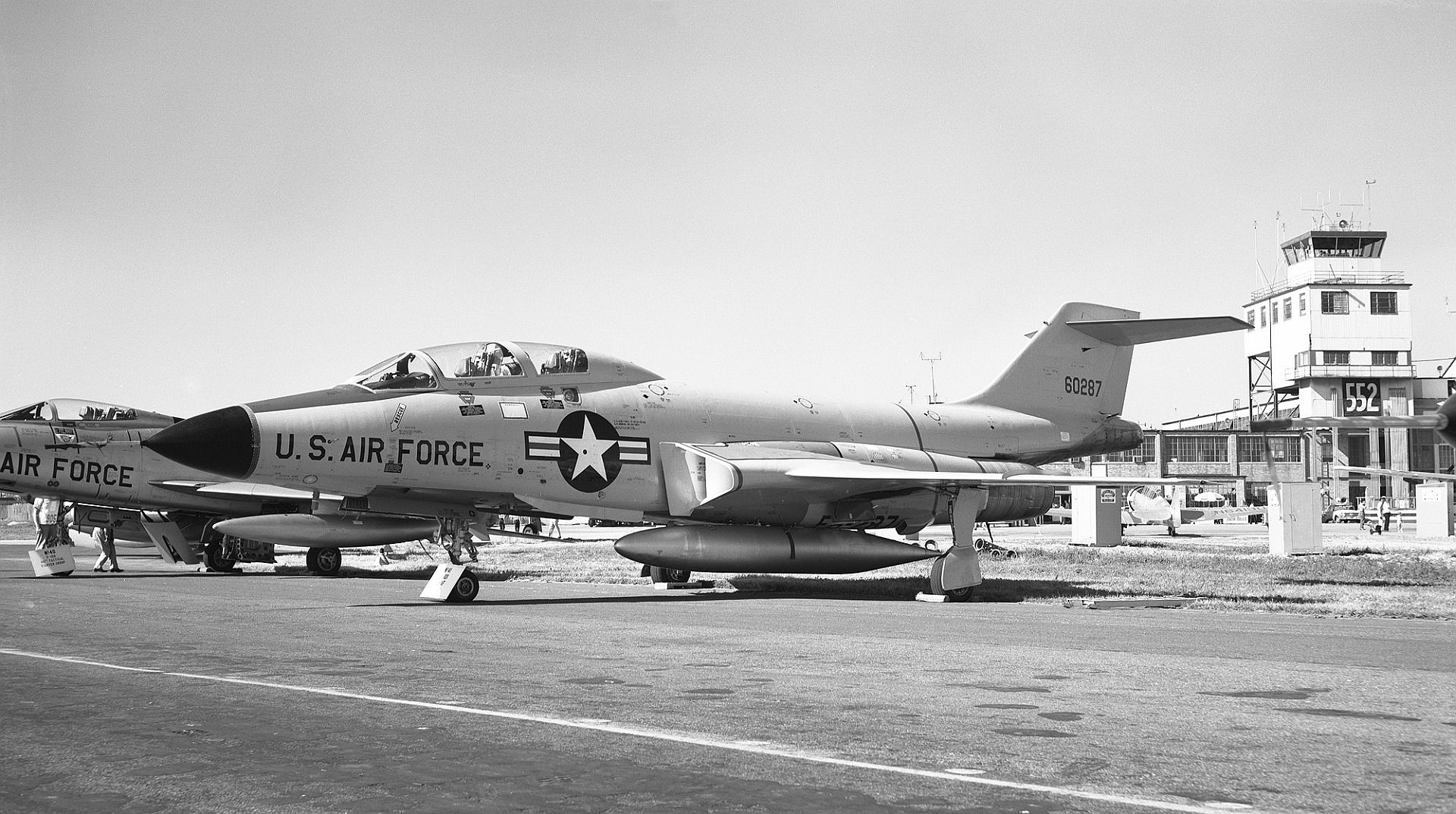
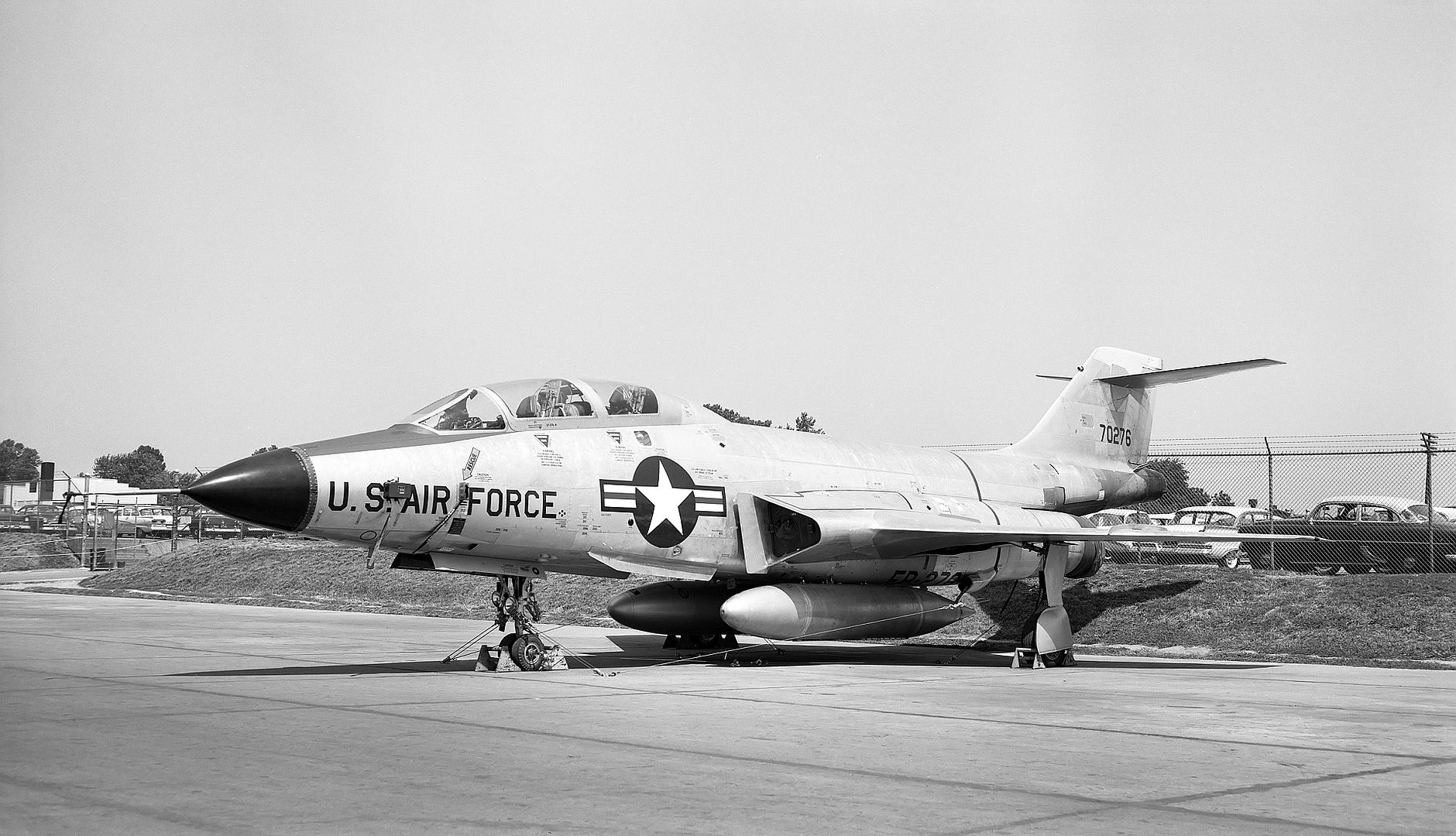
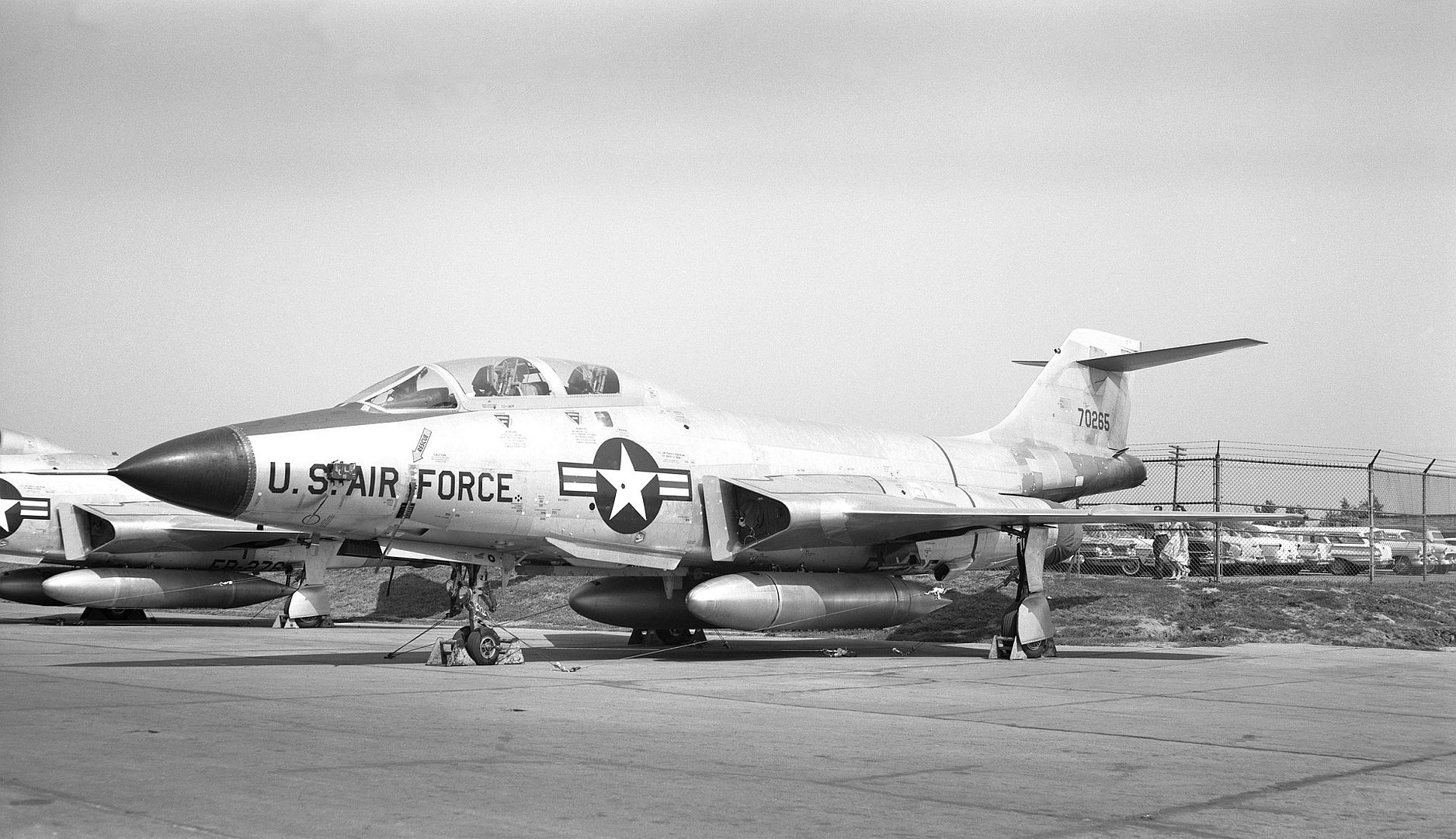
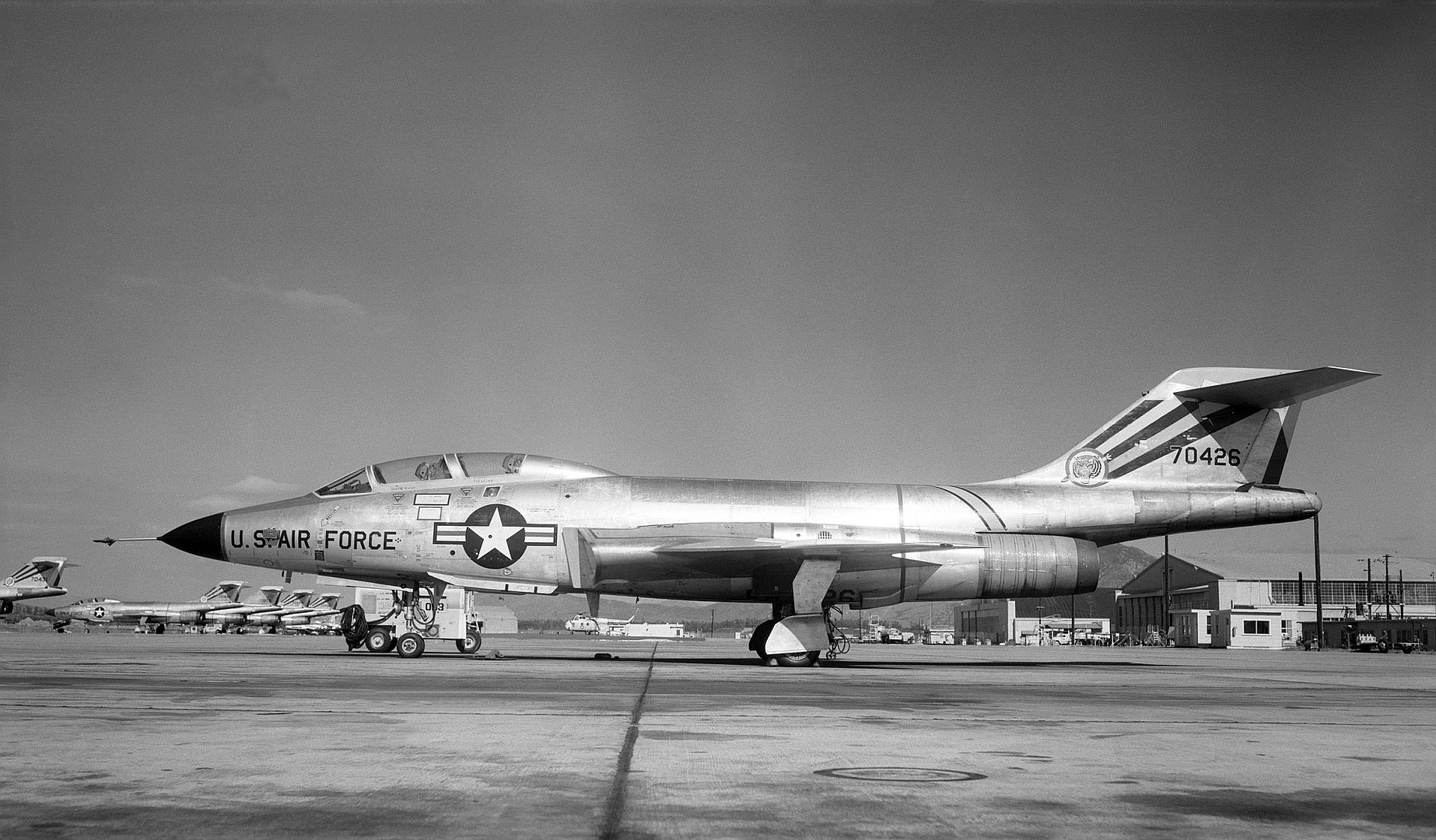
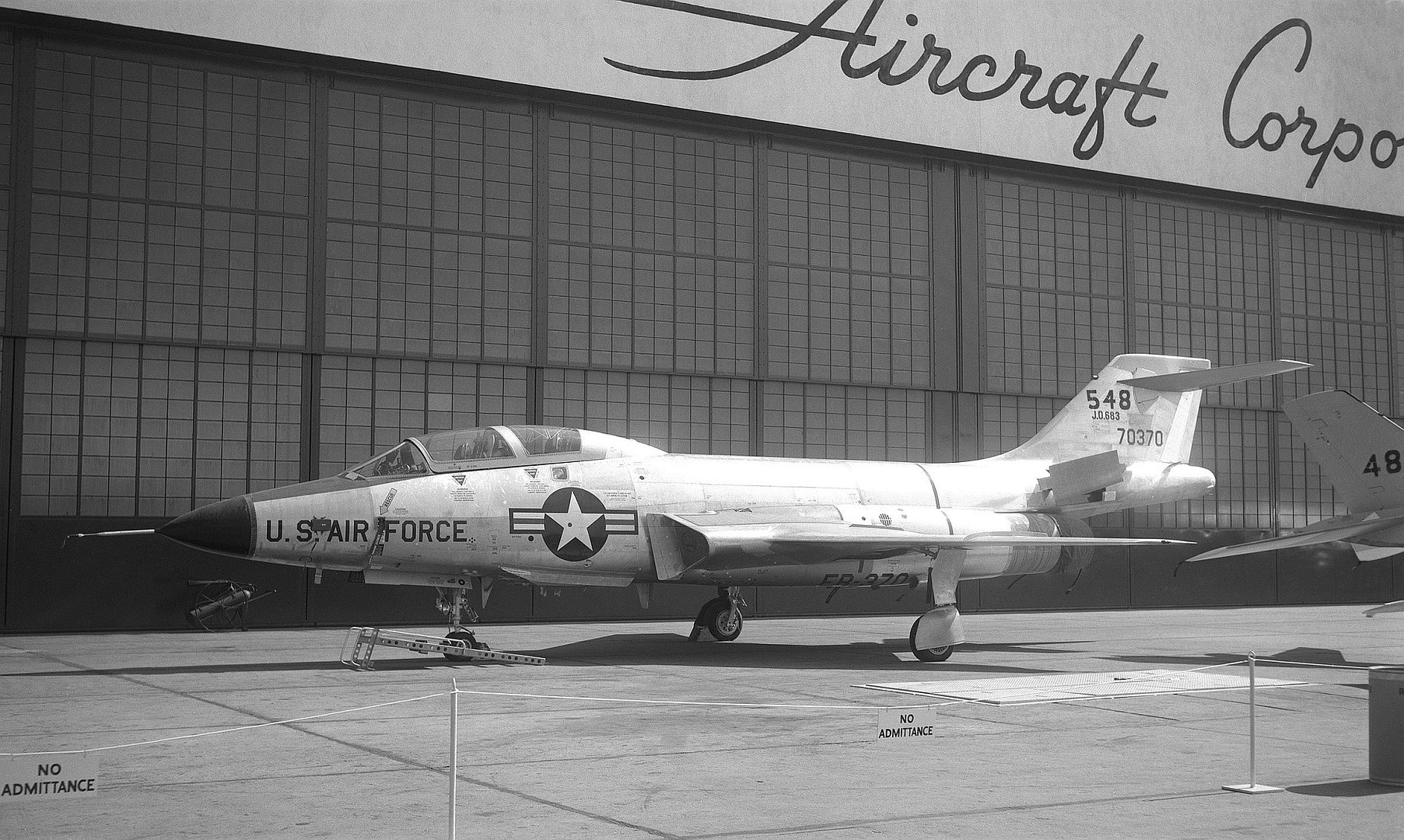
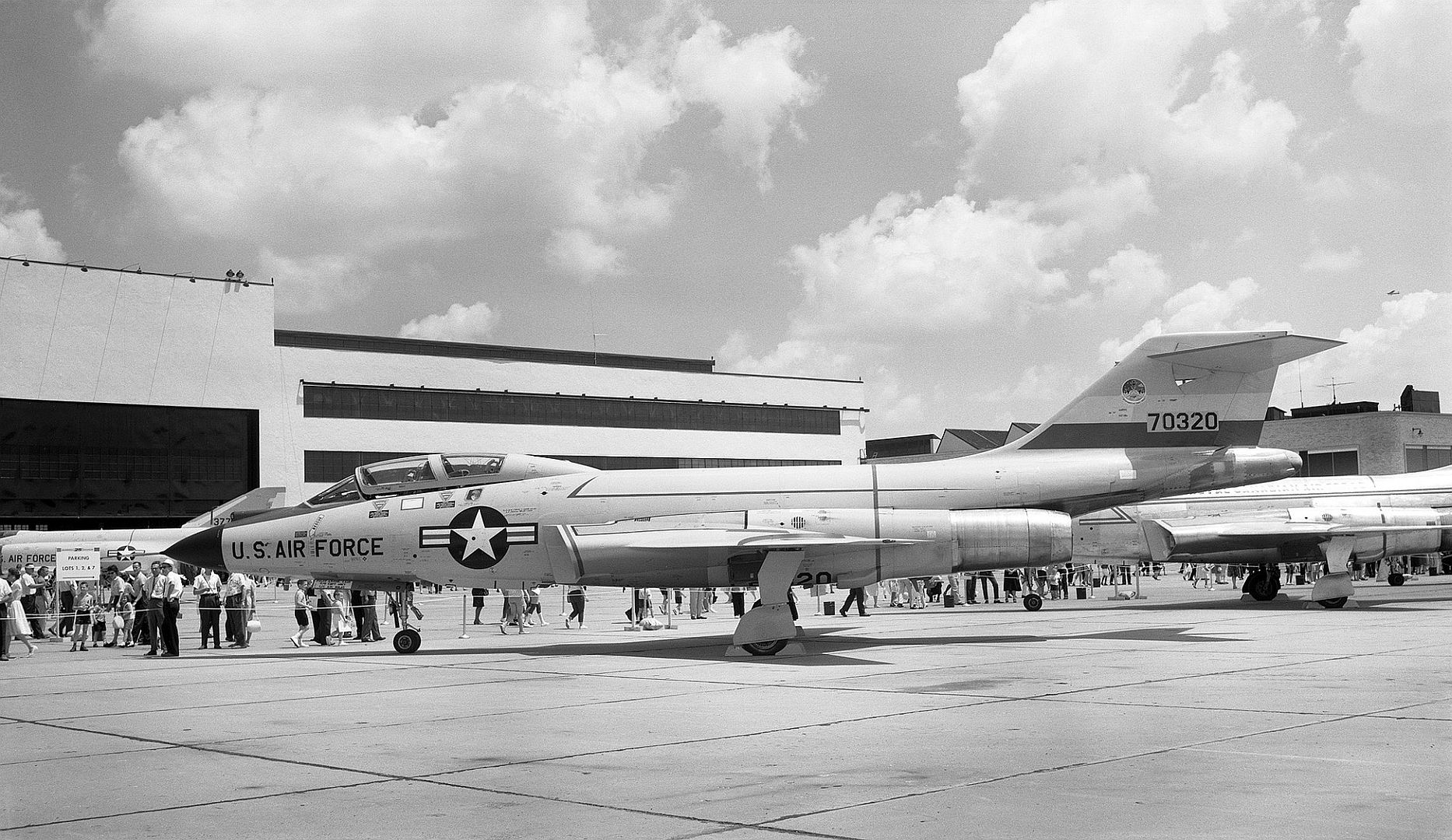
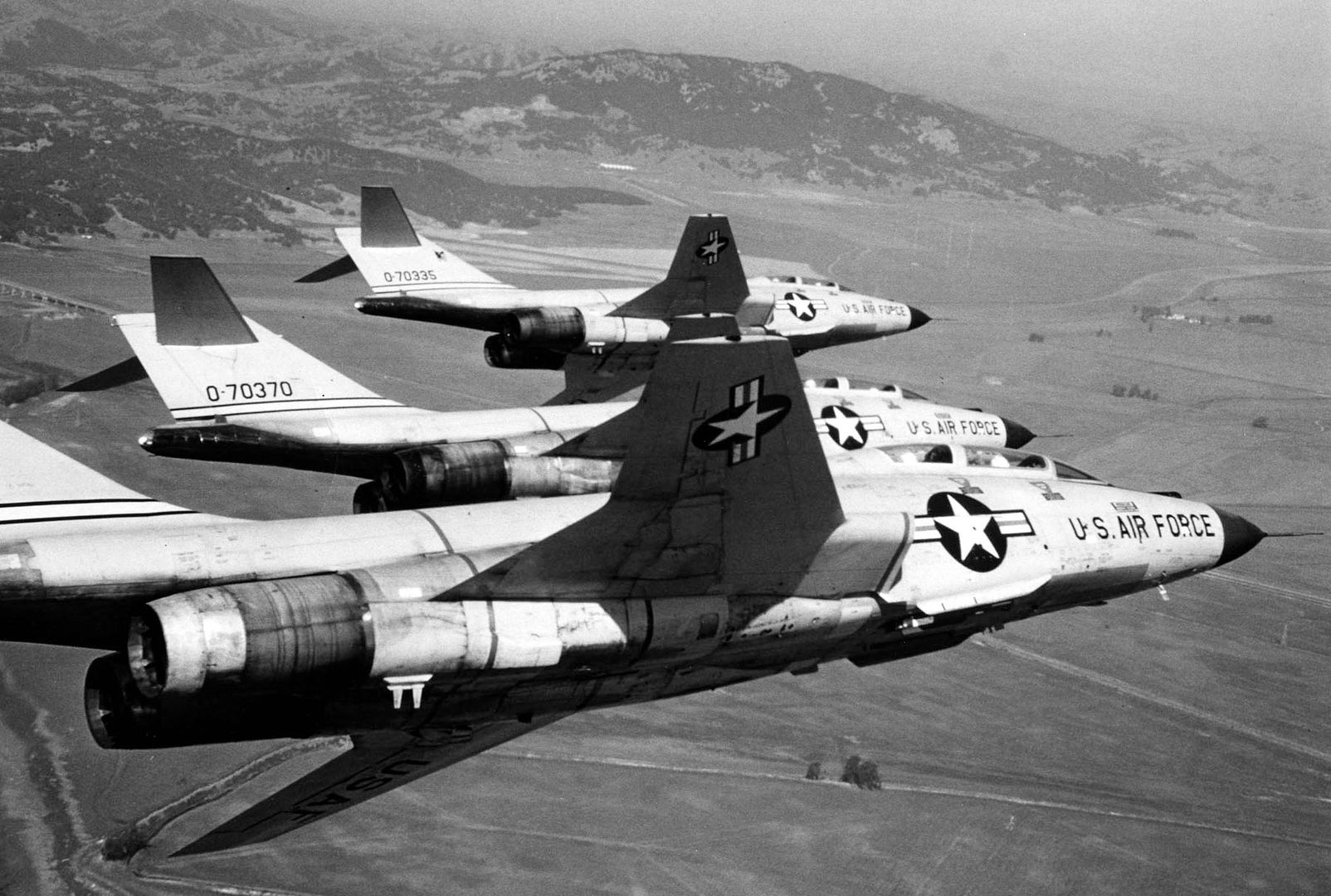


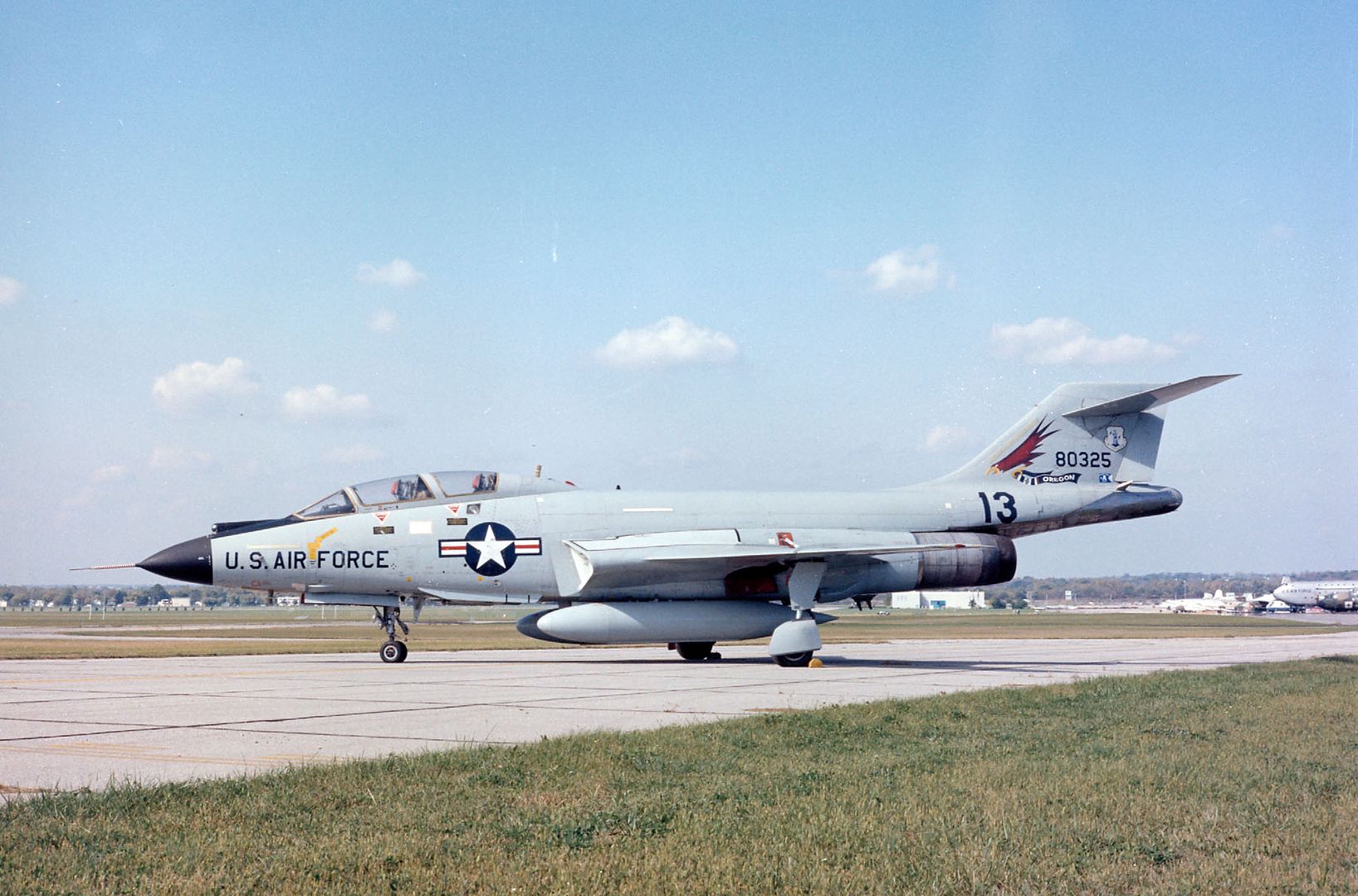
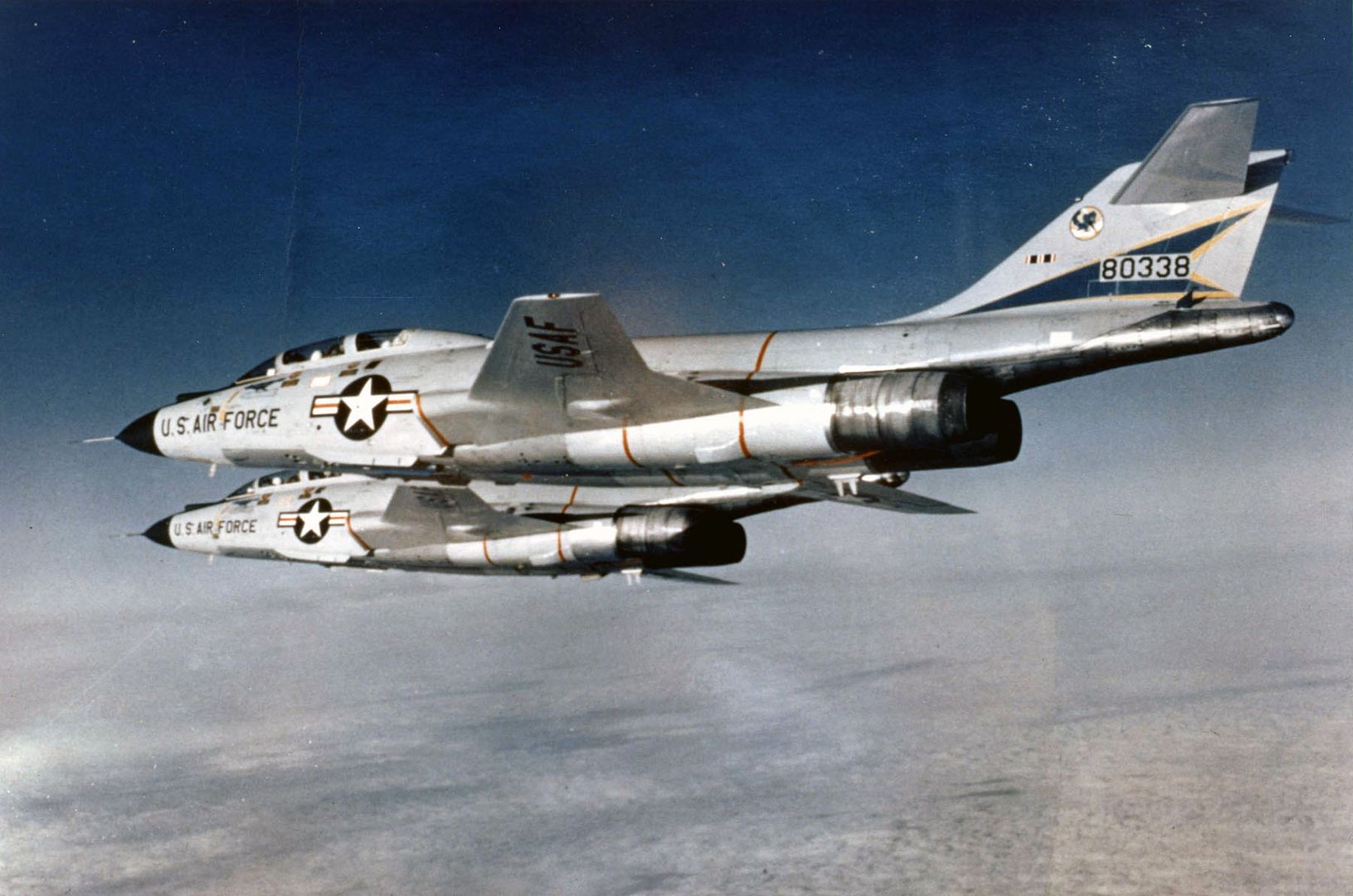
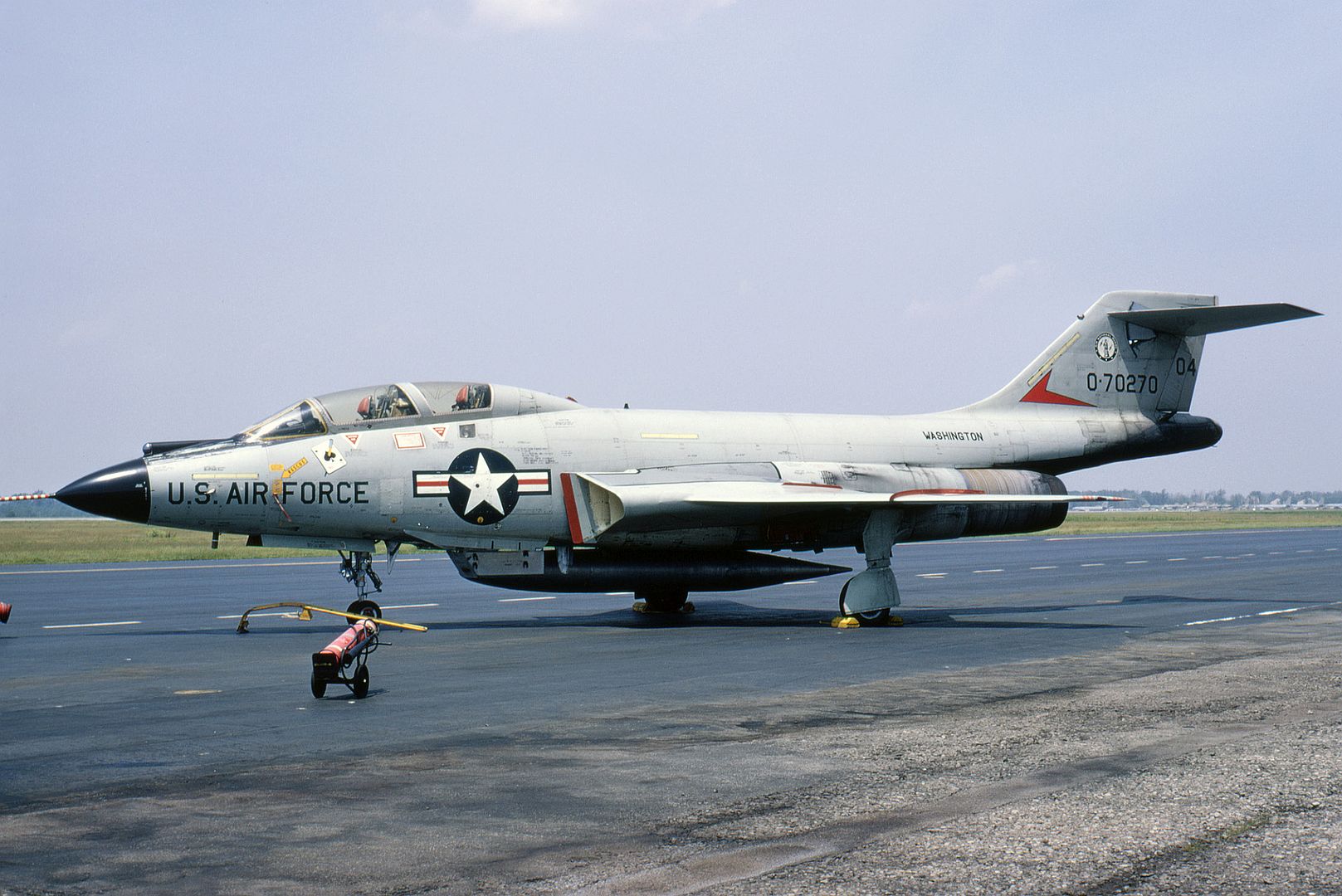

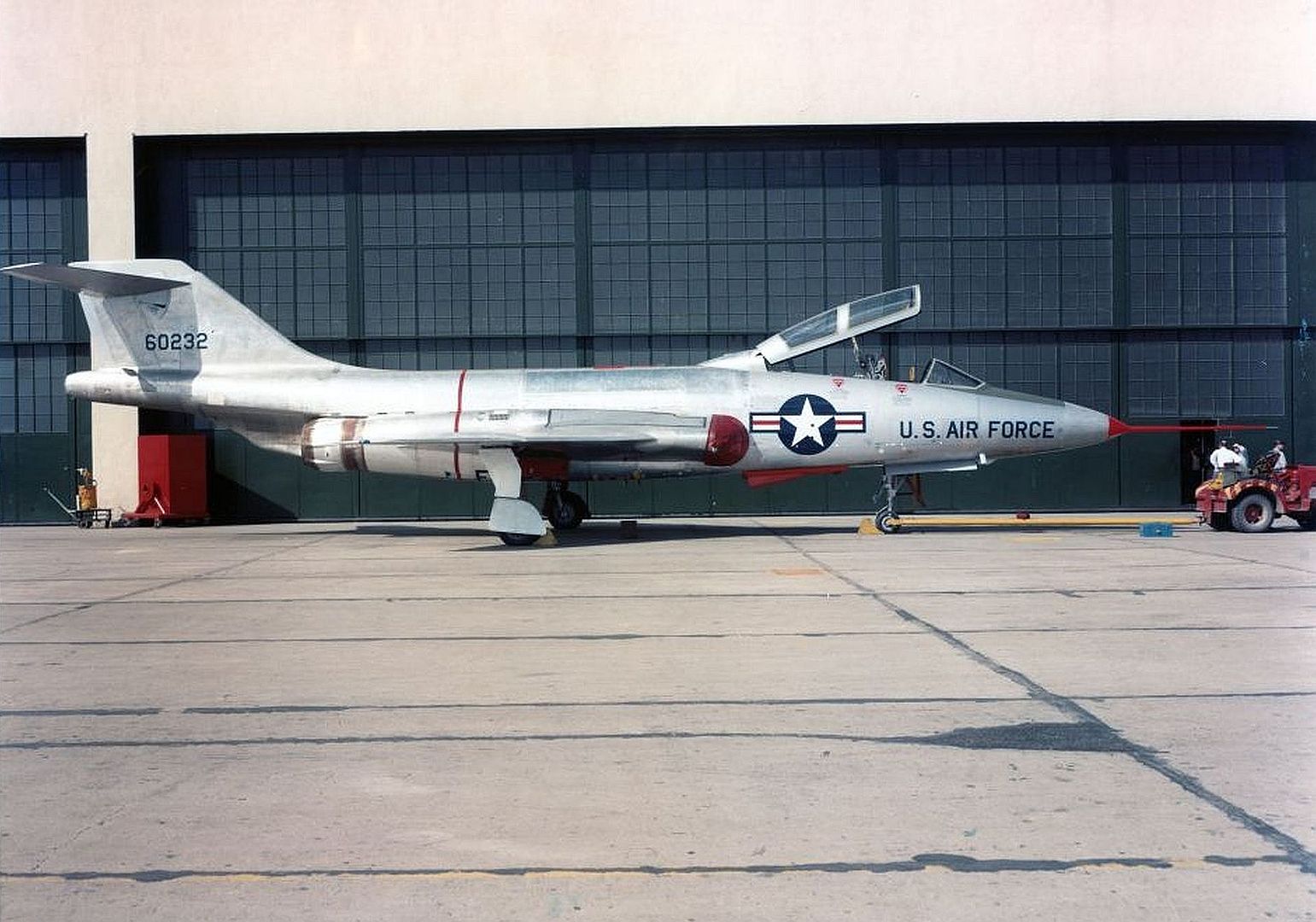
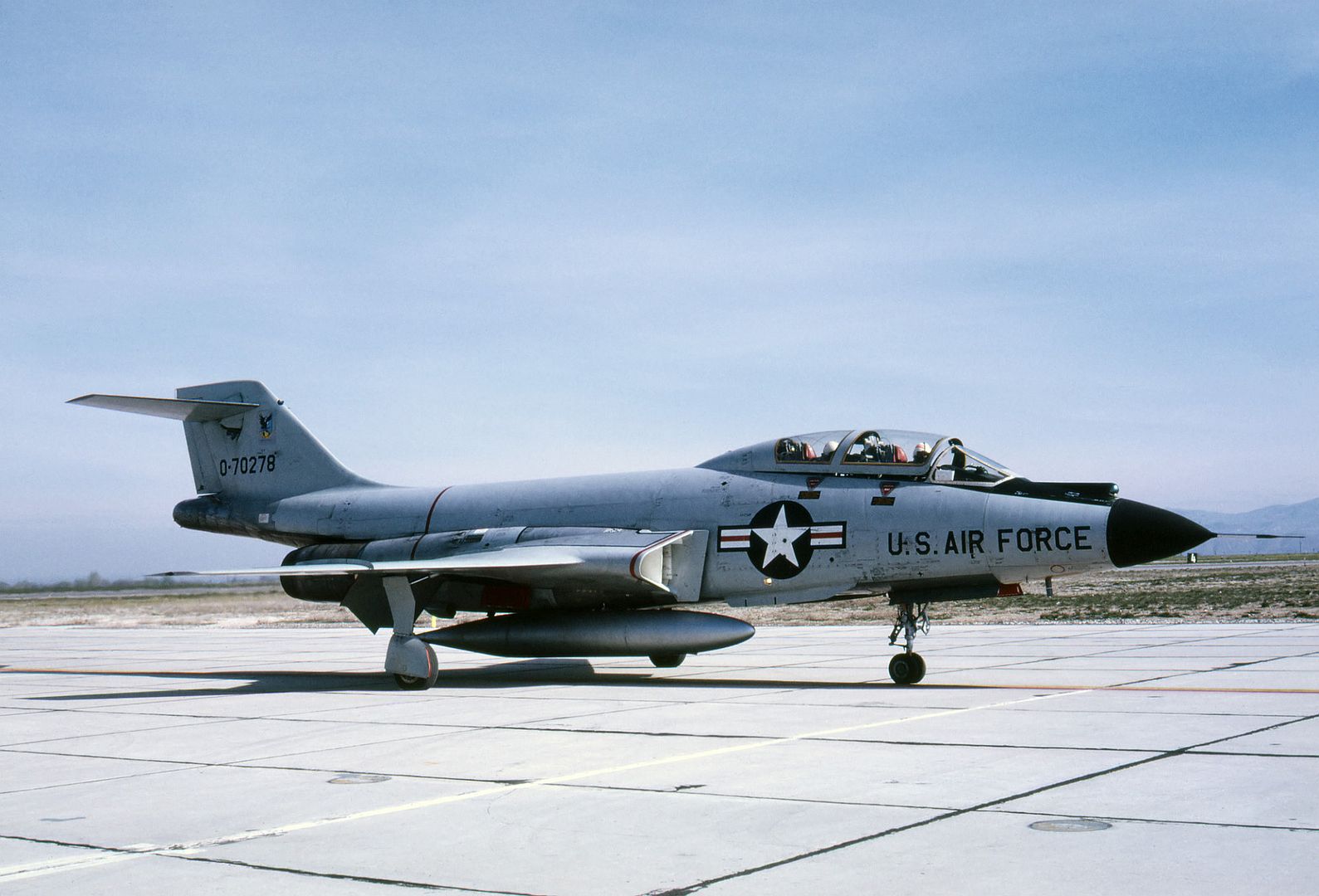
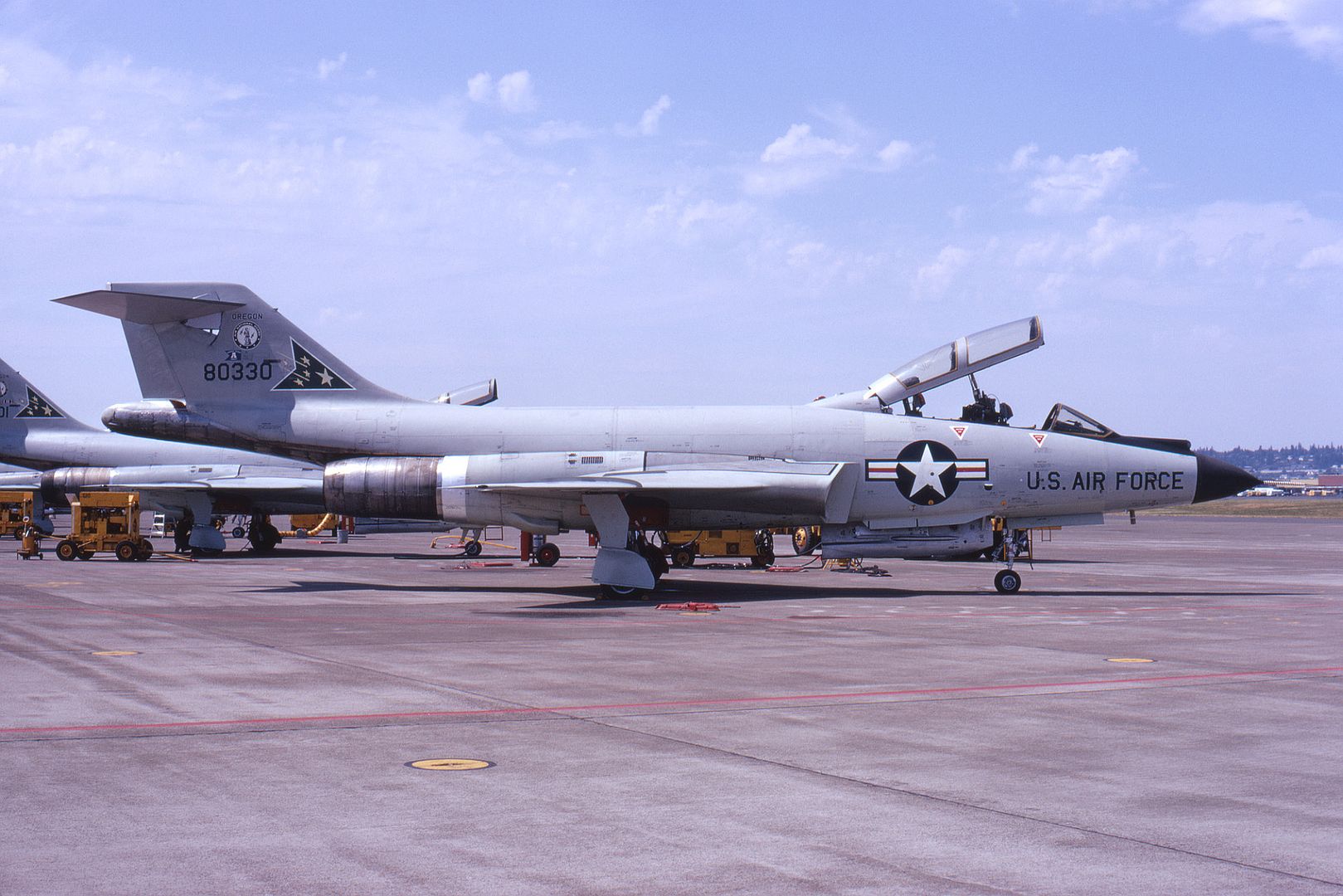
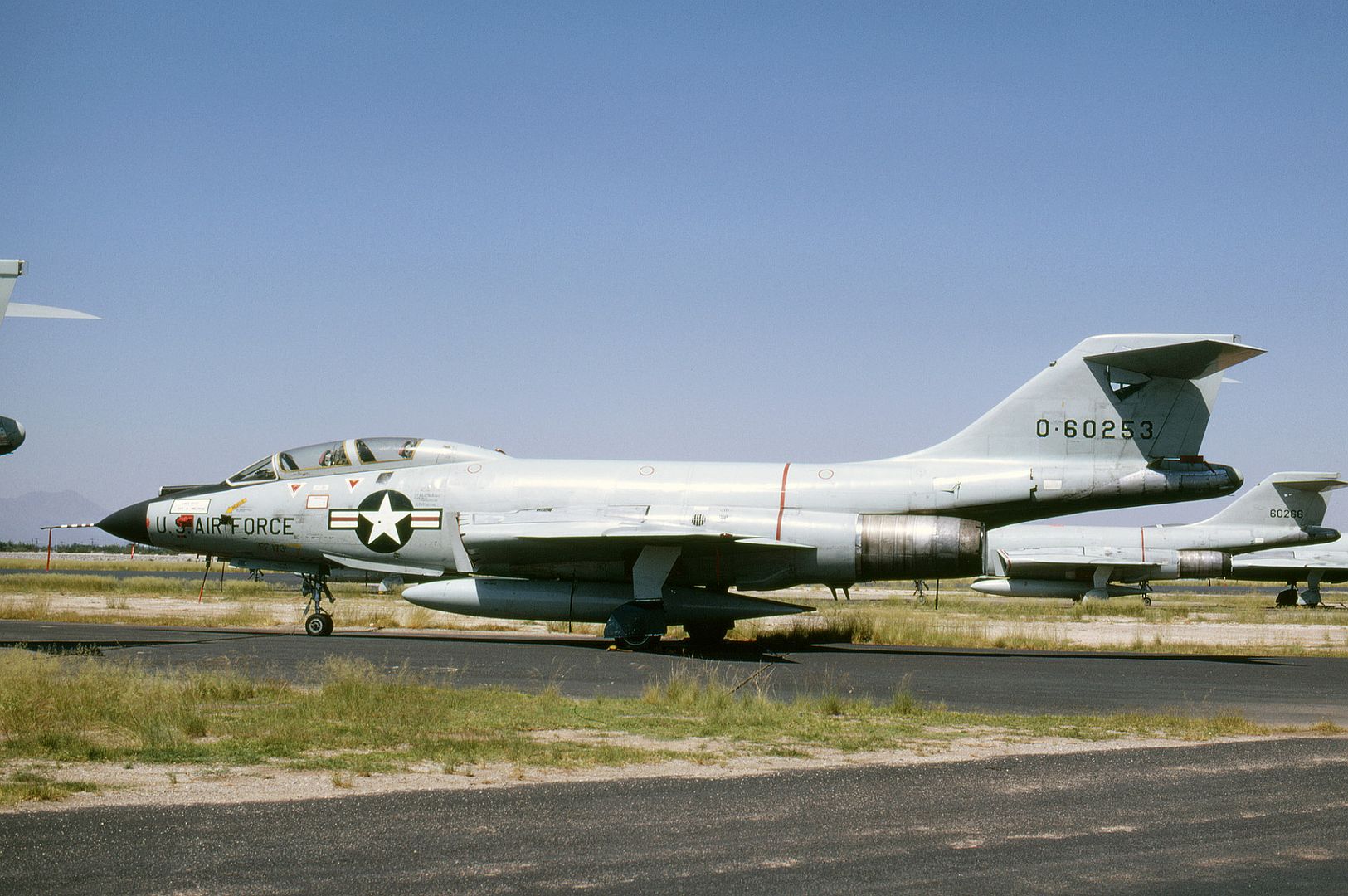

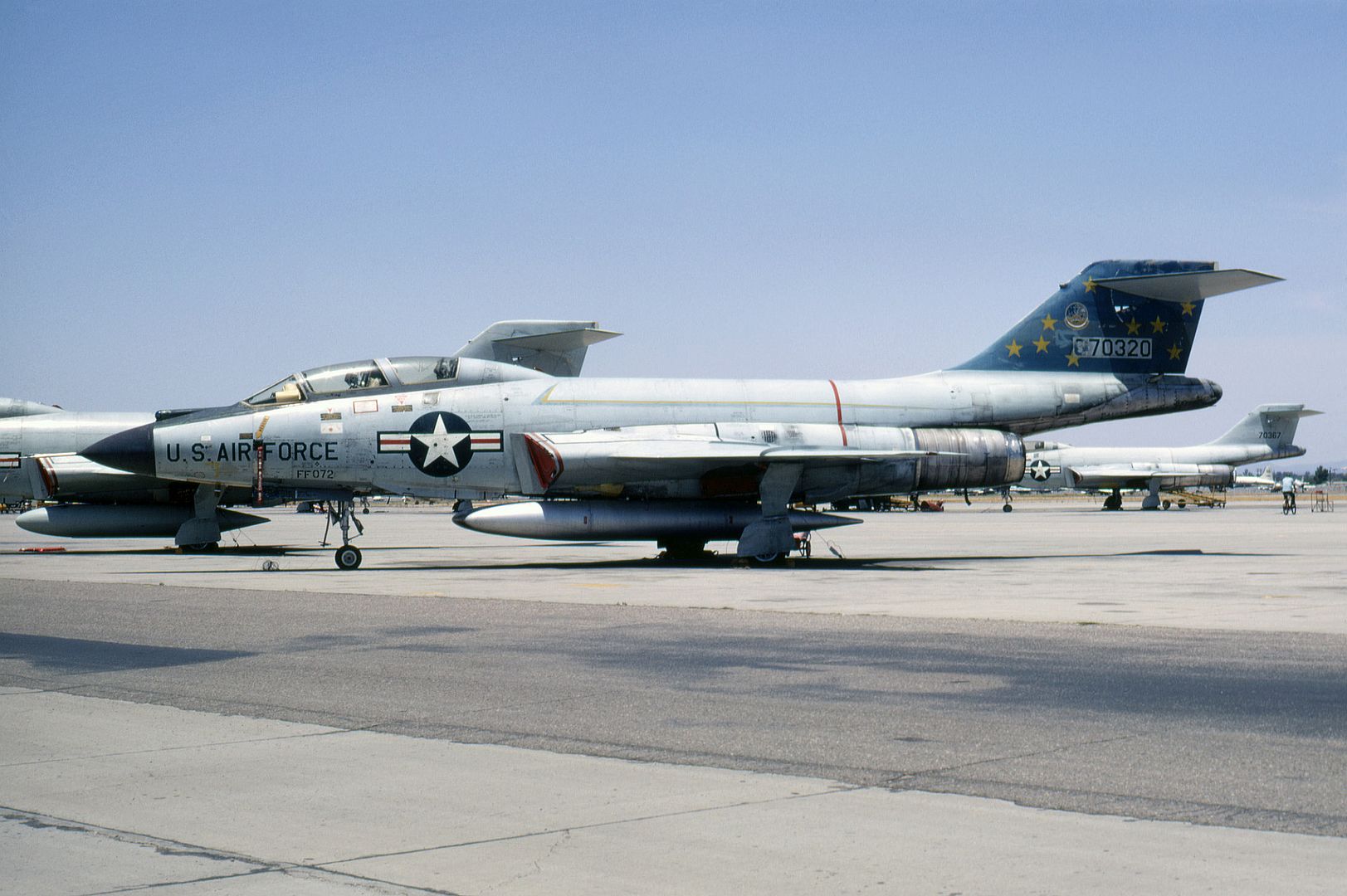
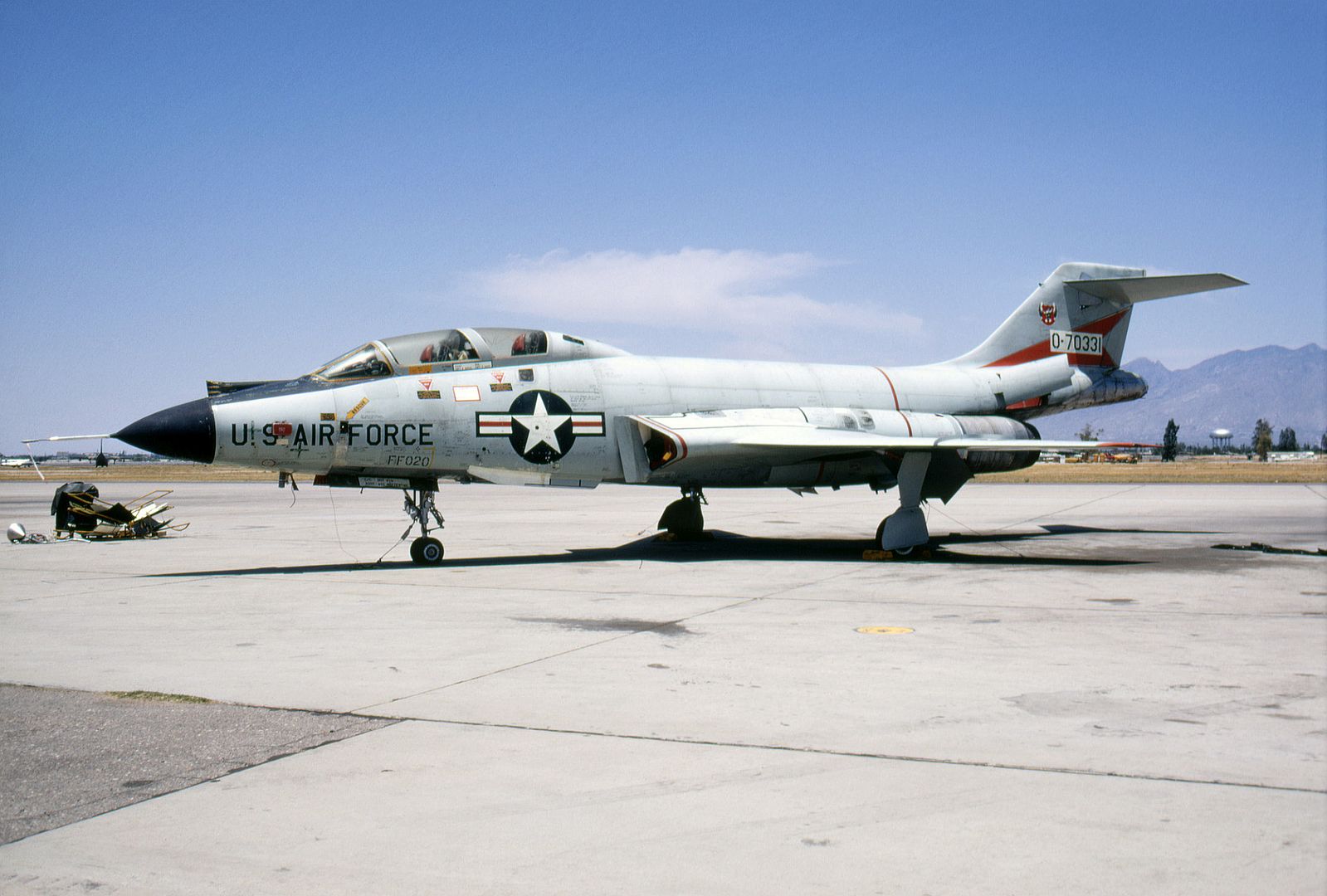
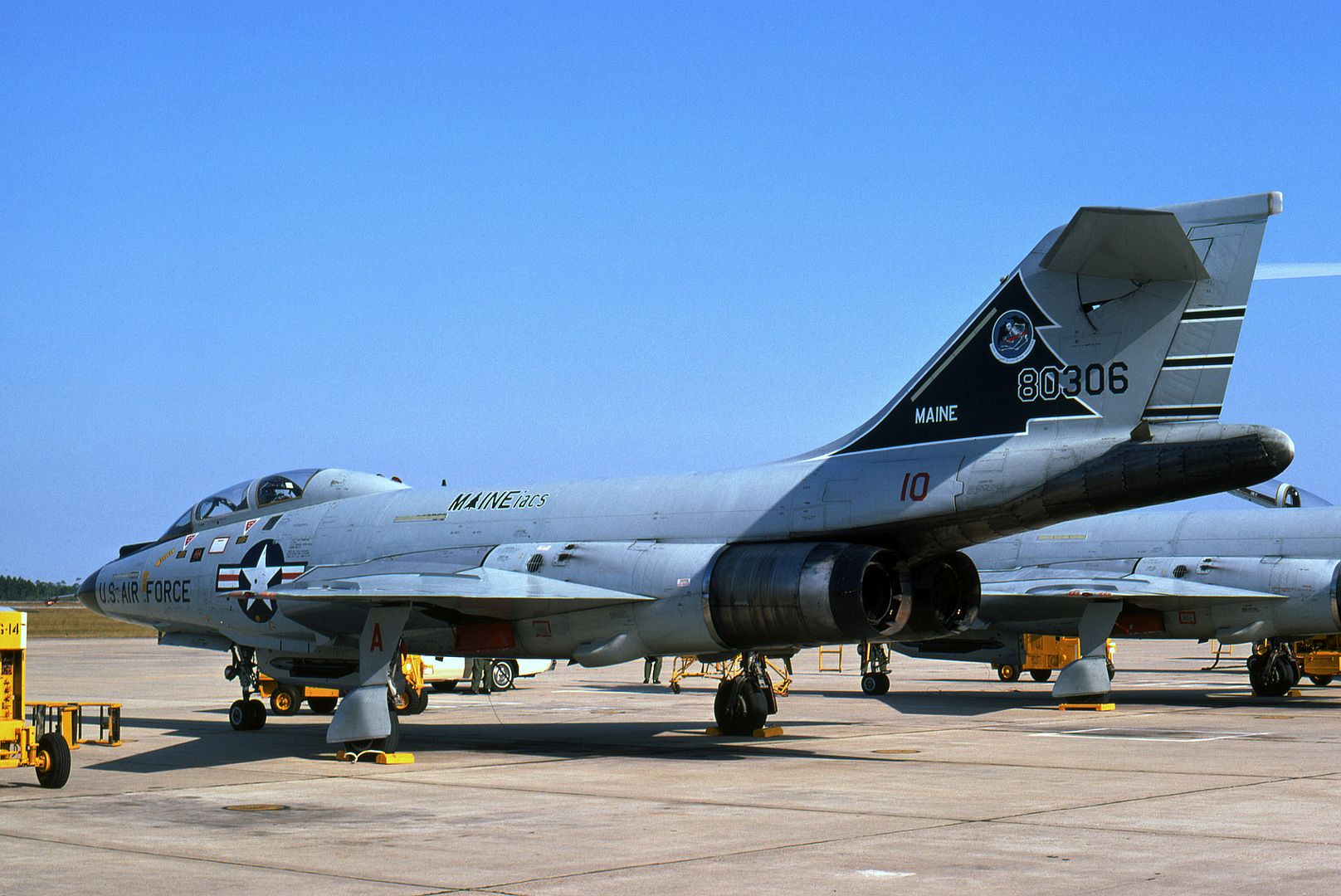
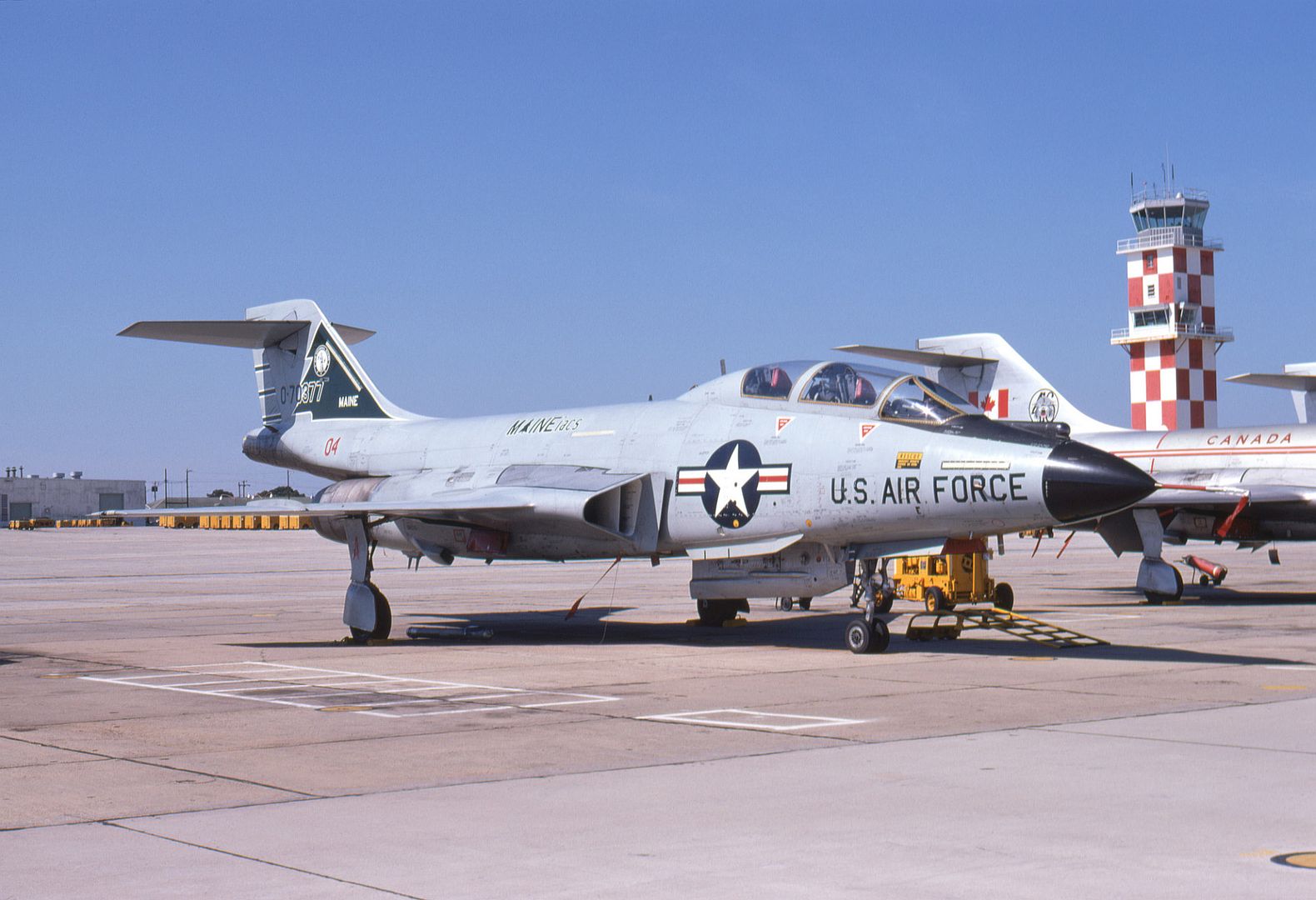
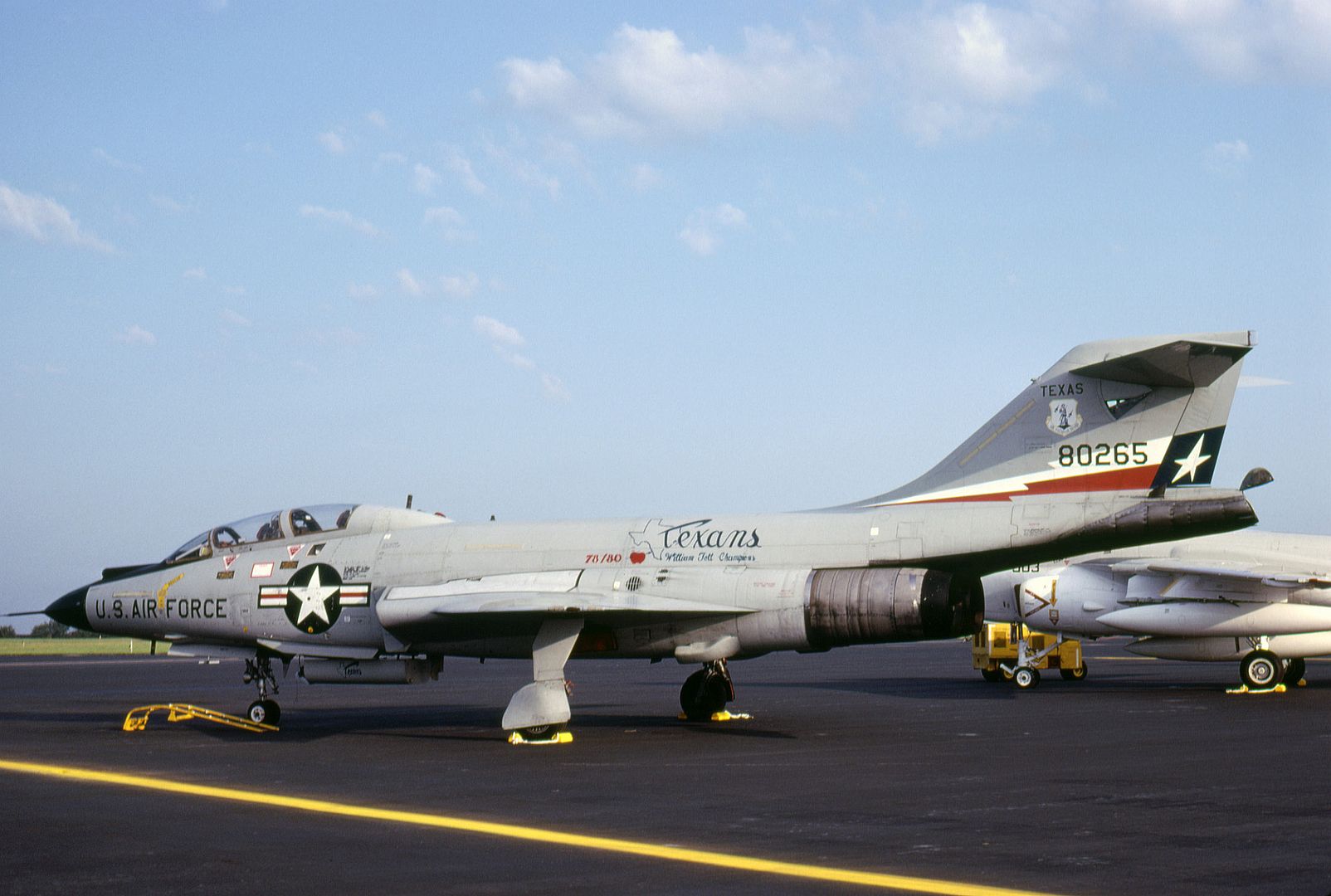
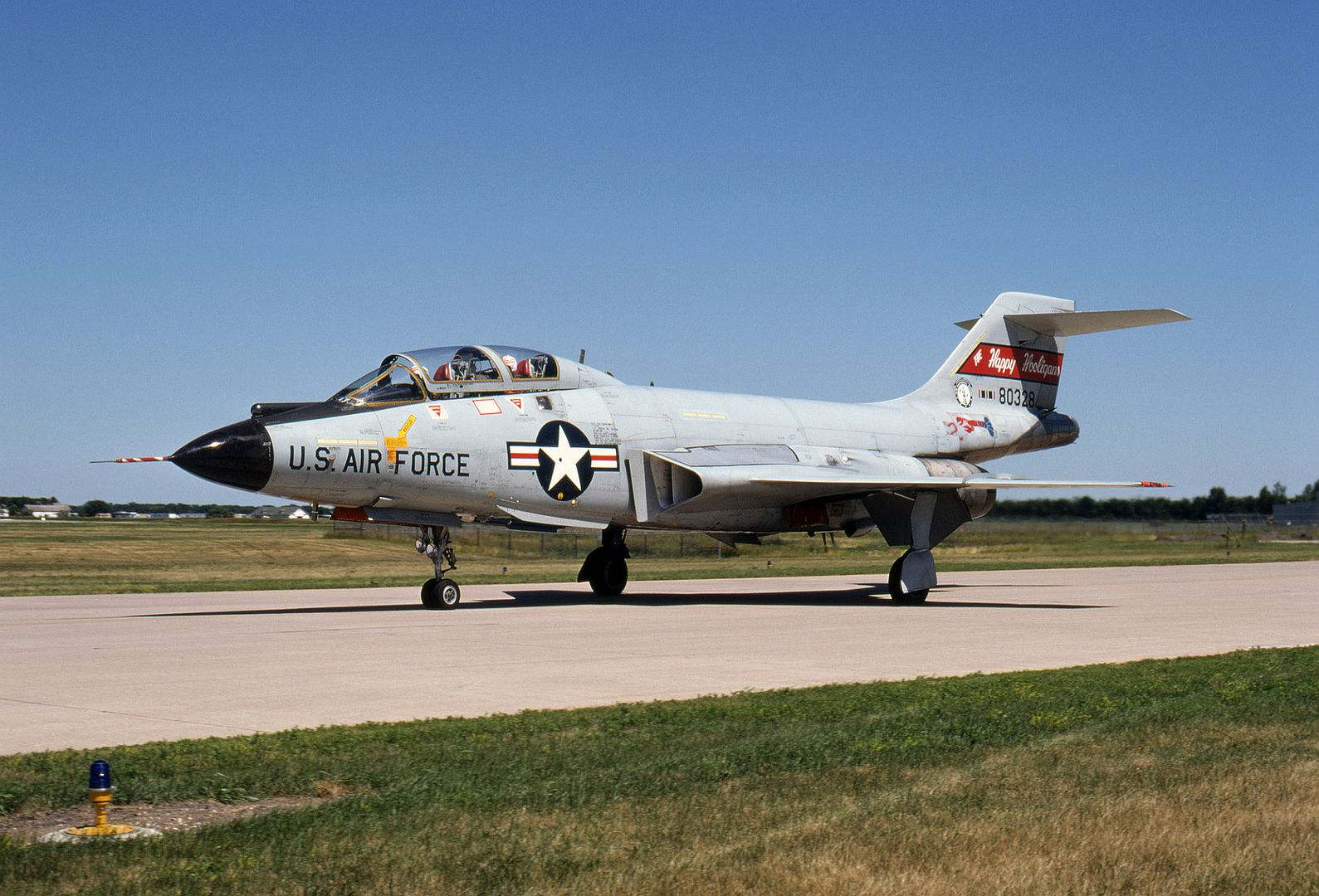
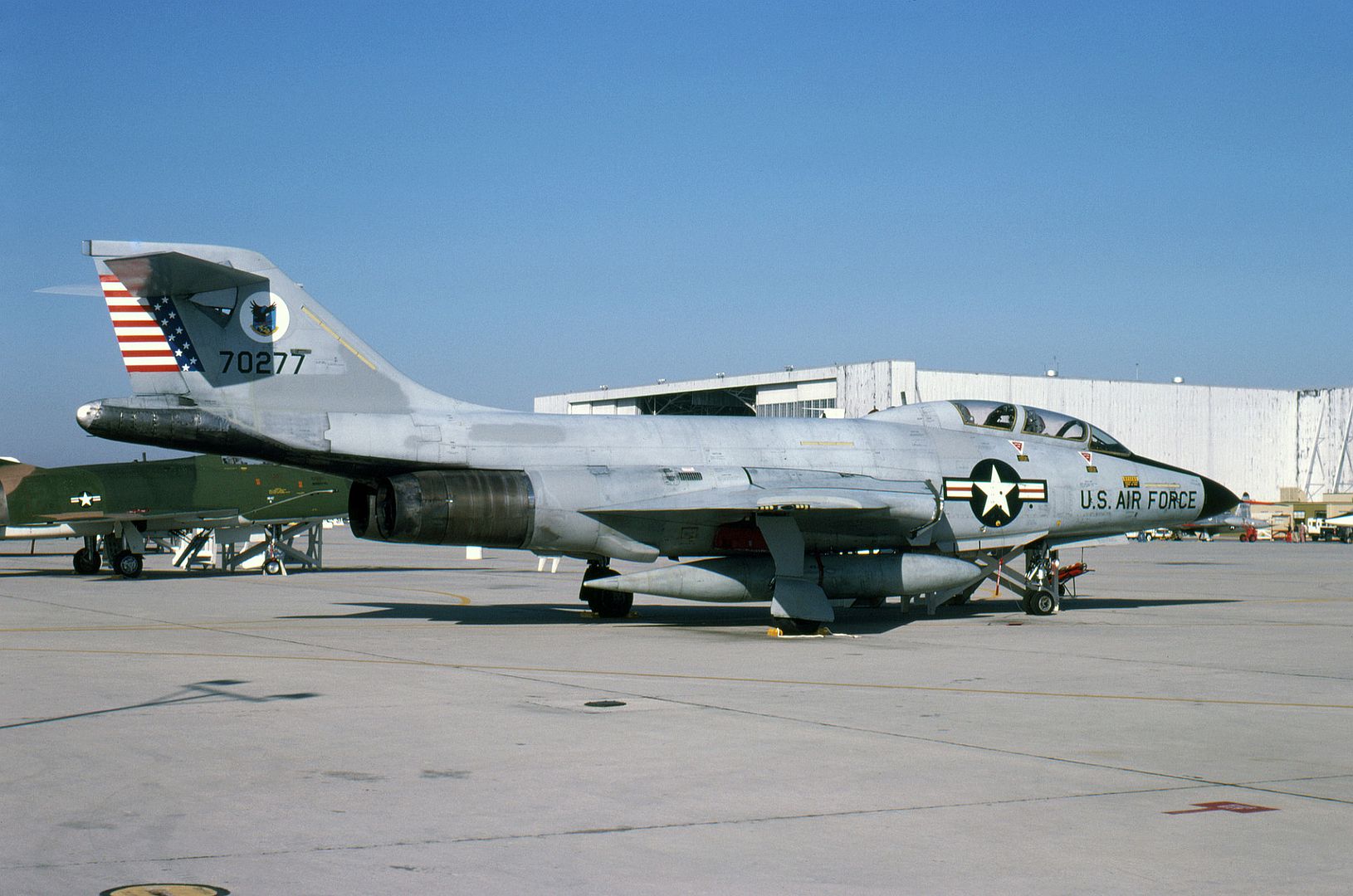
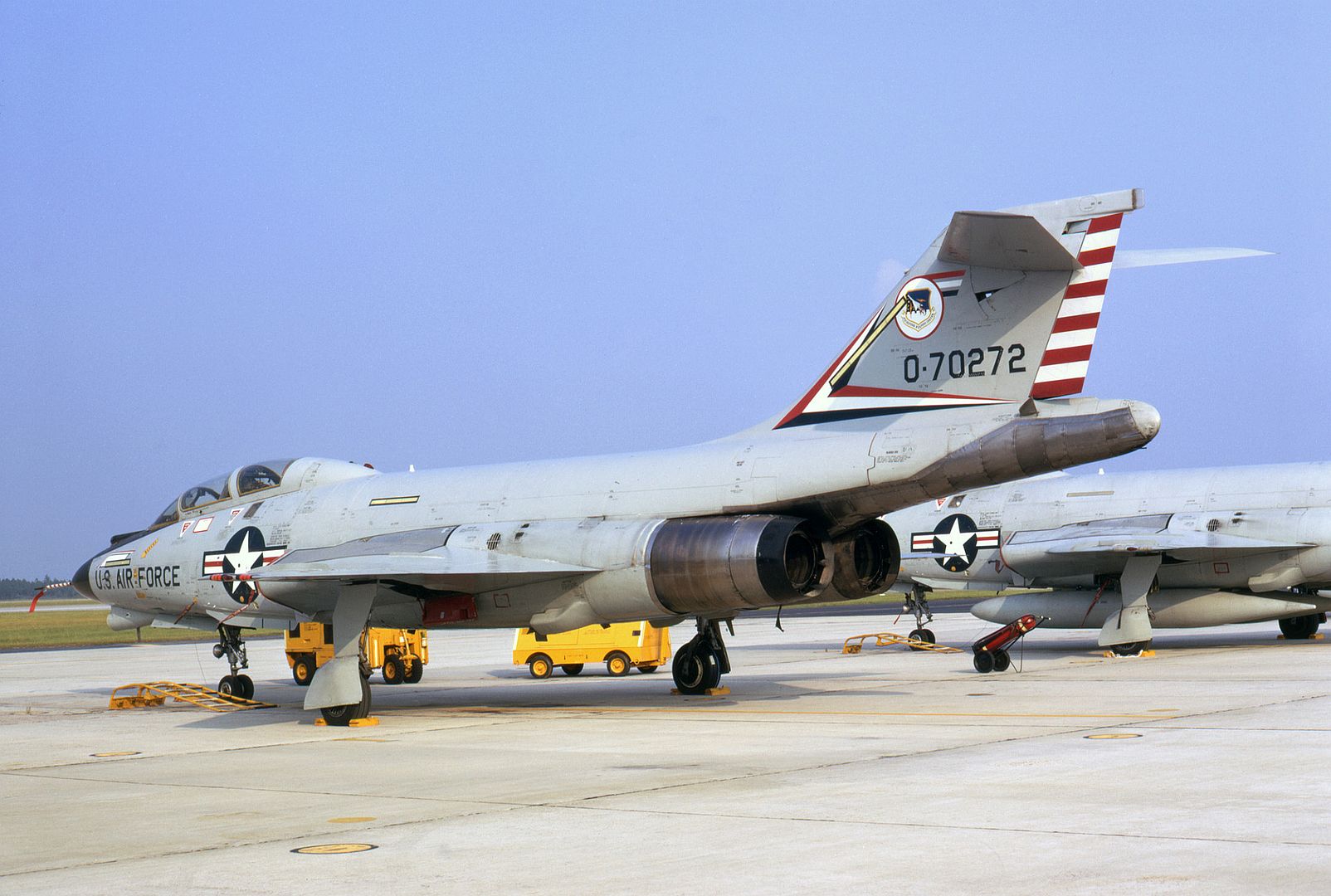


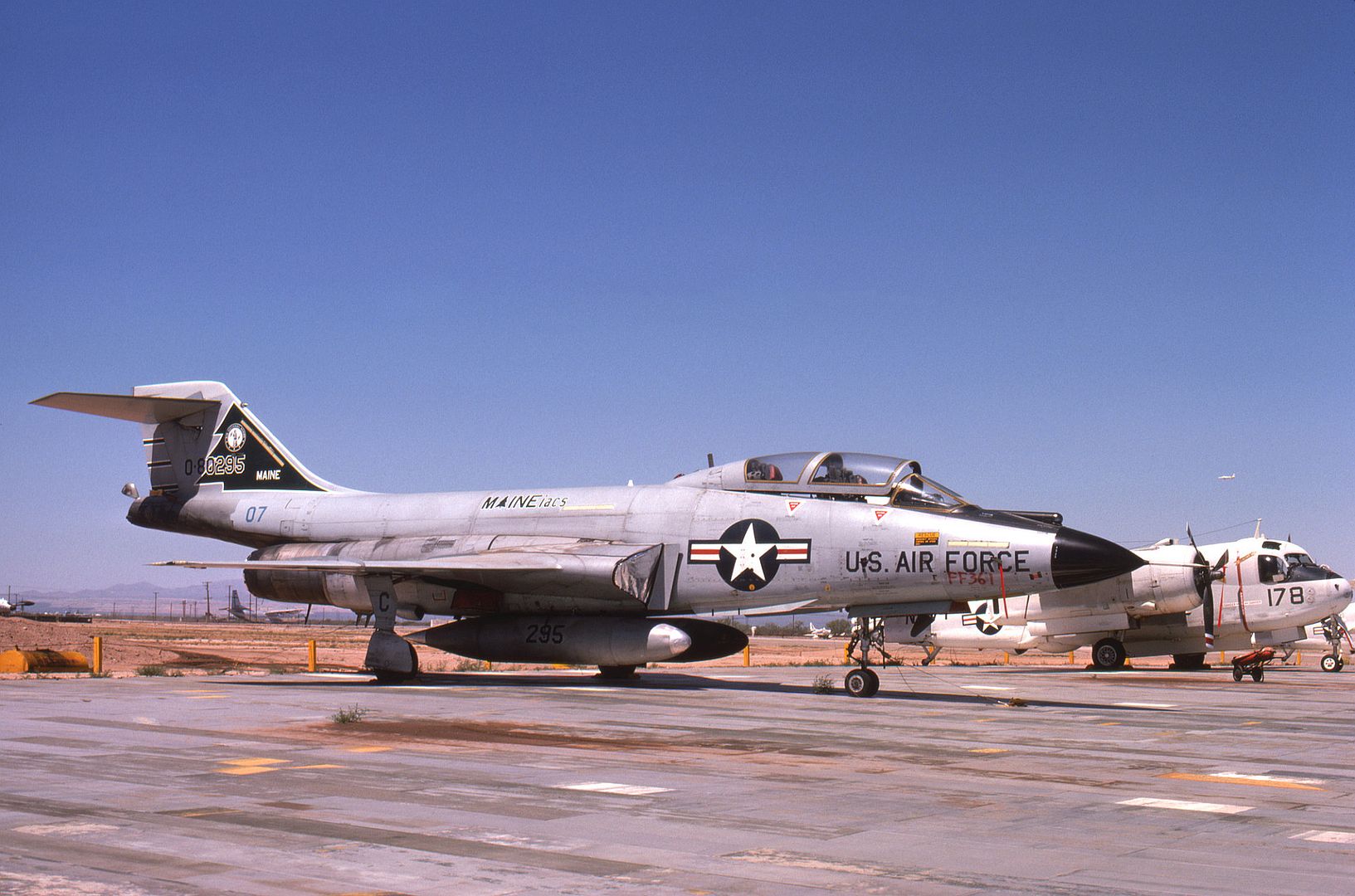
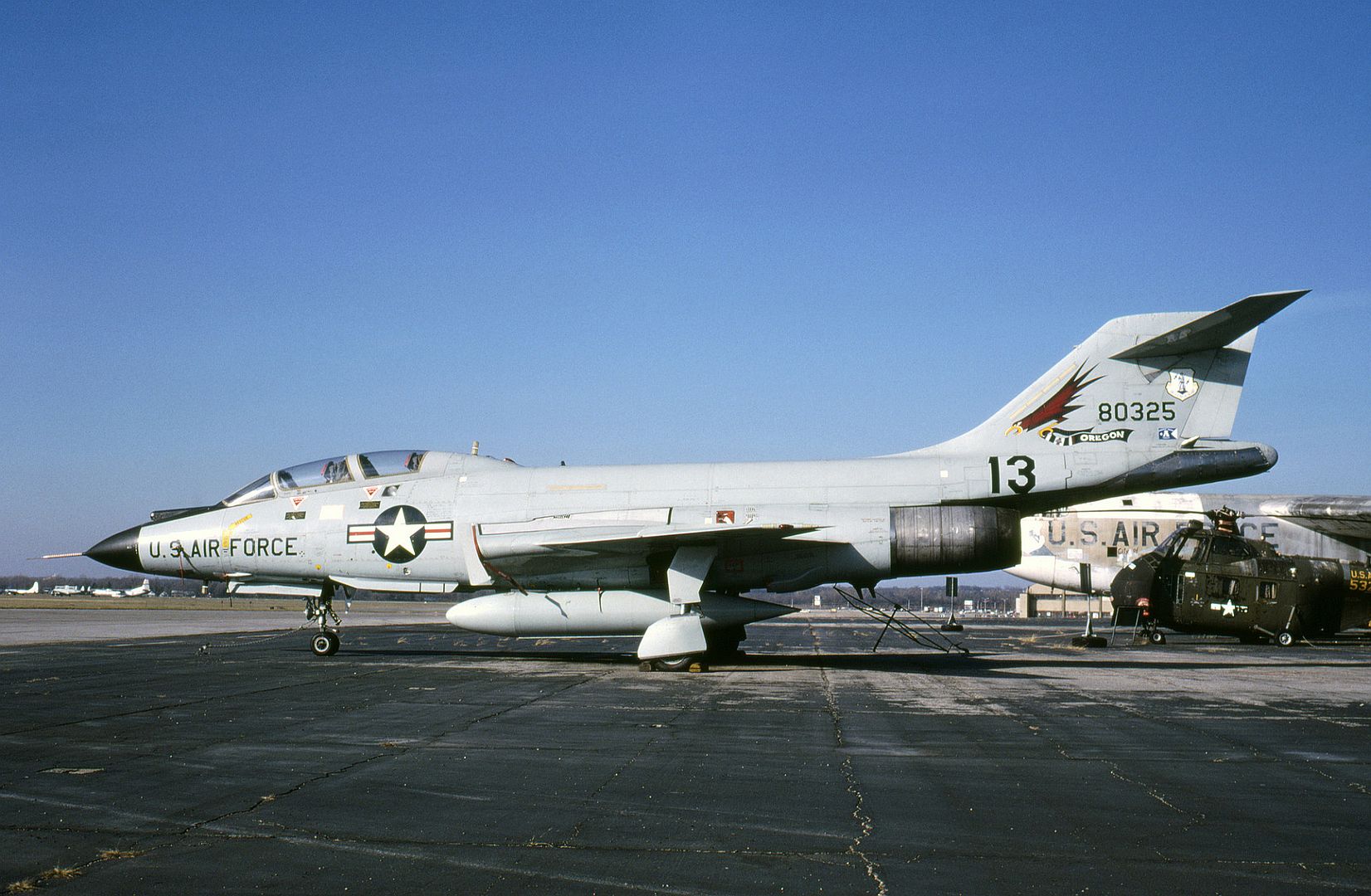

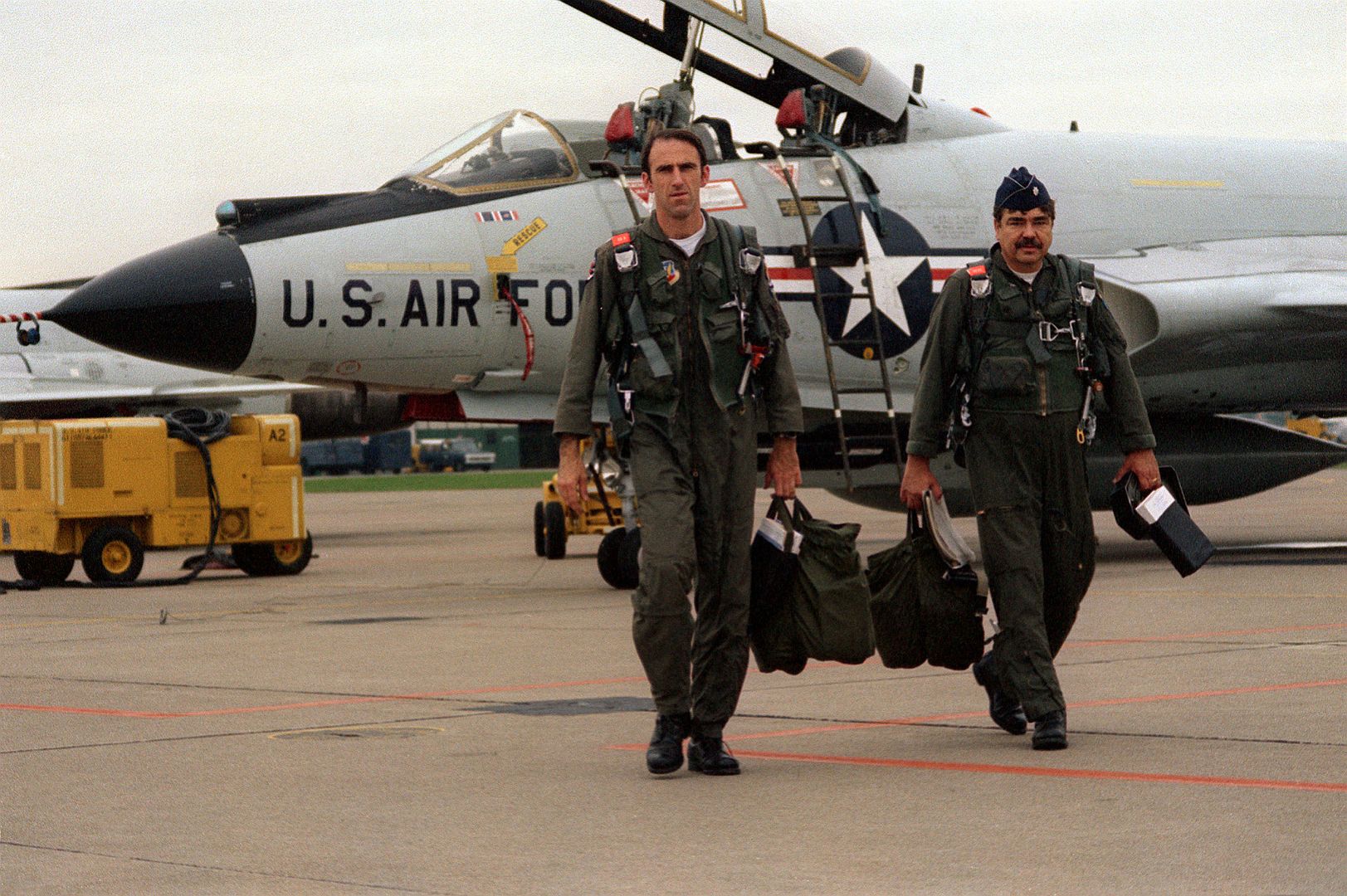
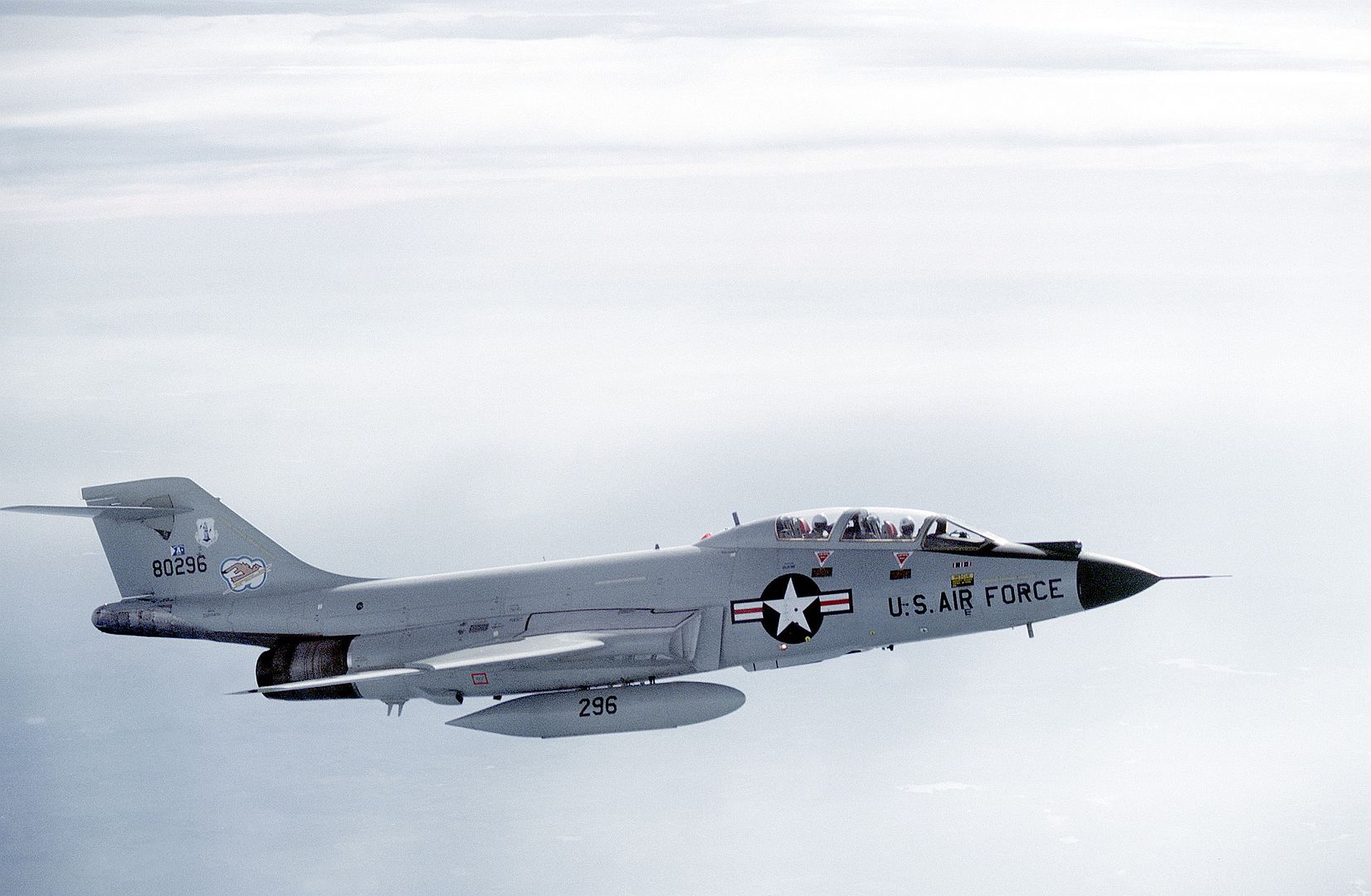
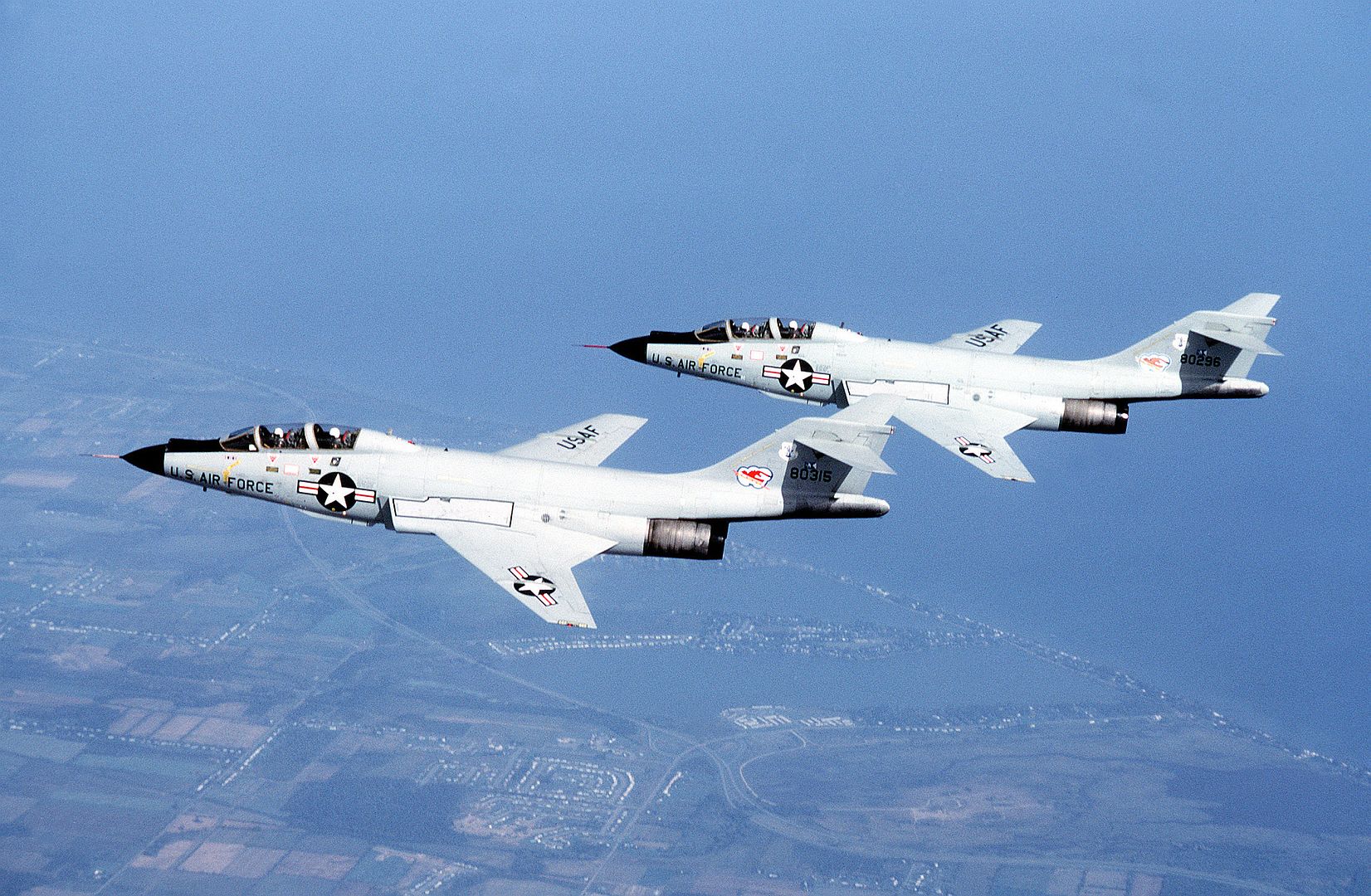
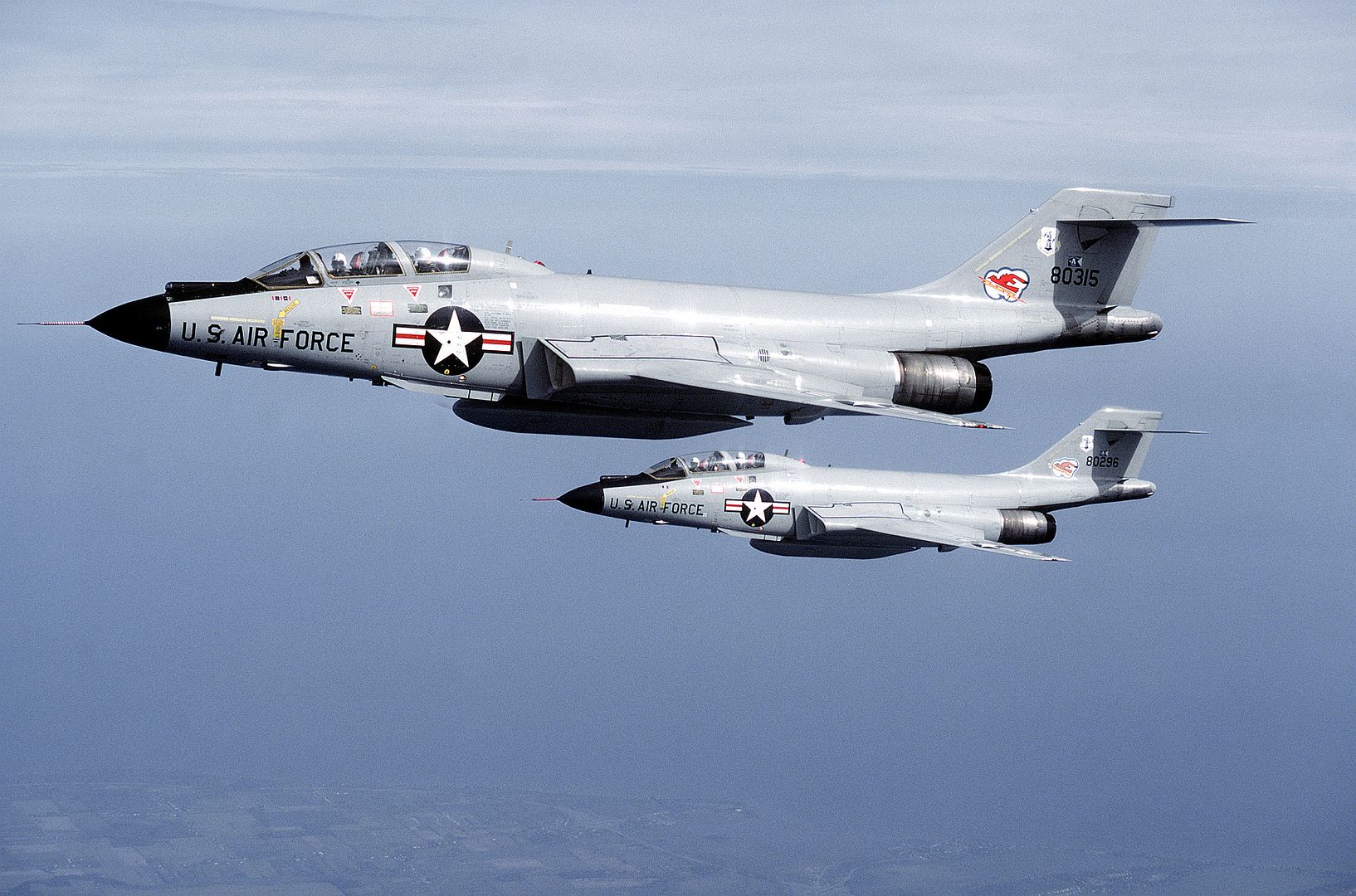
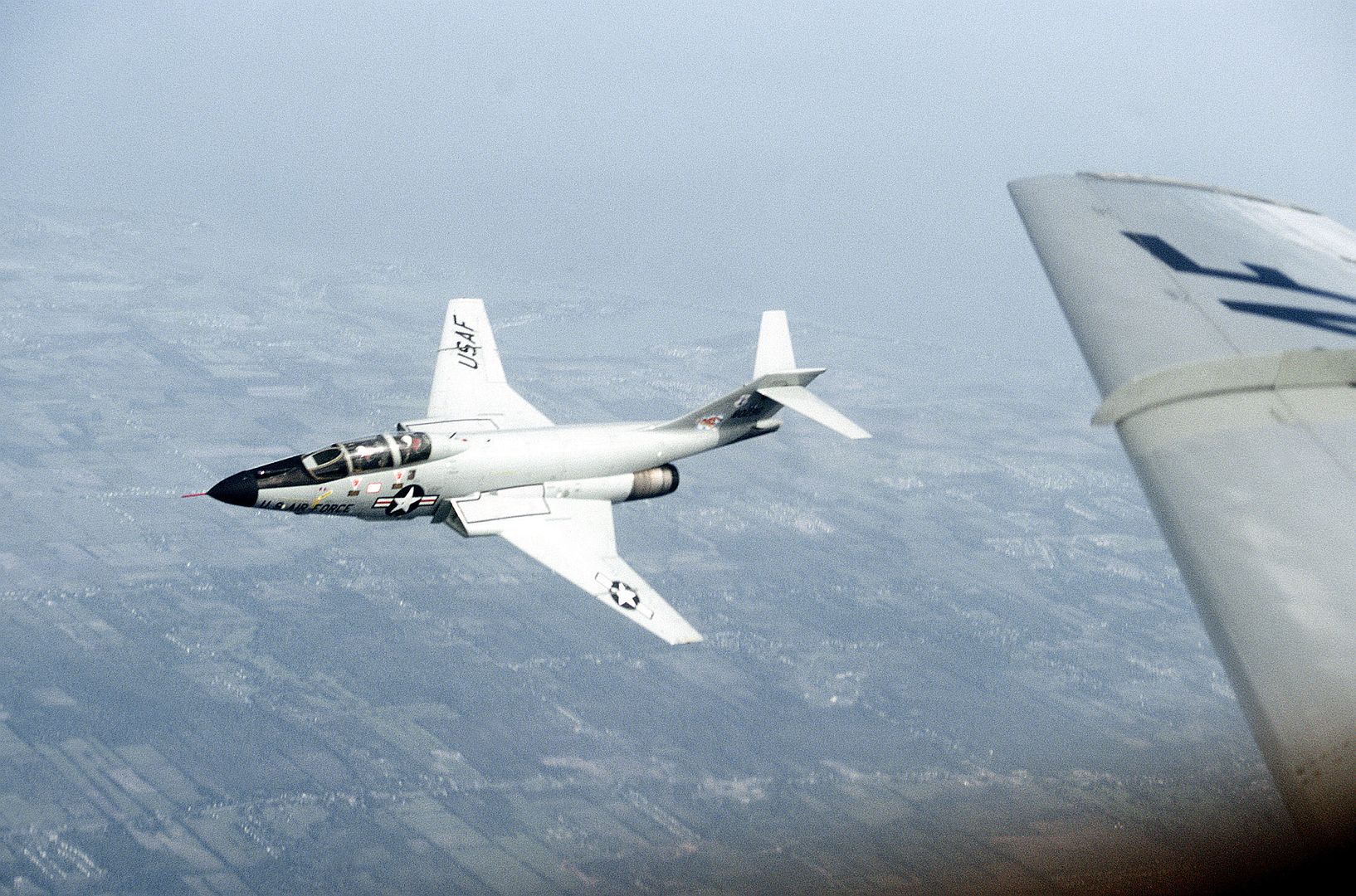
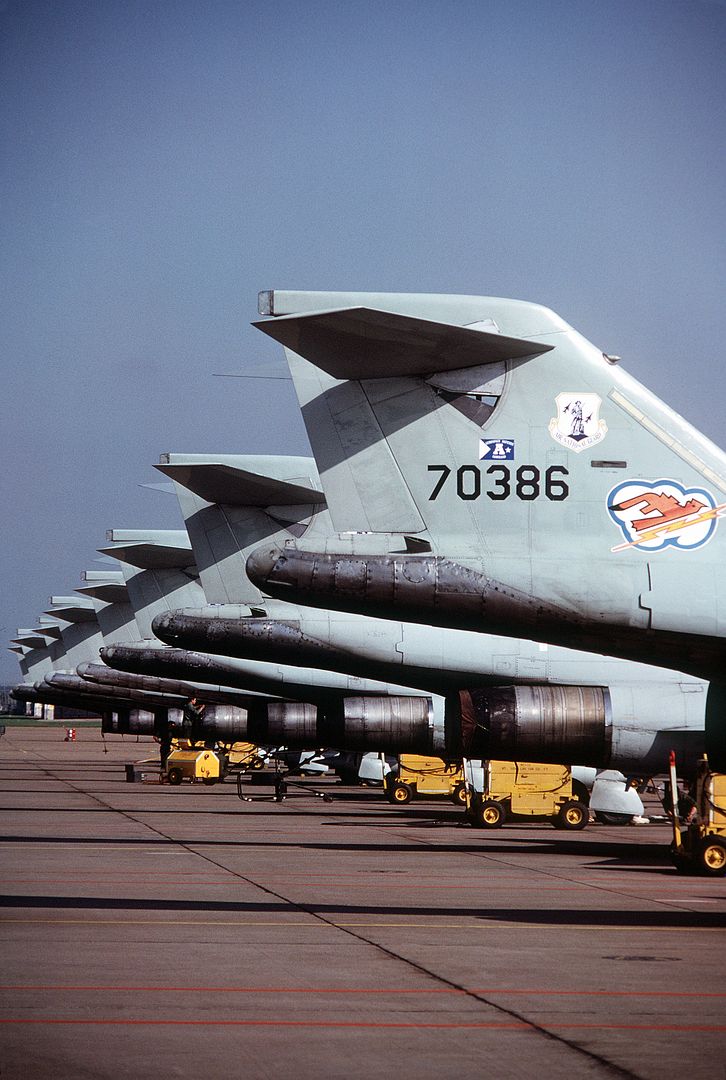
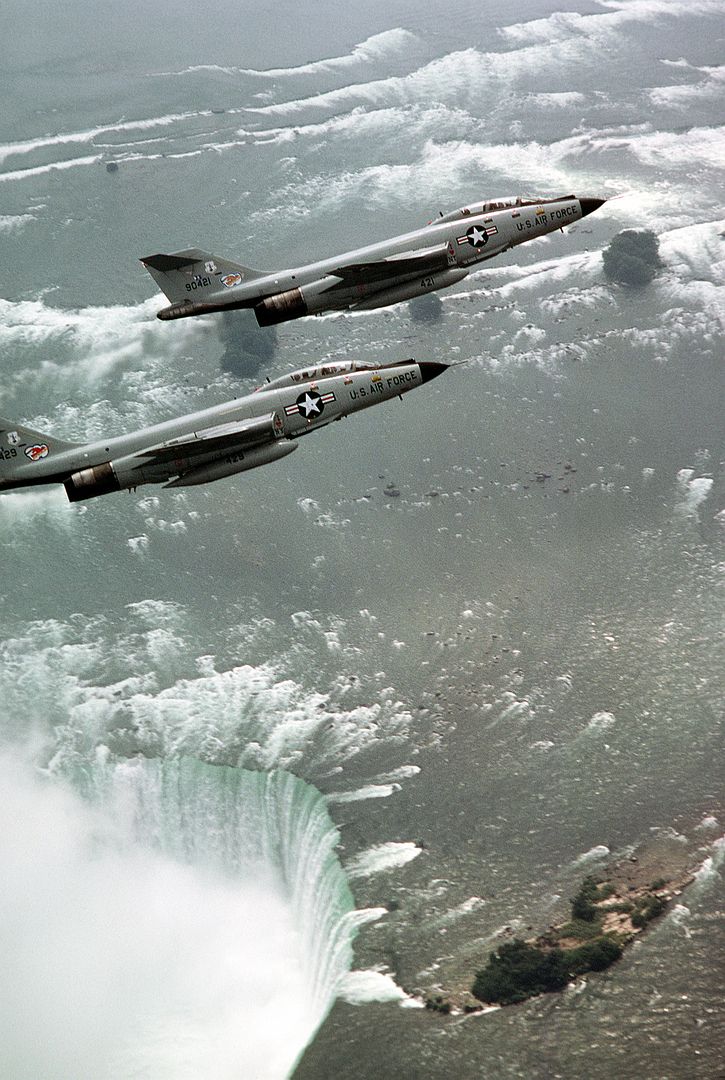
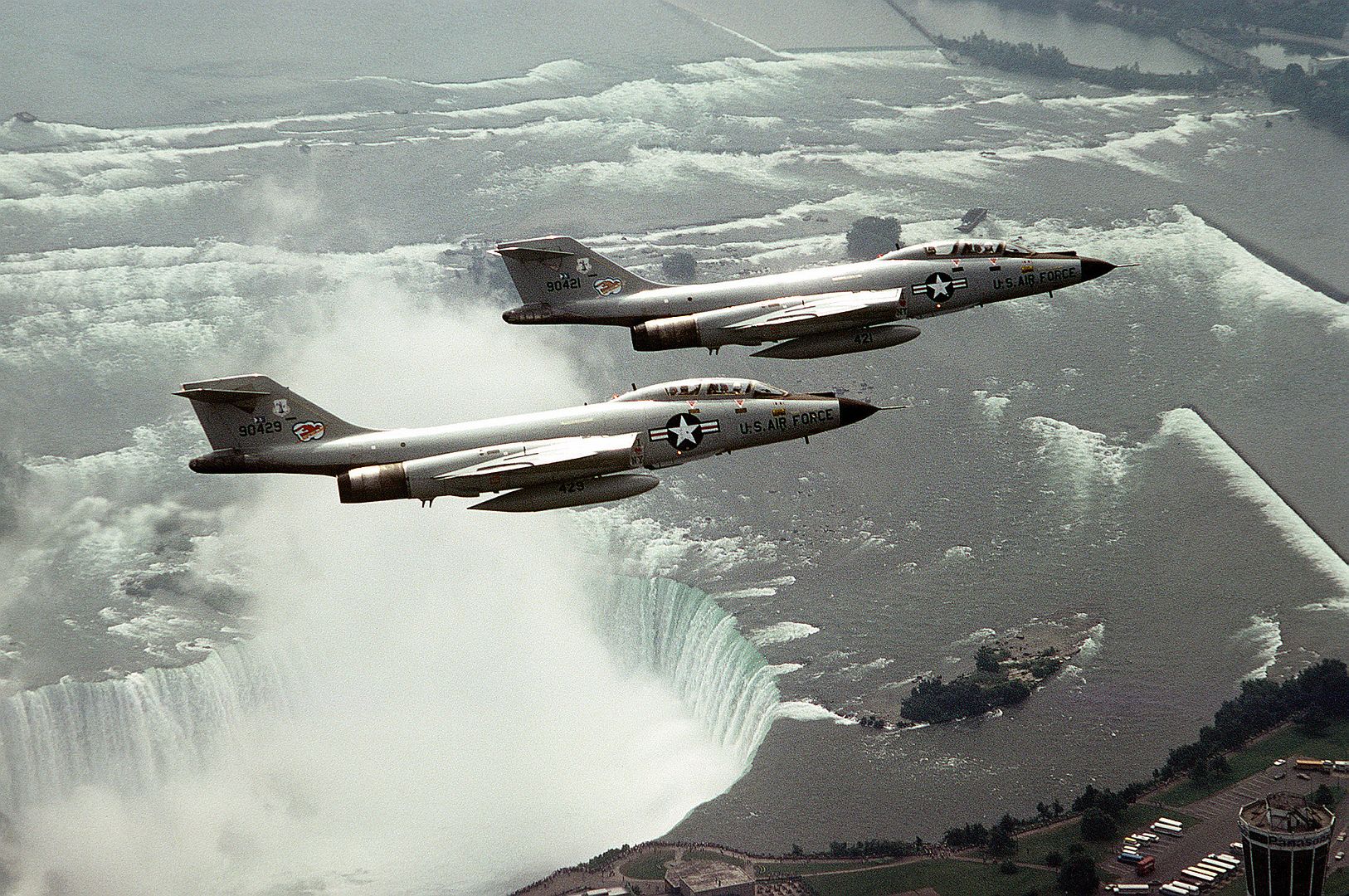
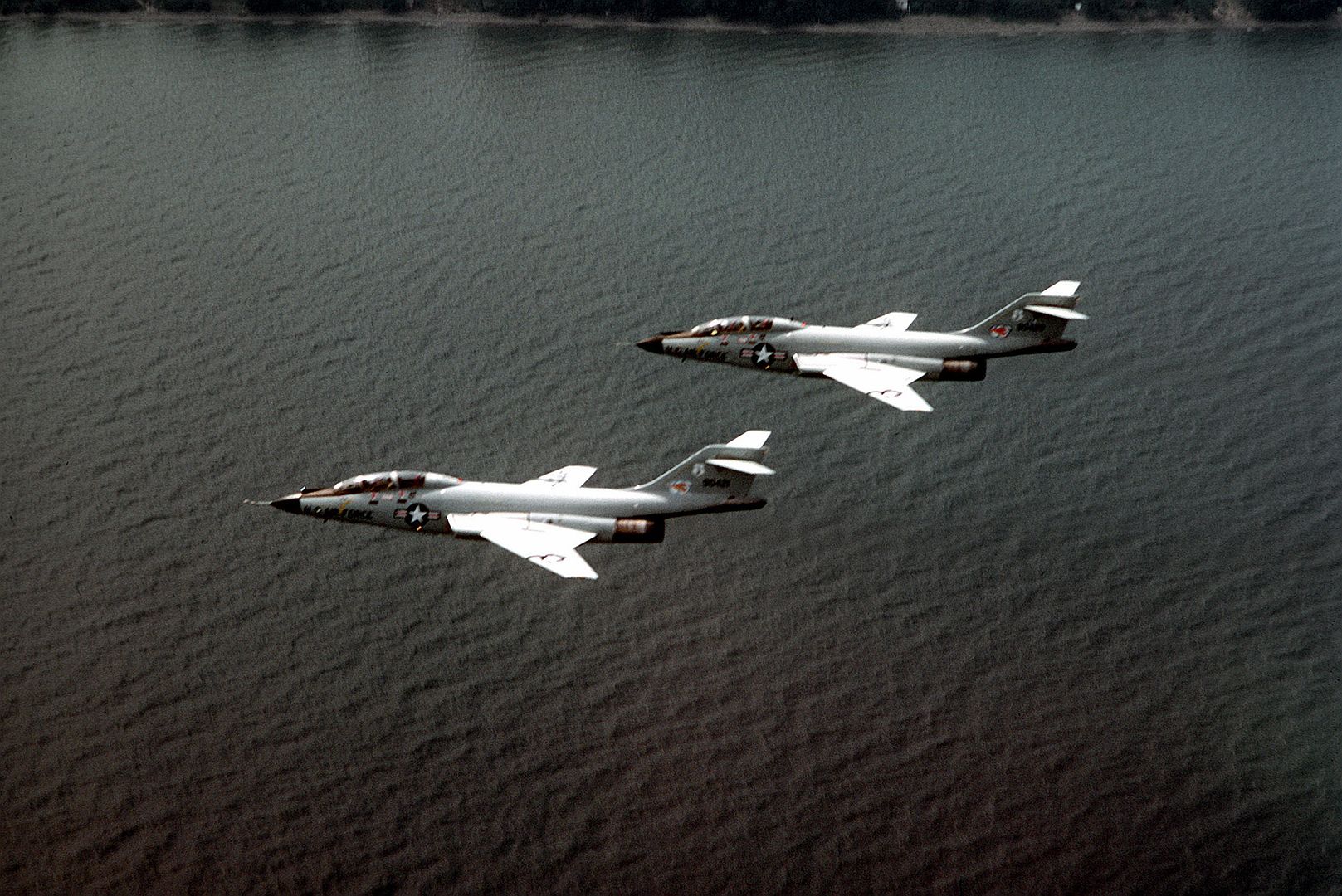
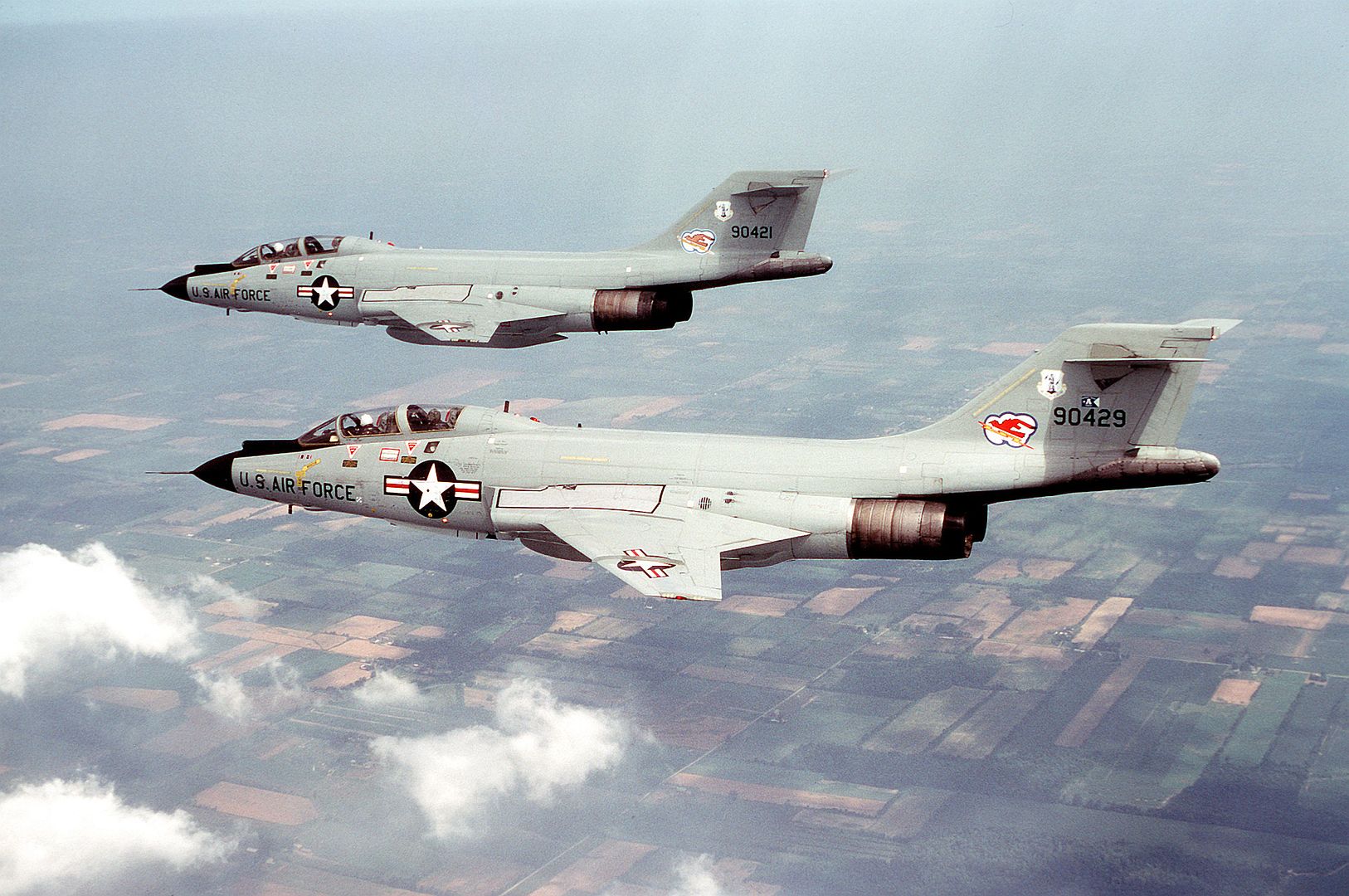
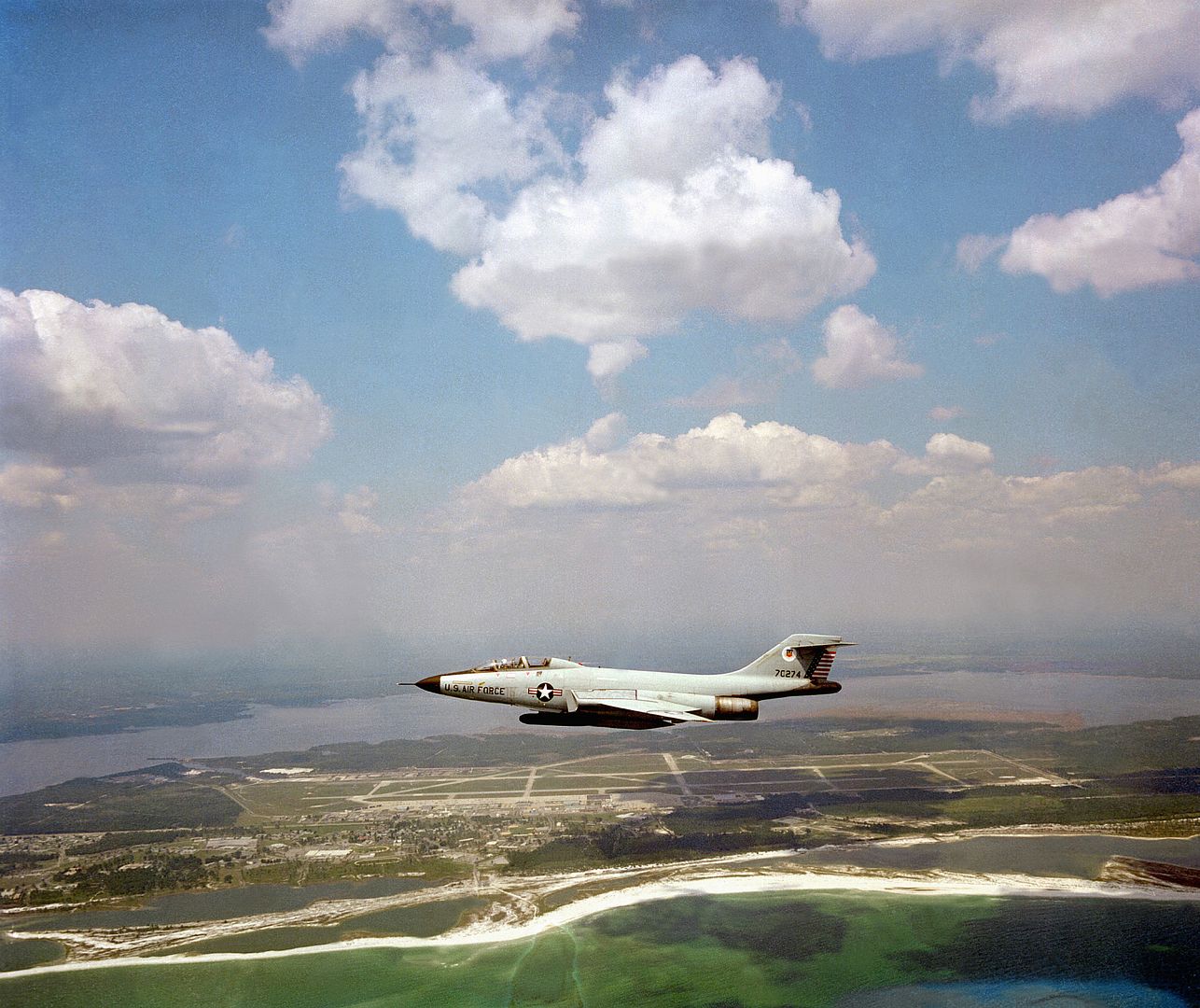
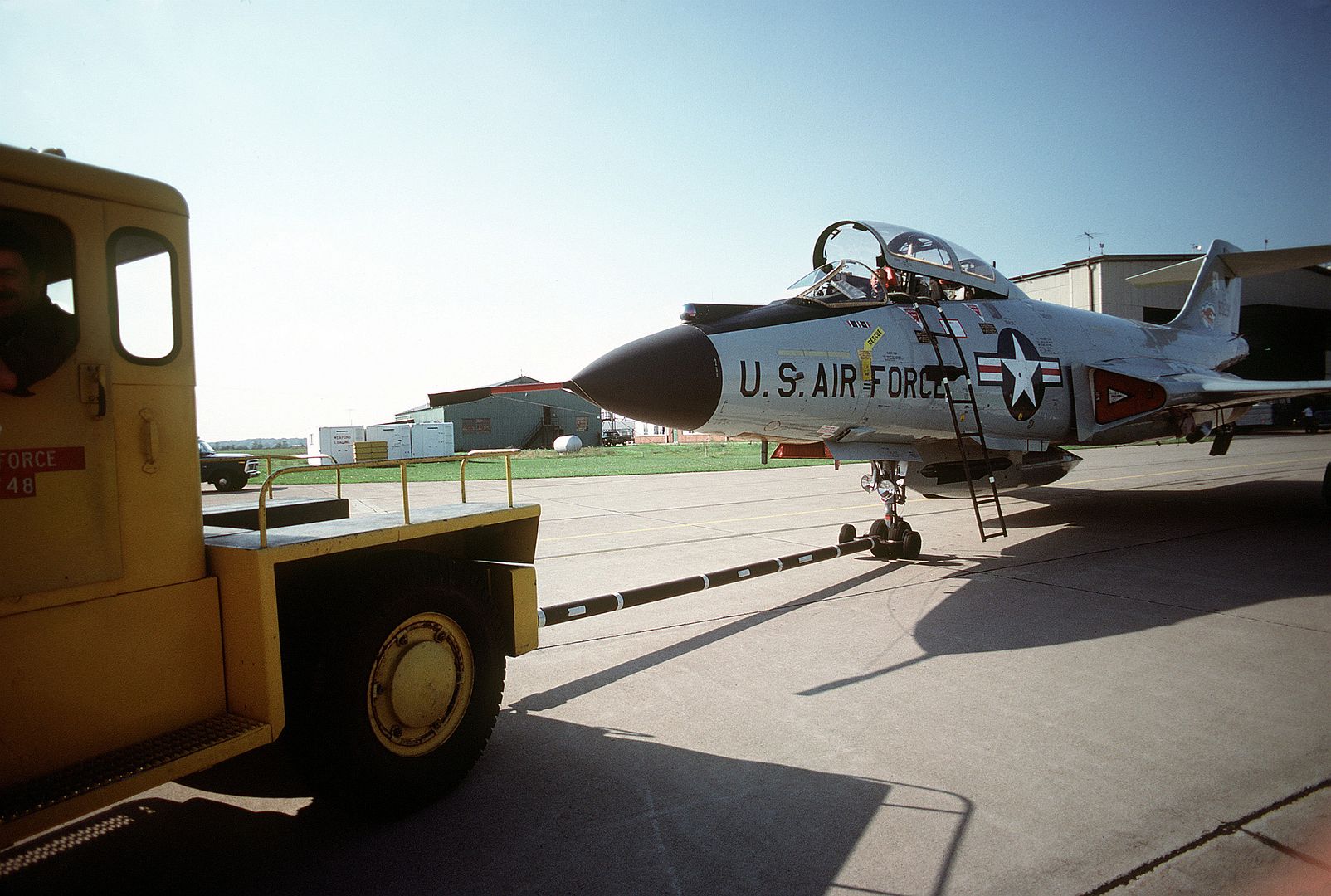
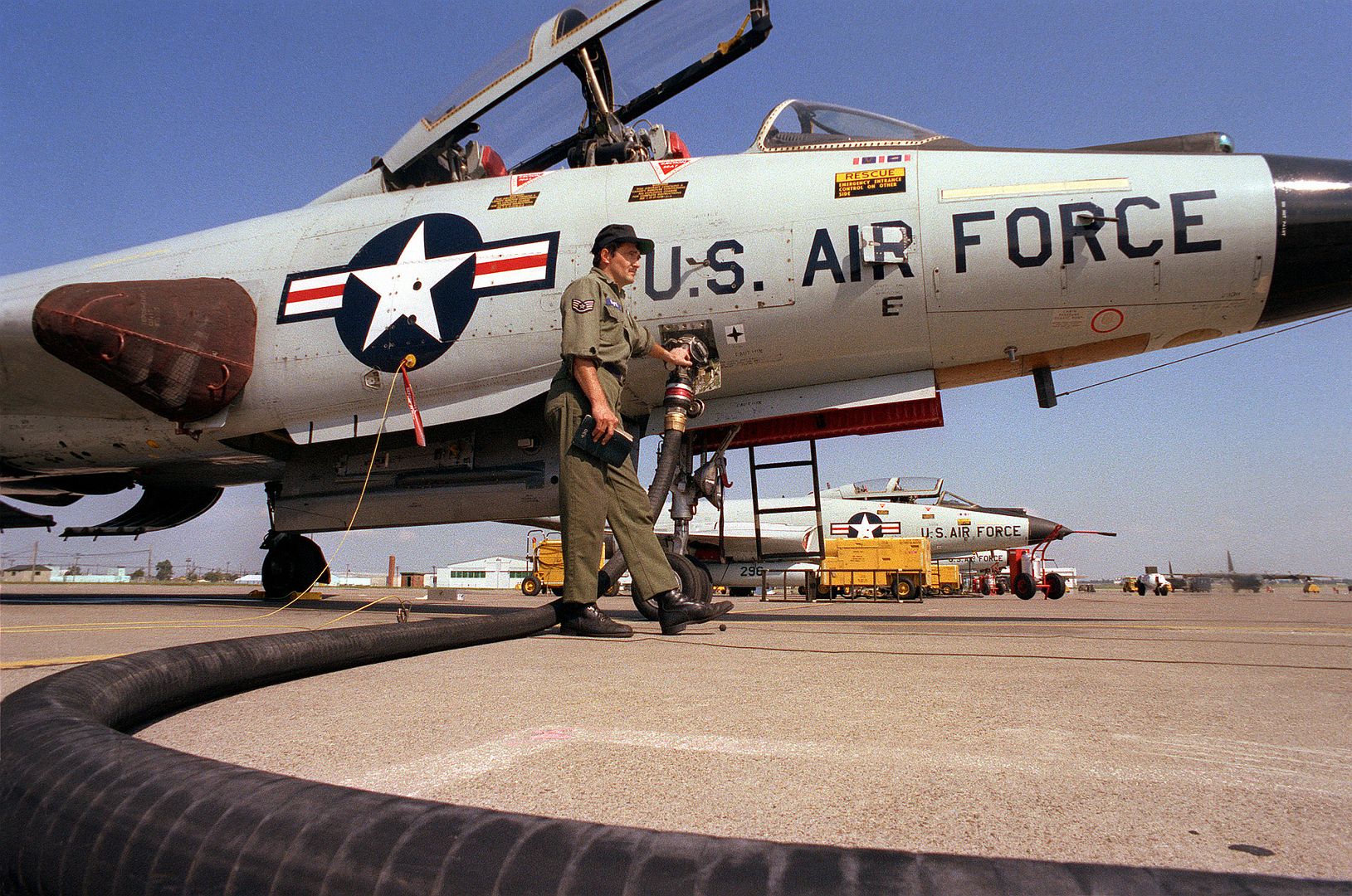


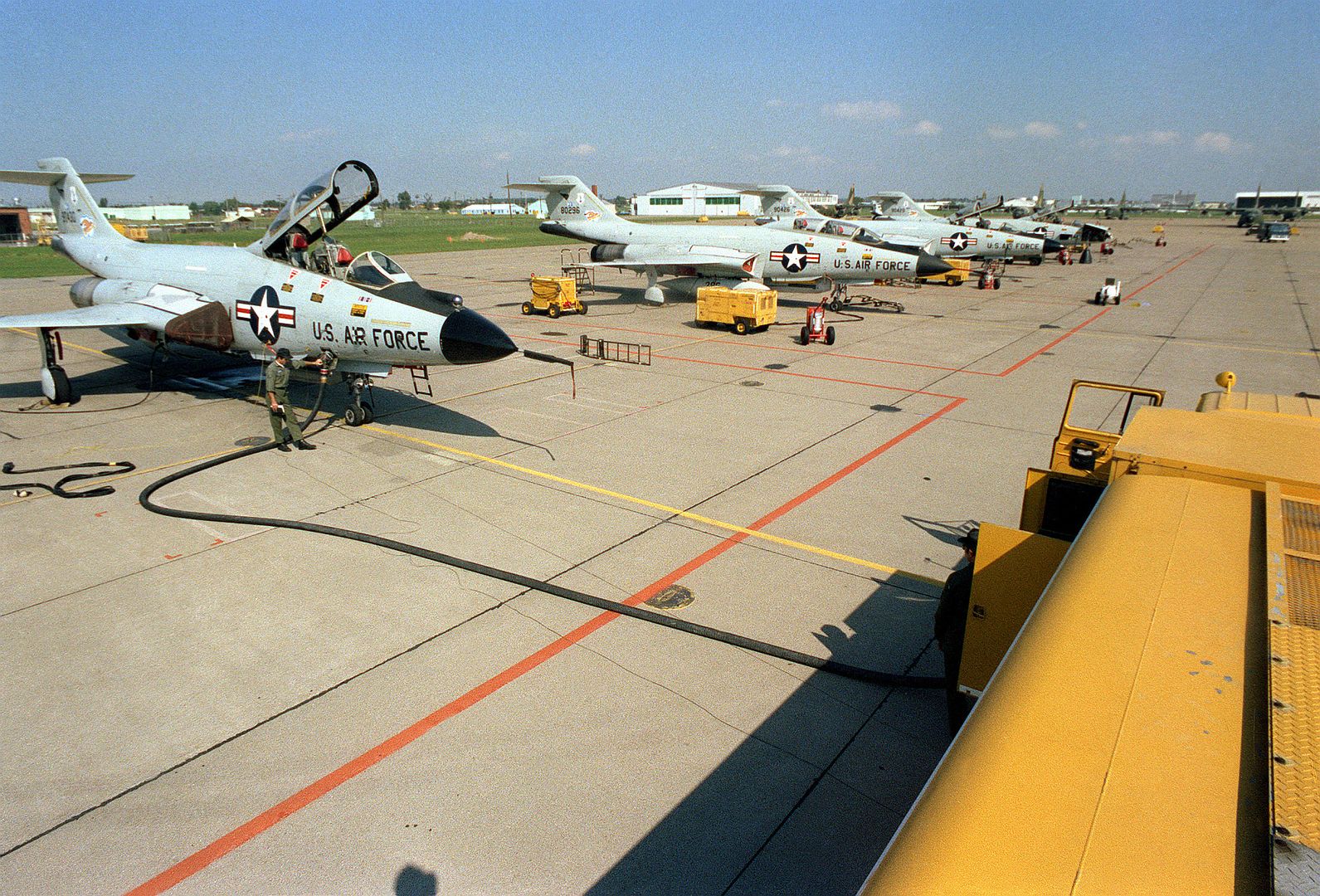
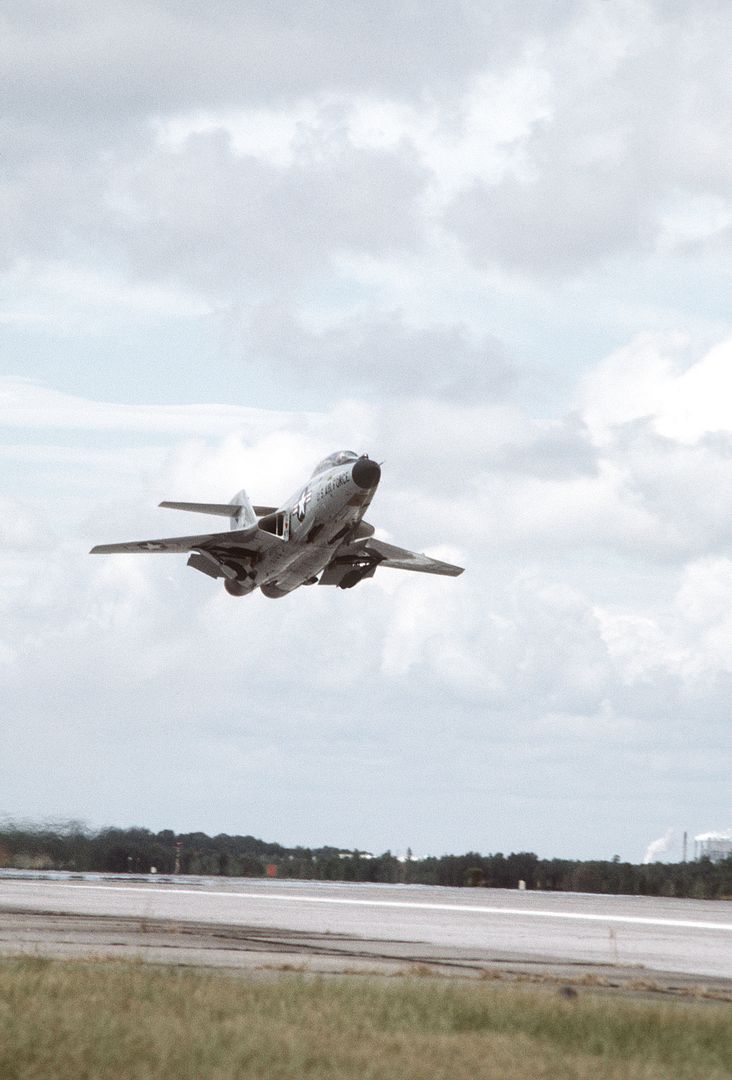
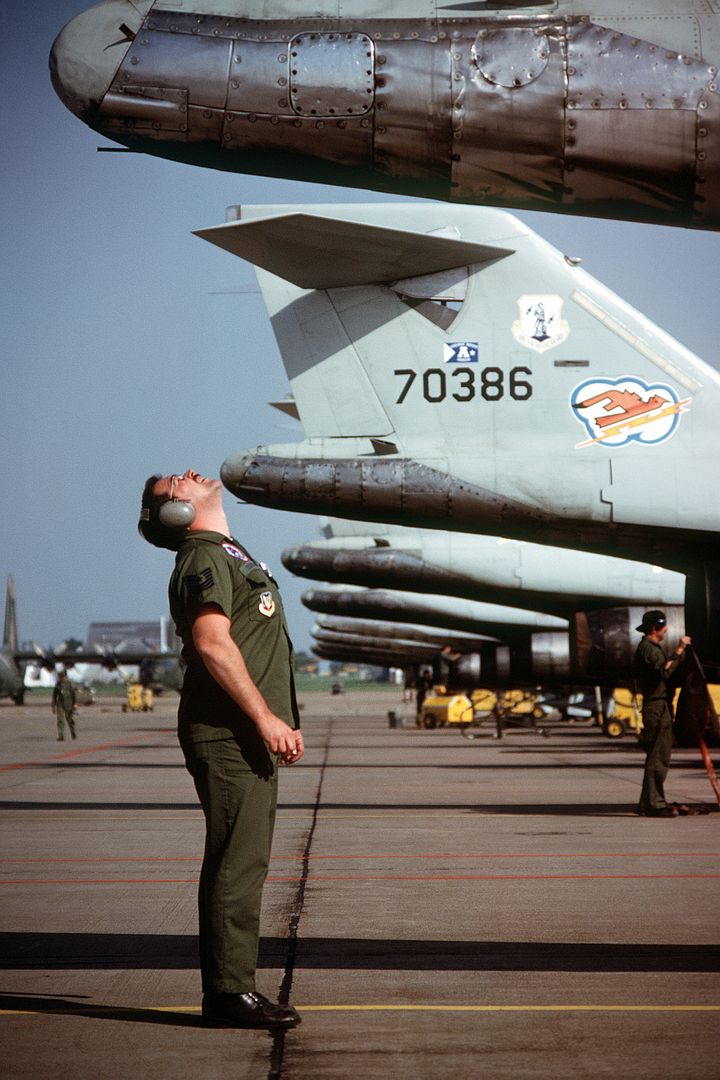

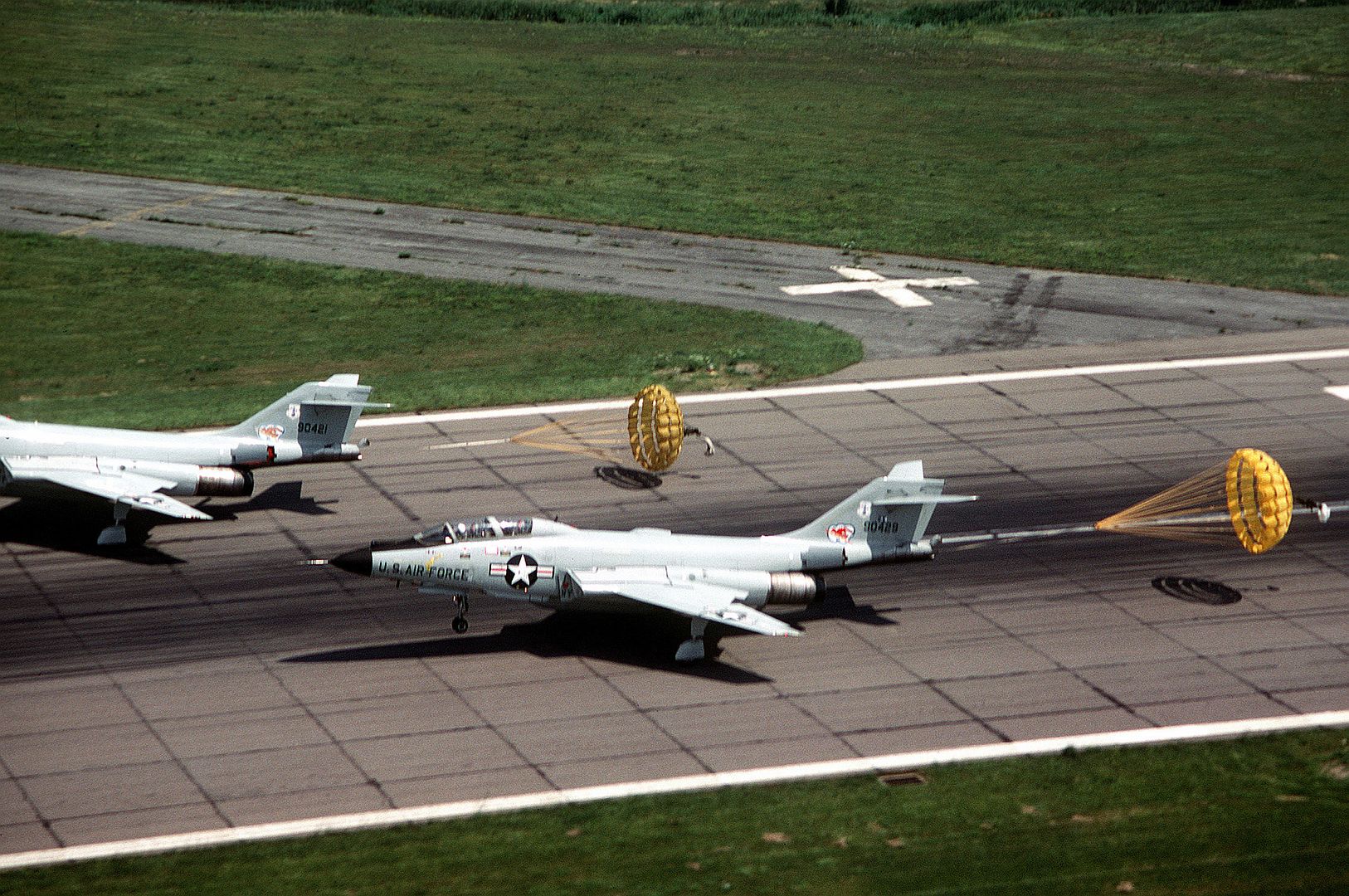




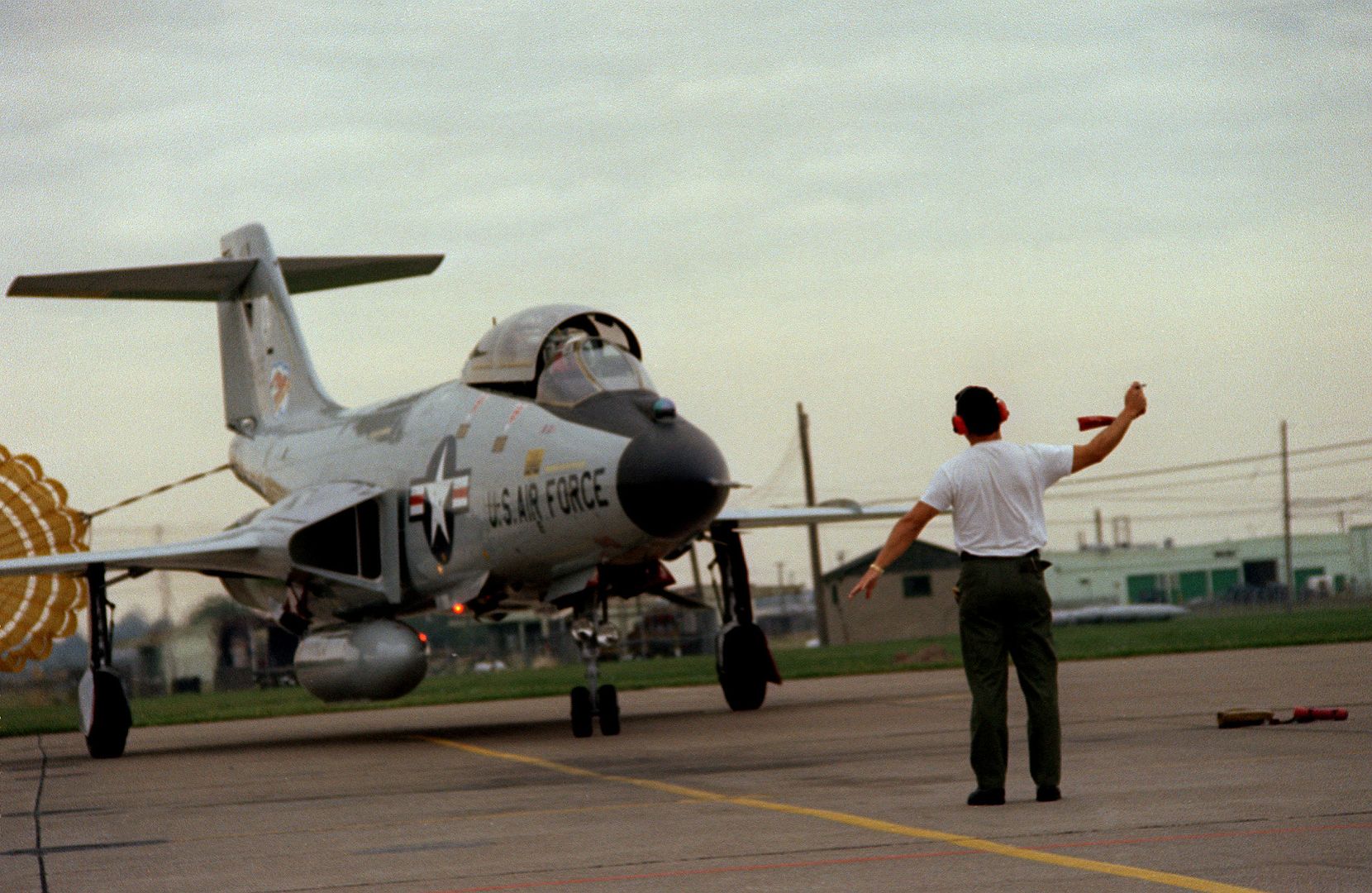
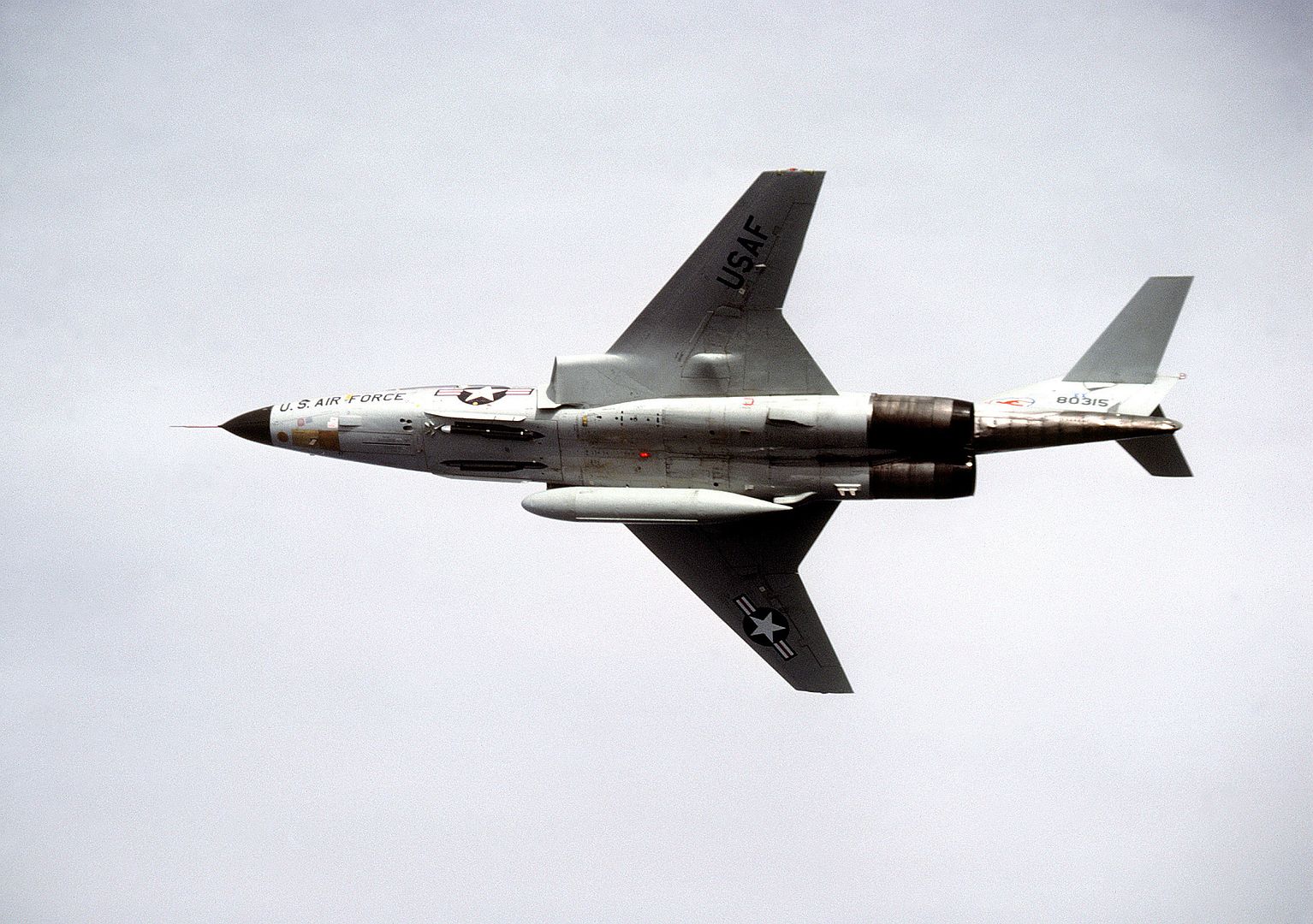
CF-101B
112 F-101Bs transferred to Royal Canadian Air Force
RF-101B
22 former RCAF CF-101Bs modified for reconnaissance use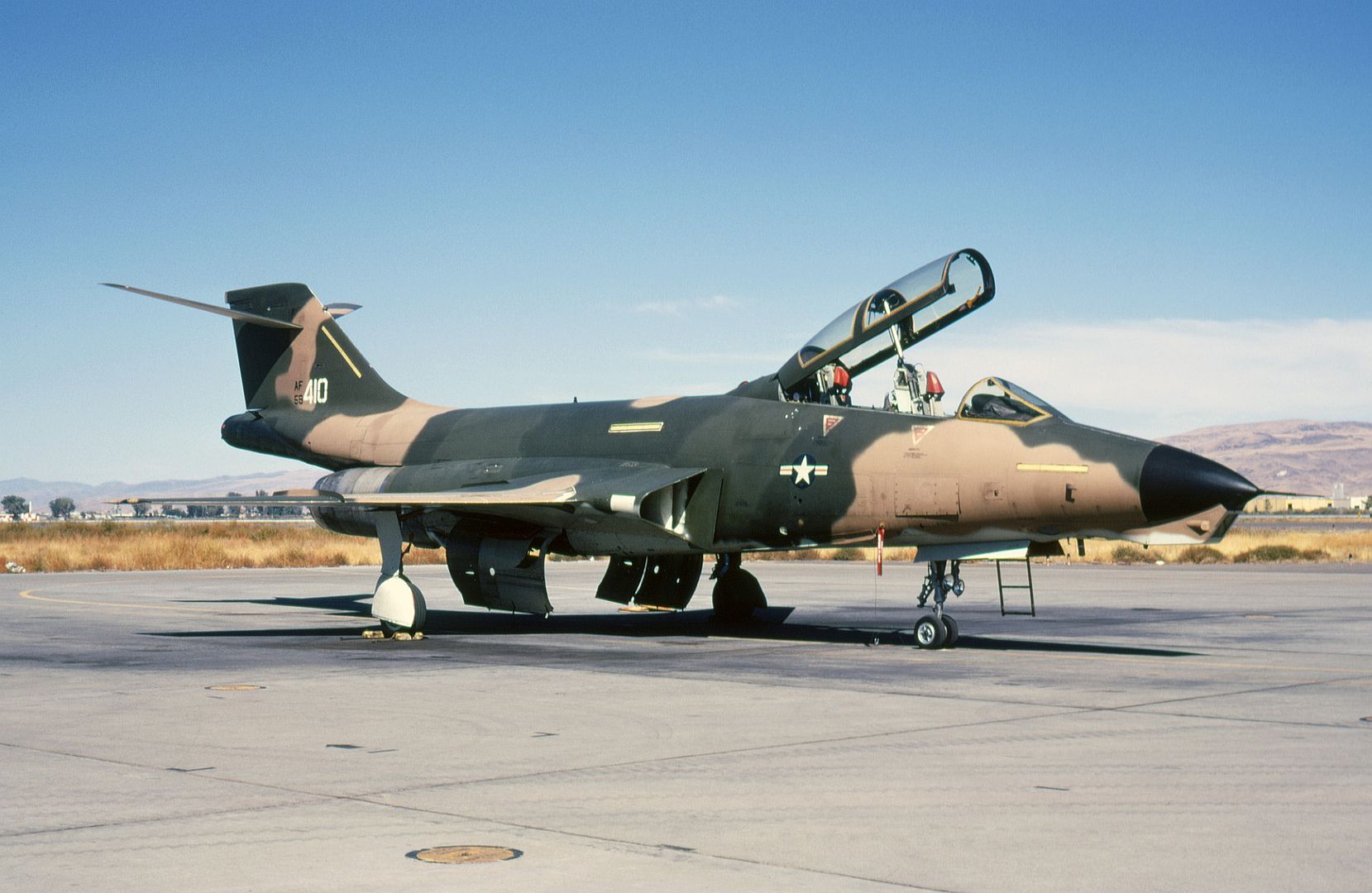
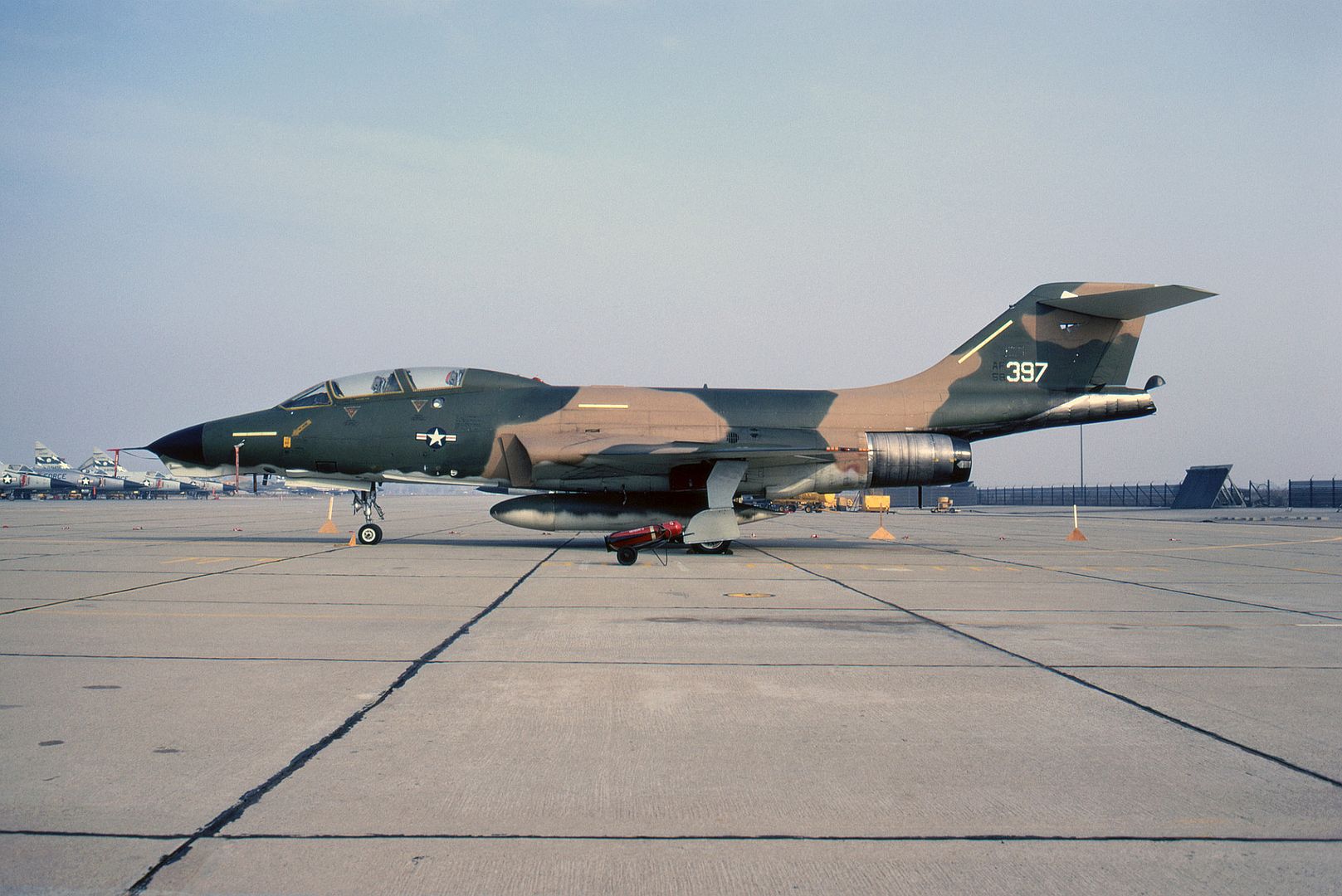
TF-101B
dual-control trainer version of F-101B, redesignated F-101F, 79 built
EF-101B
single F-101B converted for use as a radar target and leased to Canada
NF-101B
F-101B prototype based on the F-101A airframe; the second prototype was built with a different nose
F-101C
improved fighter-bomber, 47 built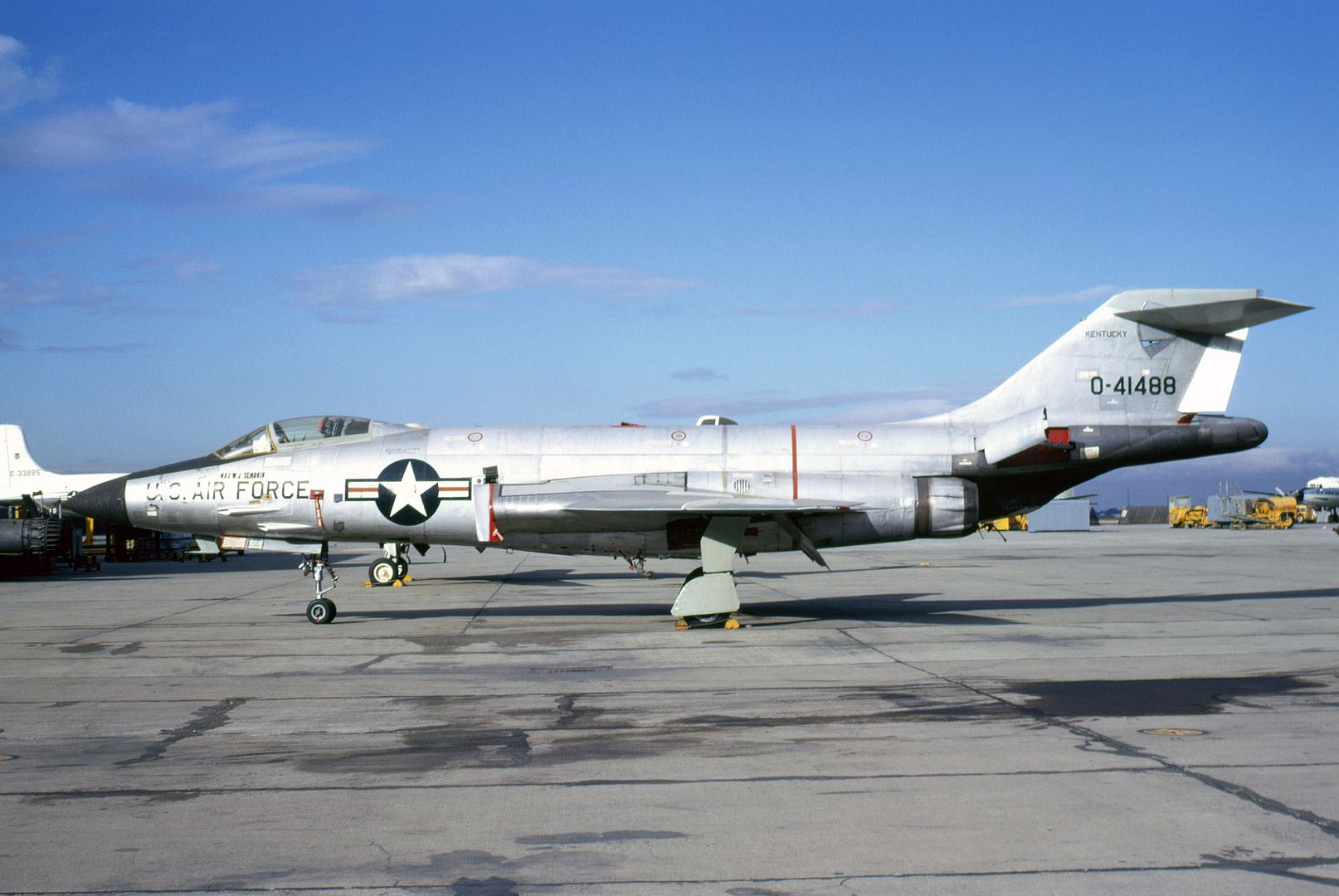
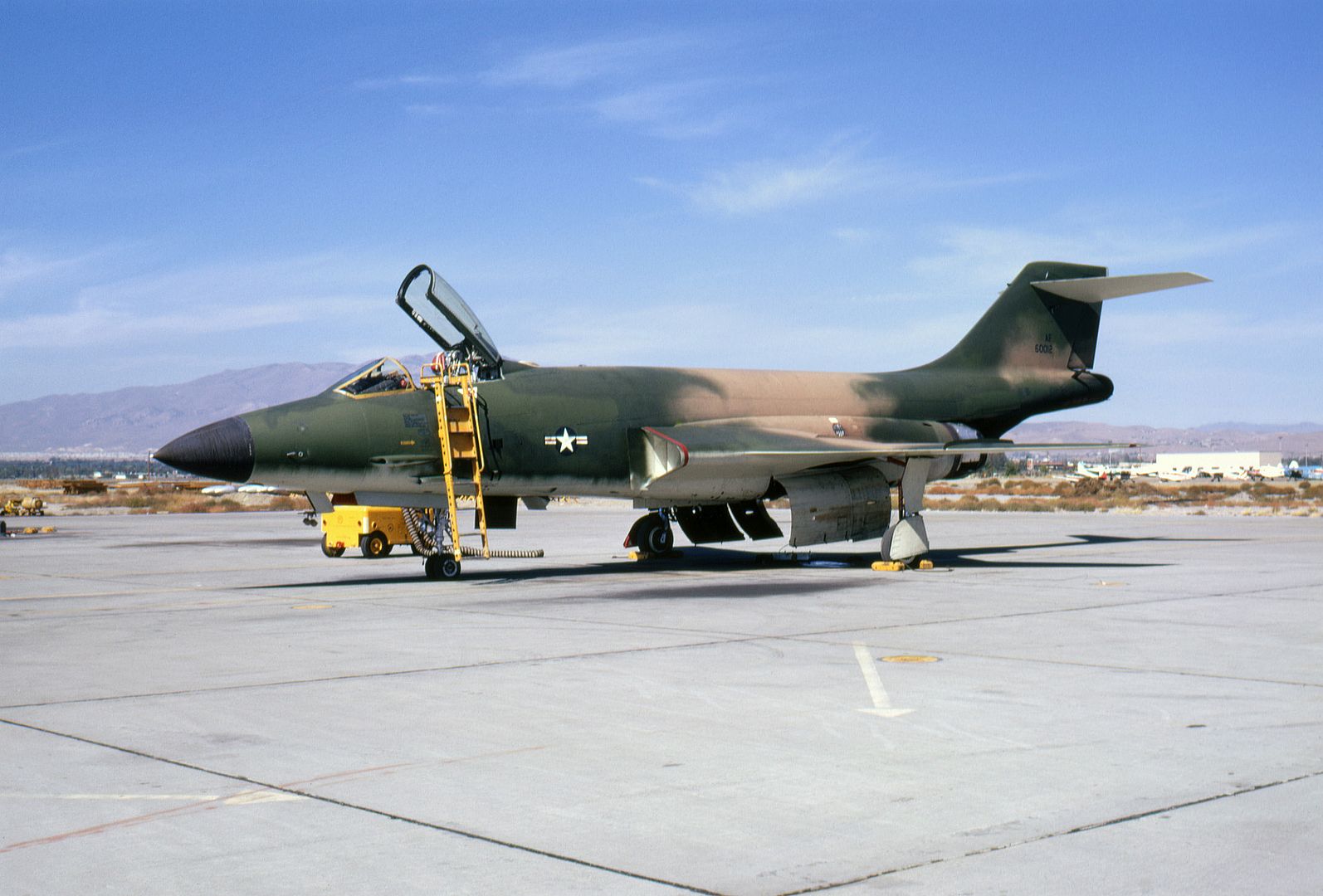
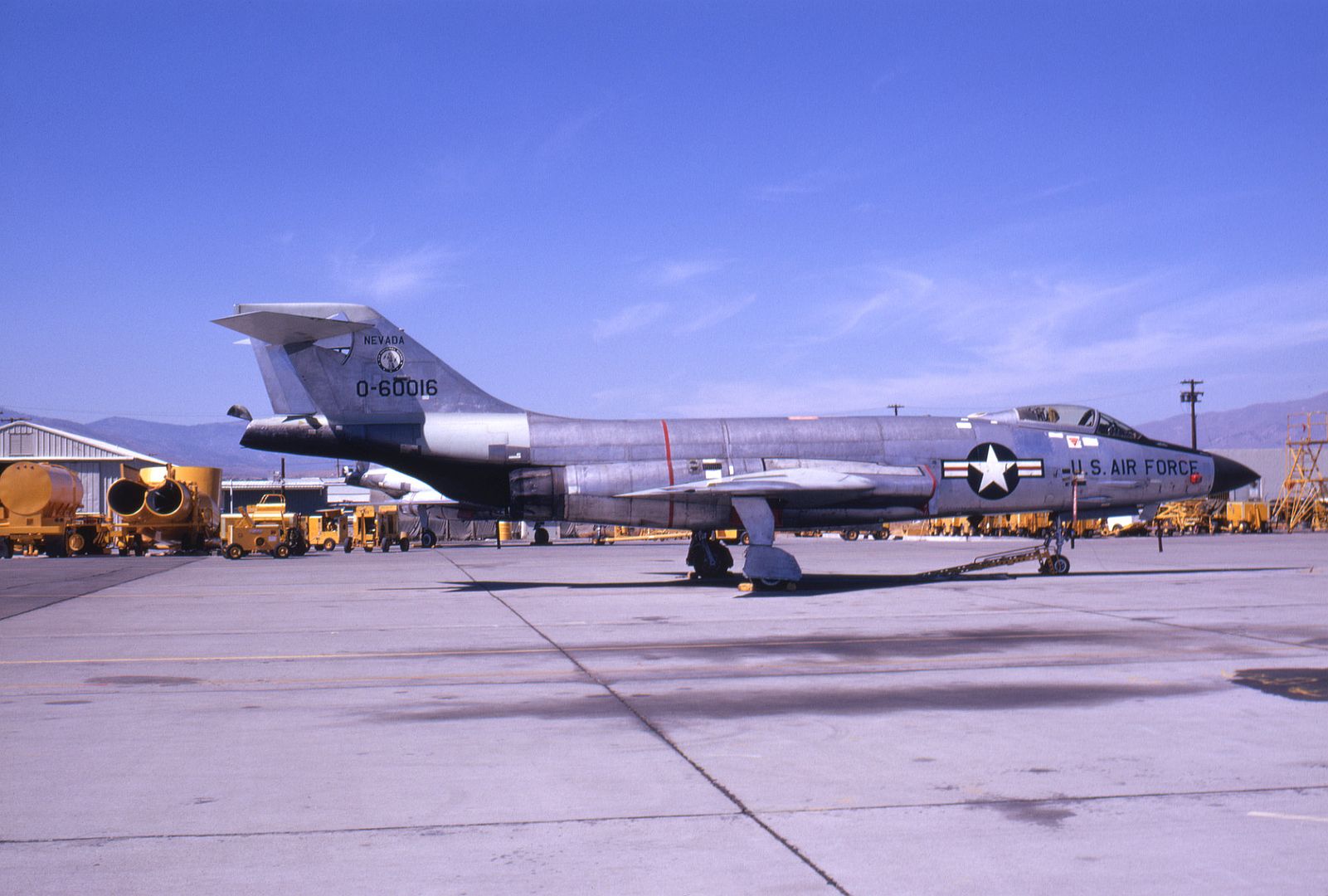
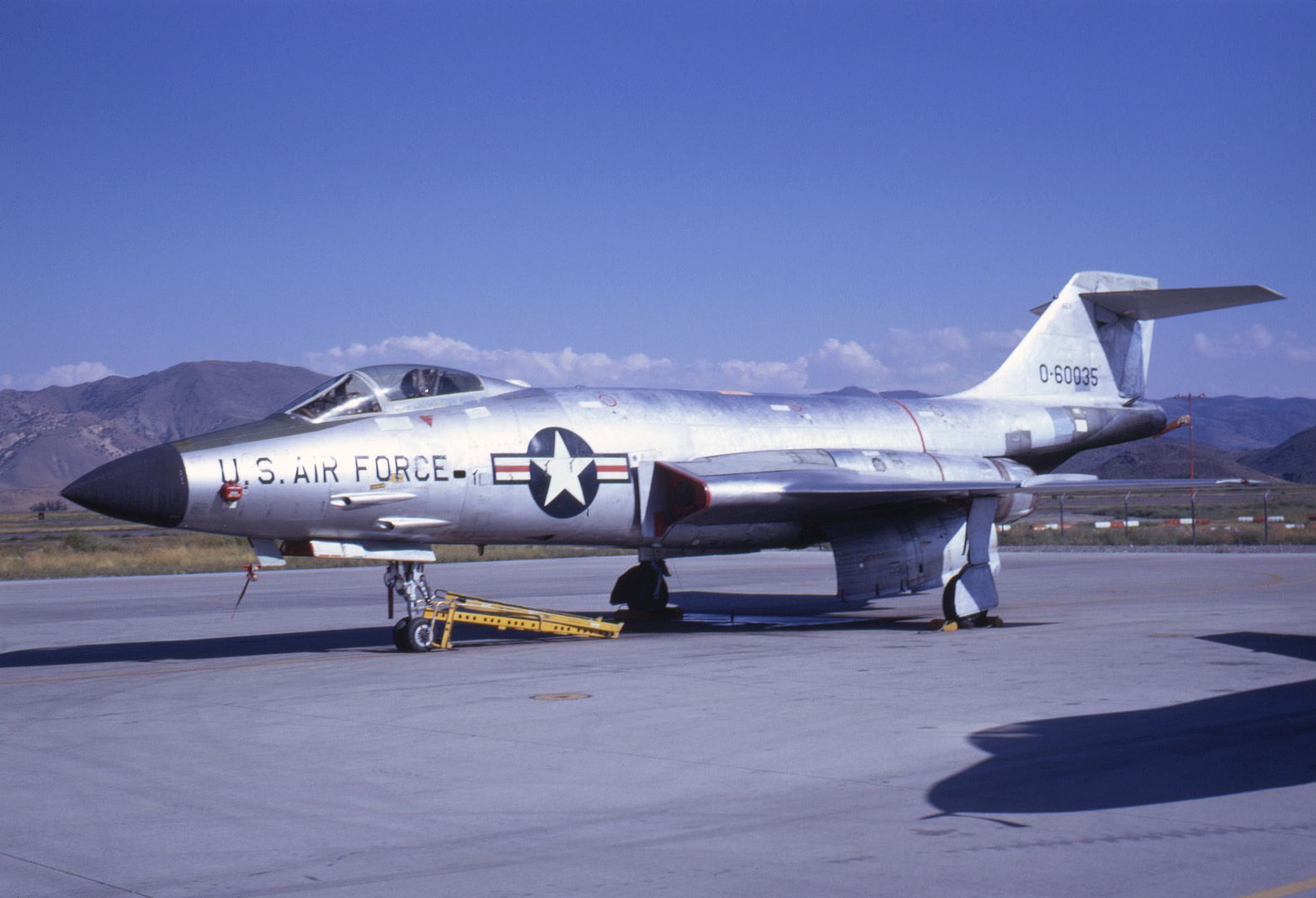

RF-101C
reconnaissance version of F-101C airframe, 166 built
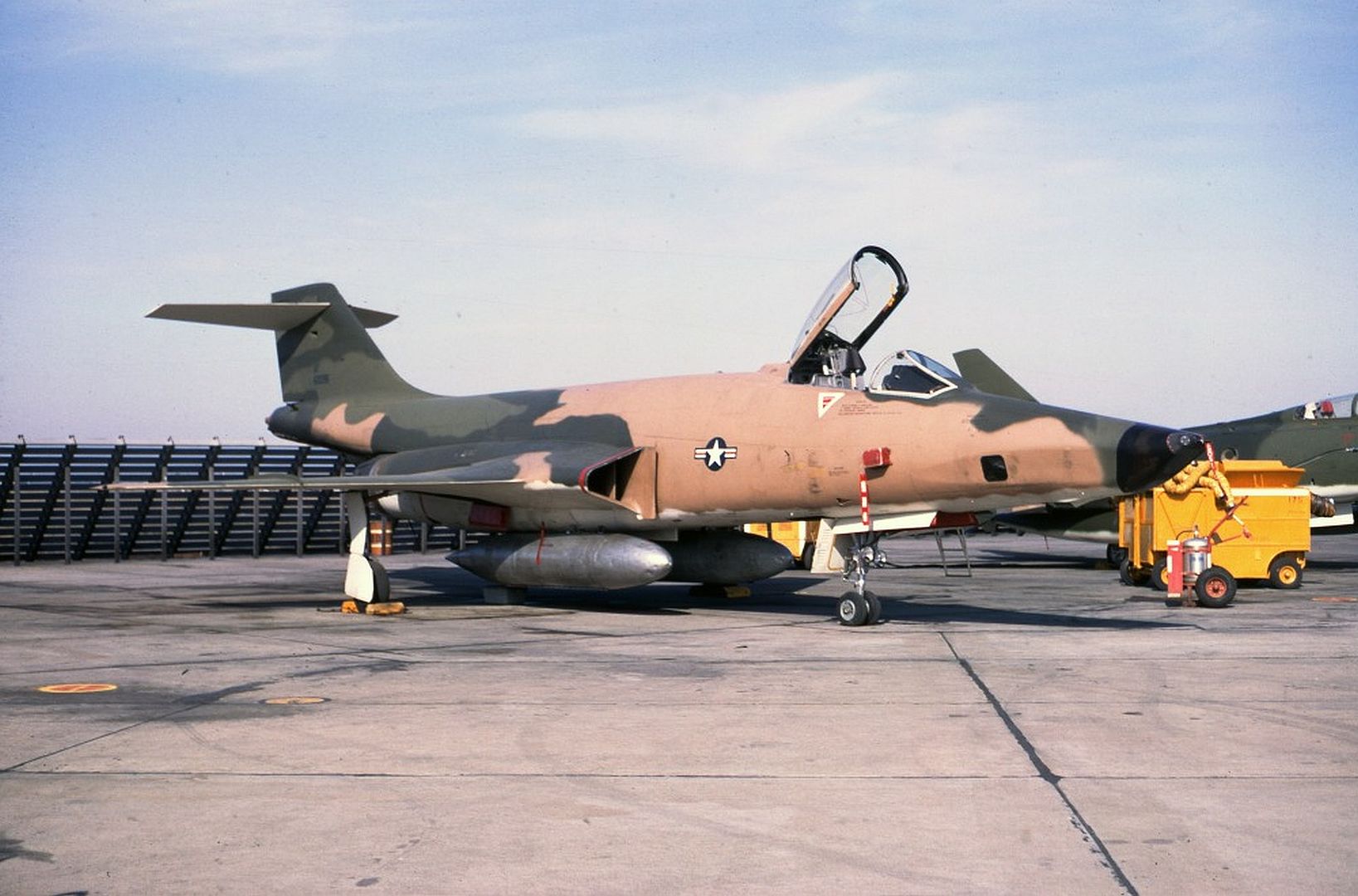


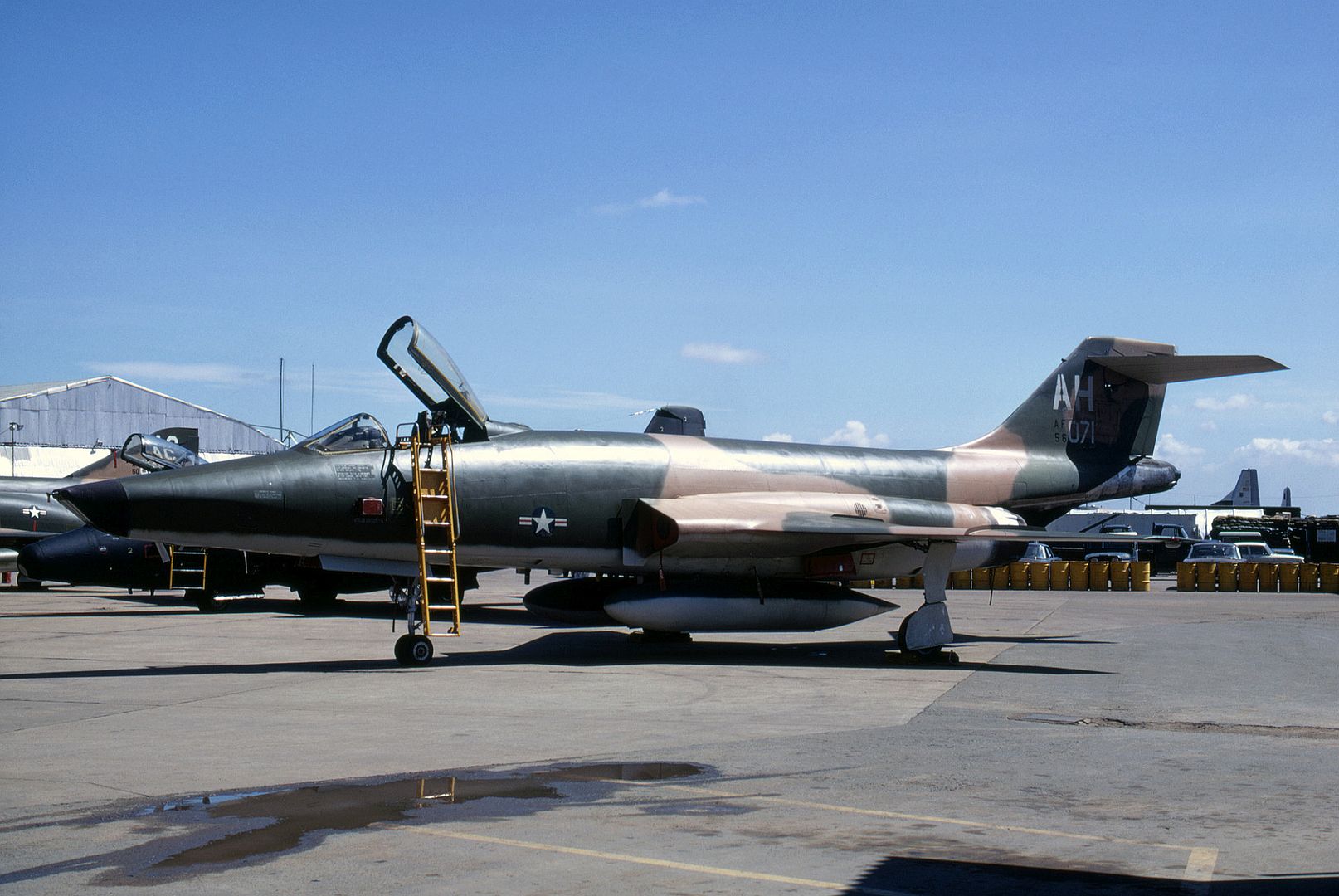
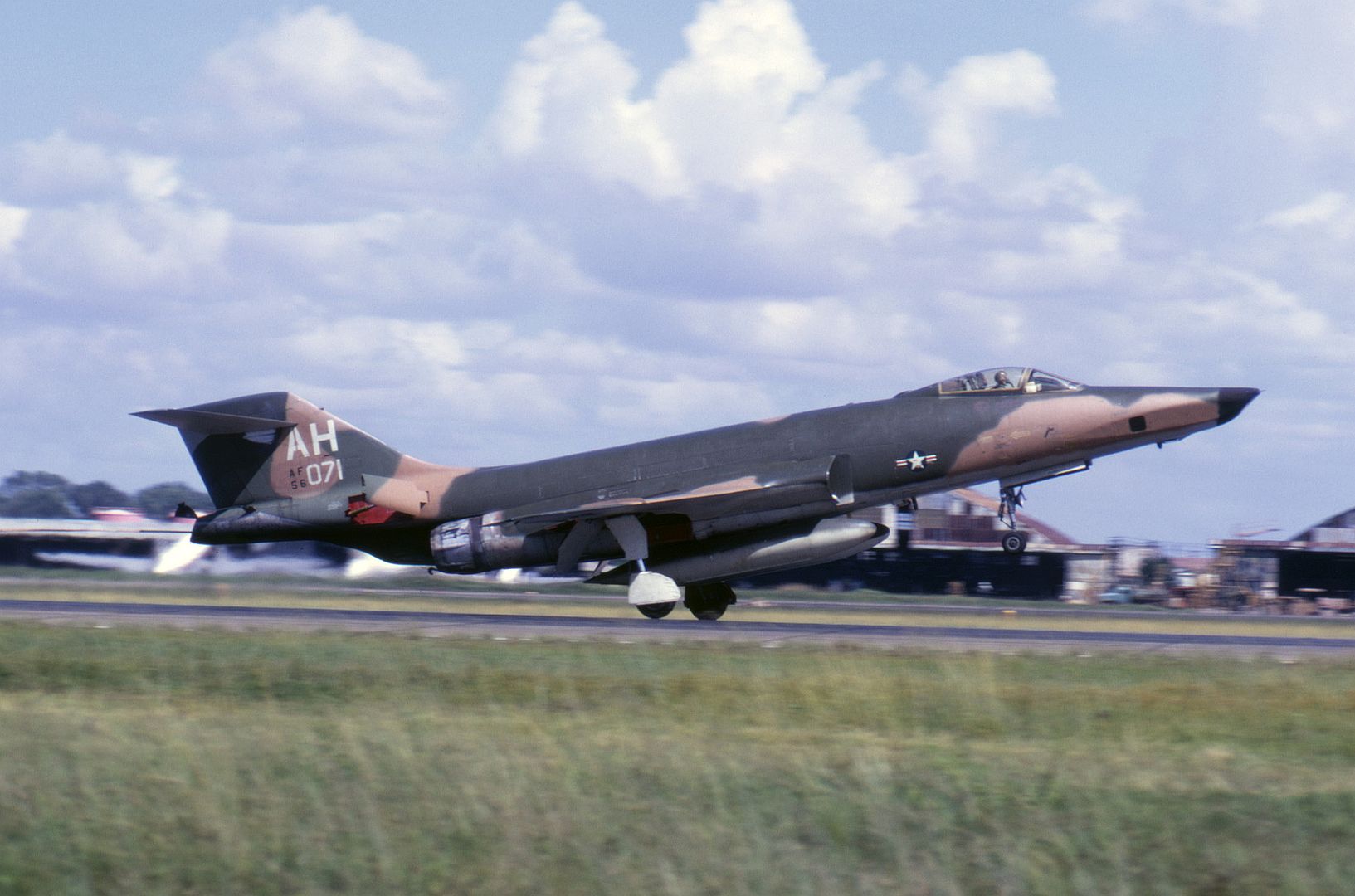
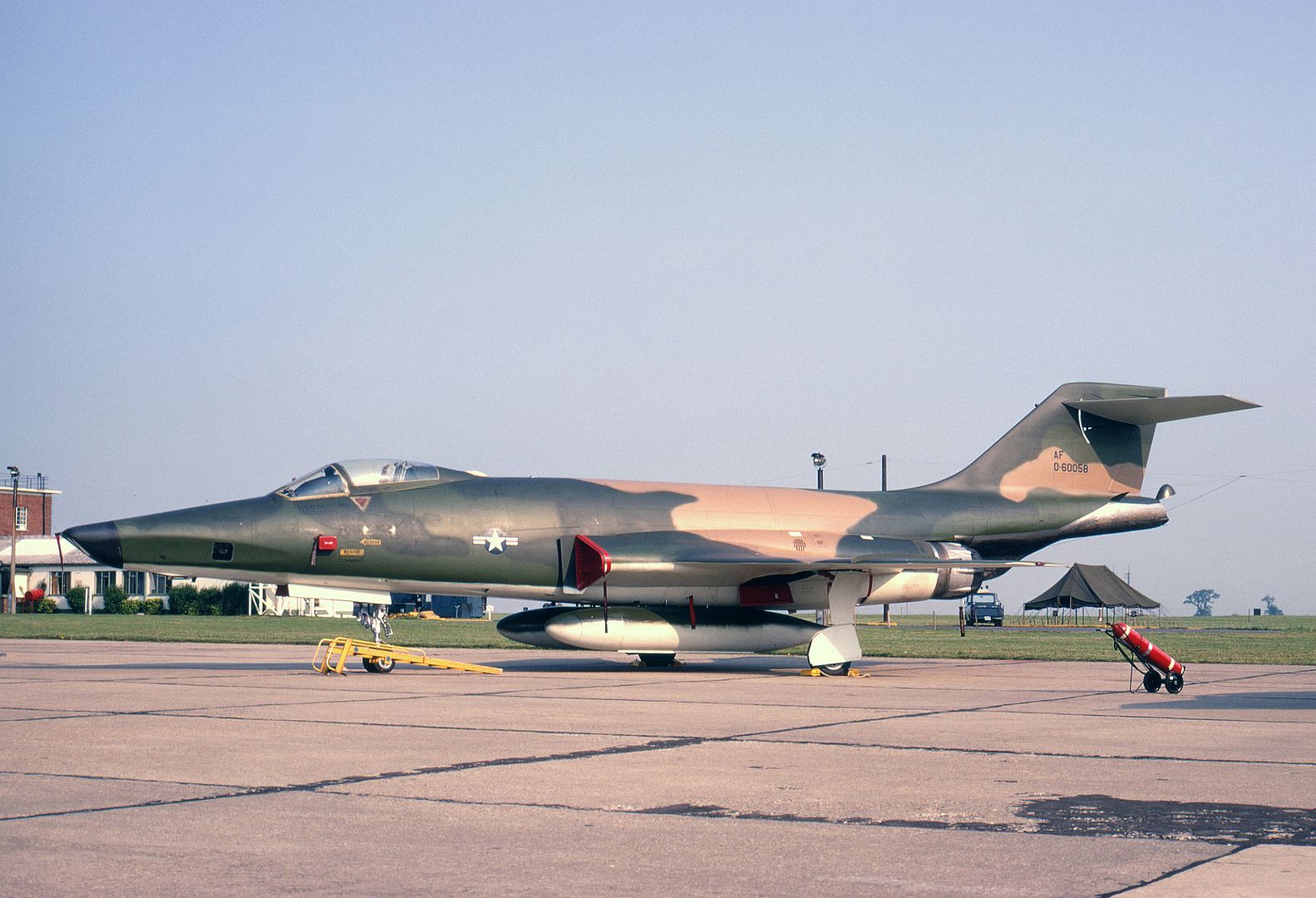
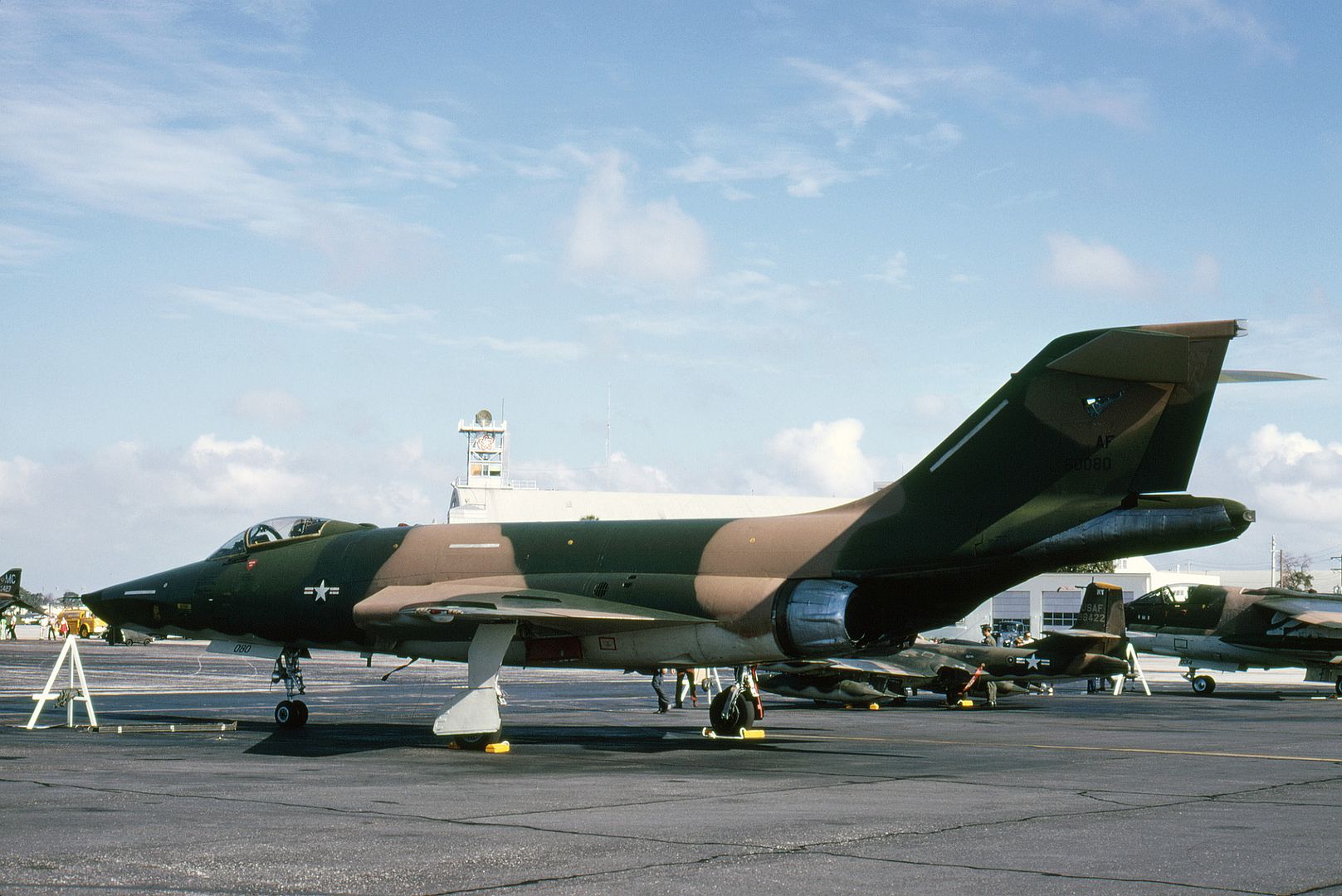
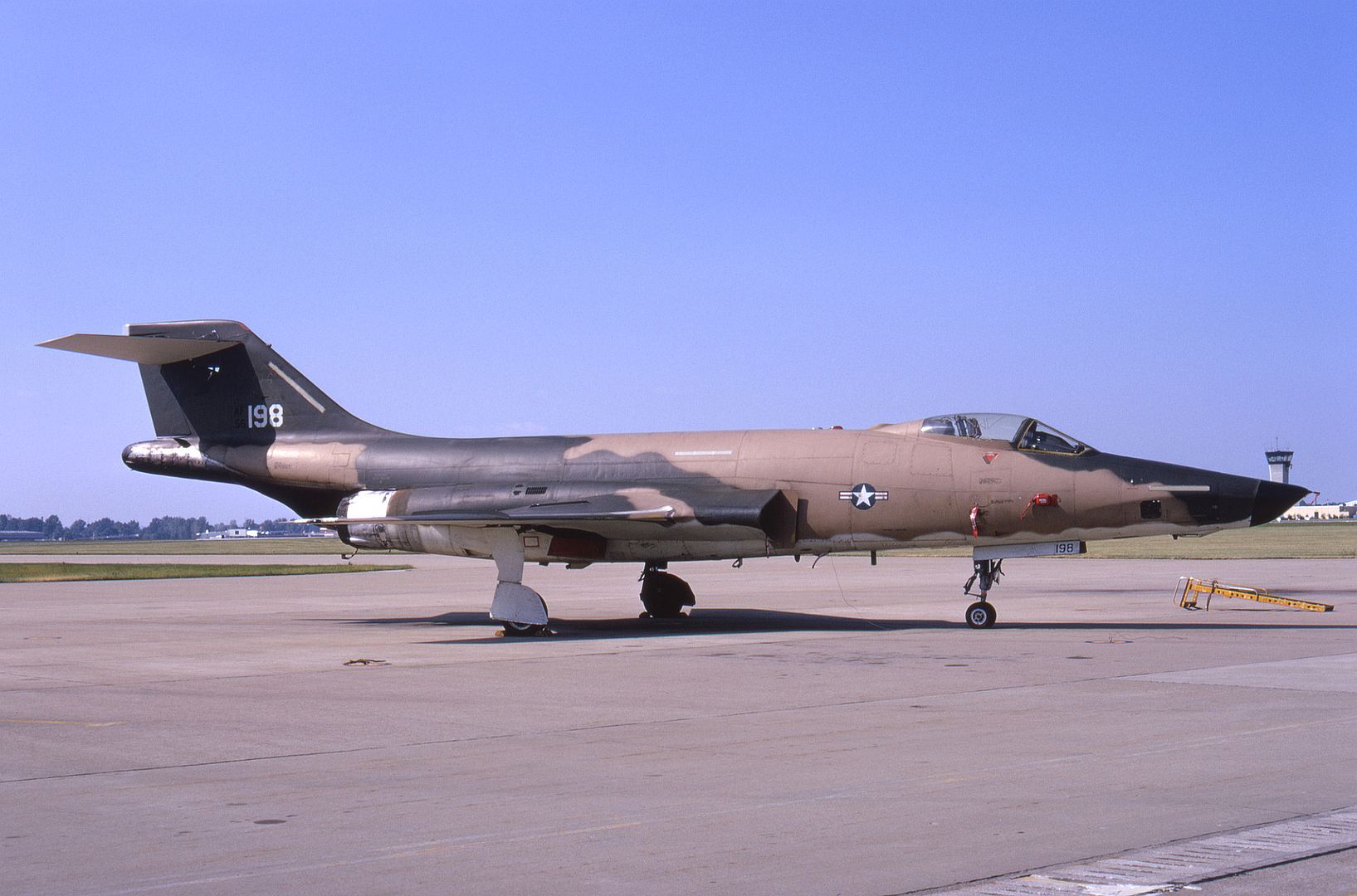
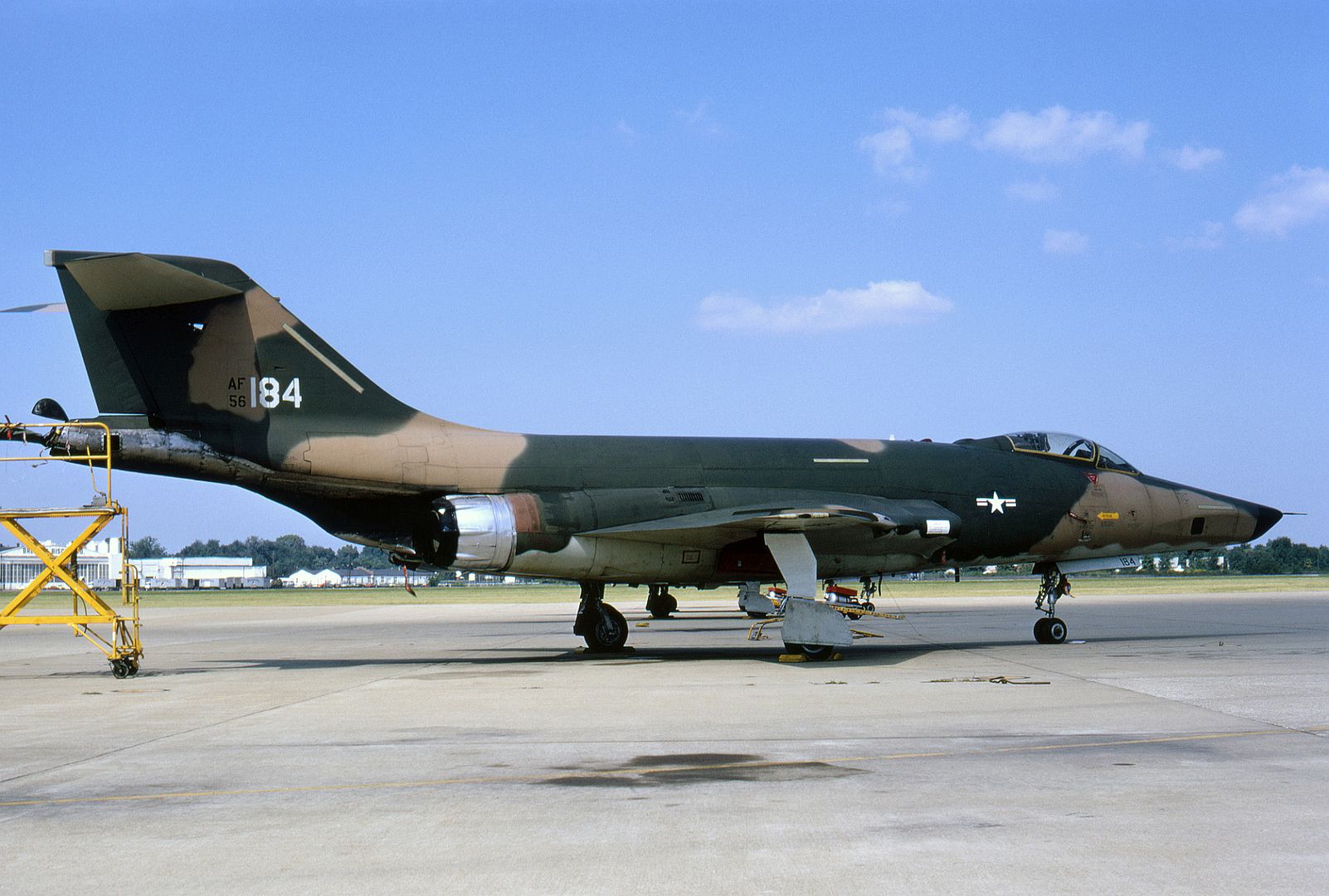
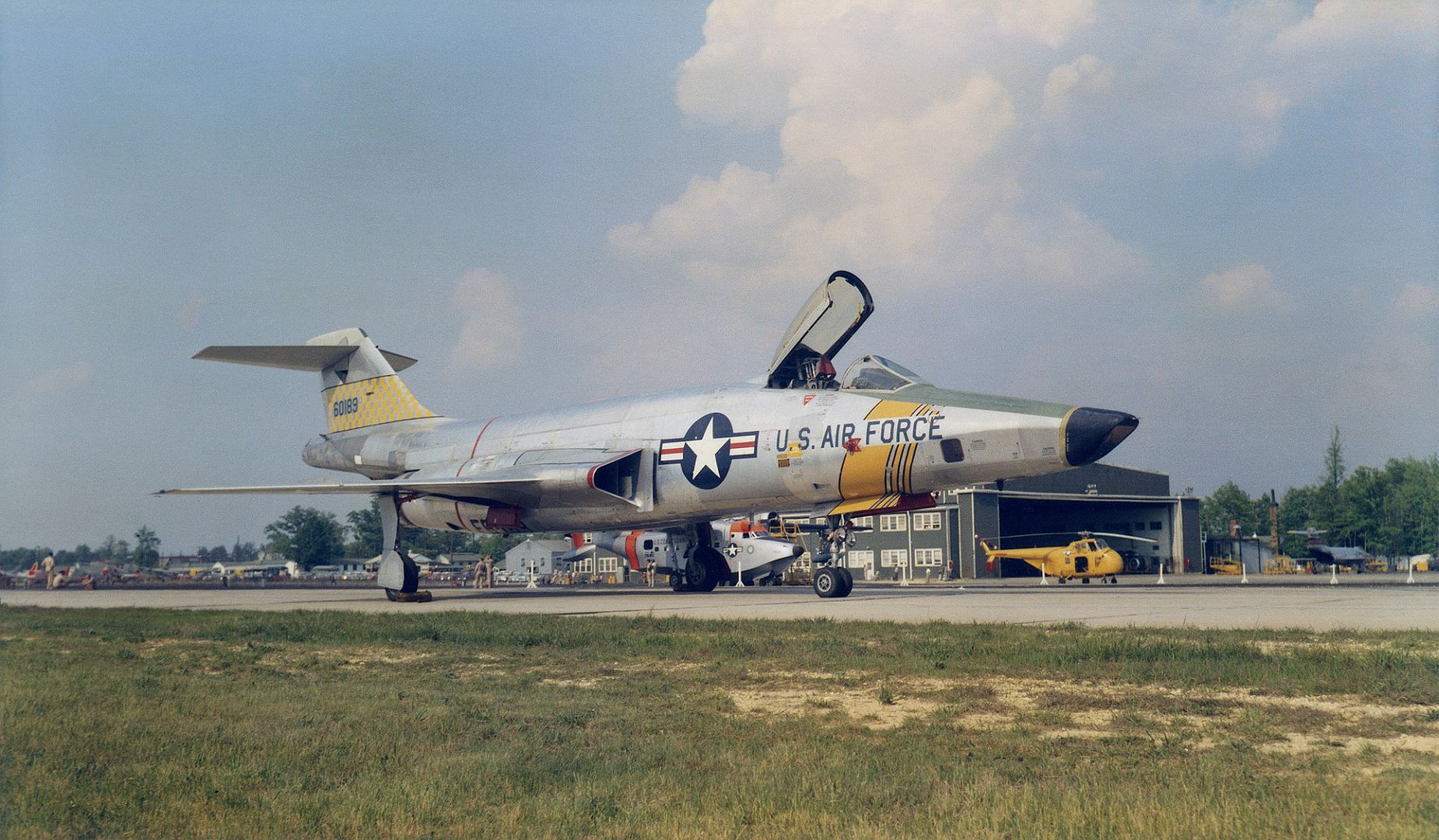

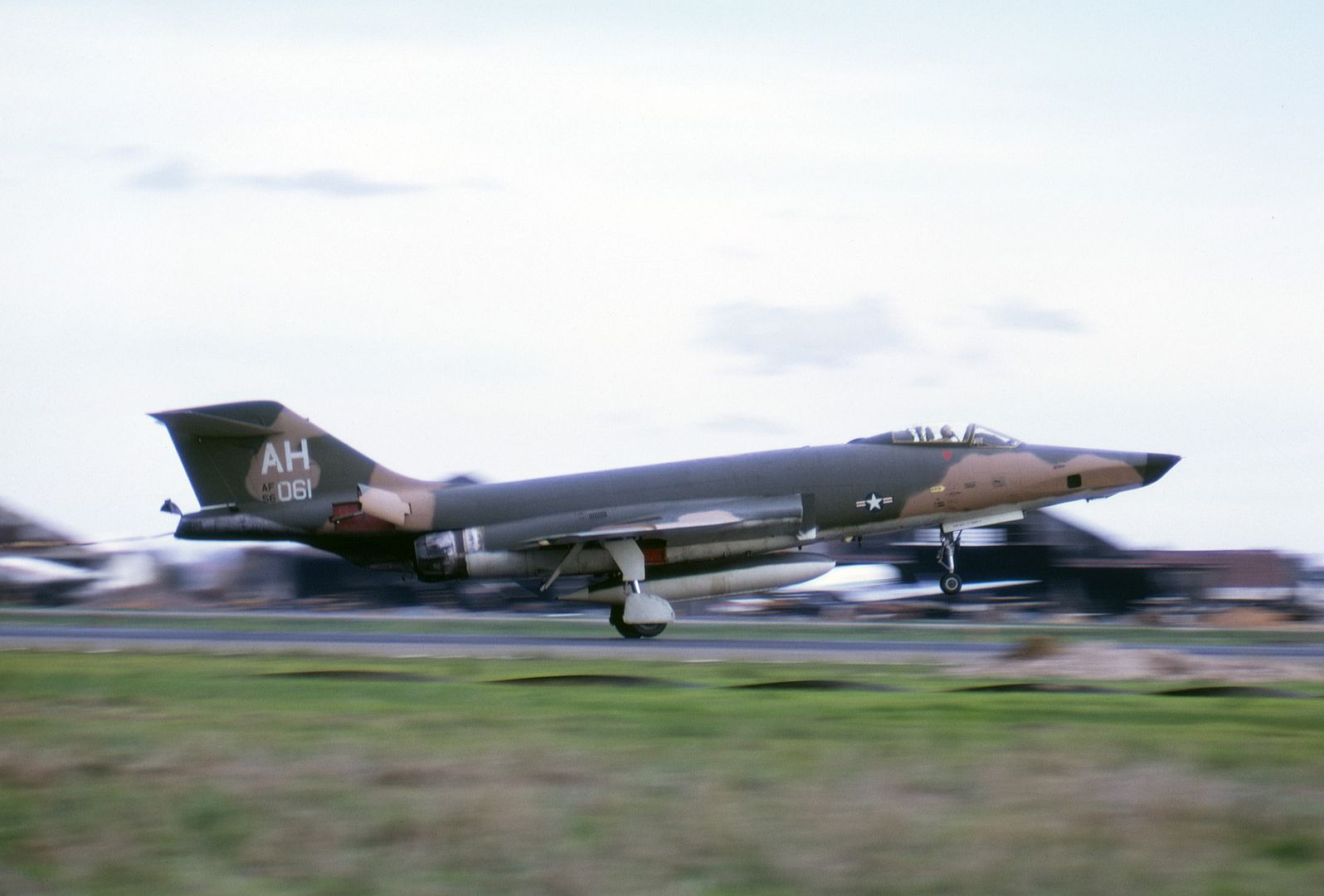

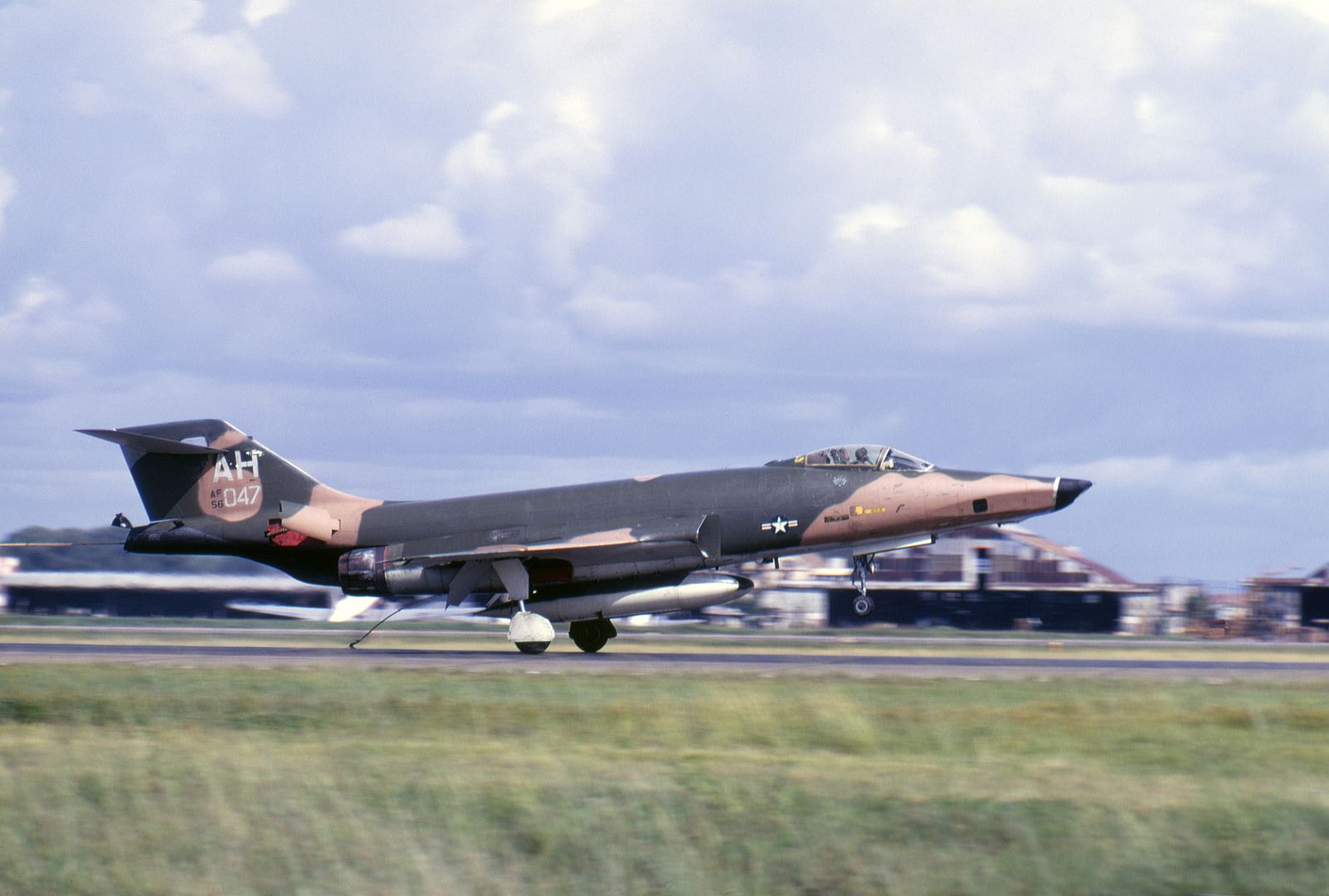
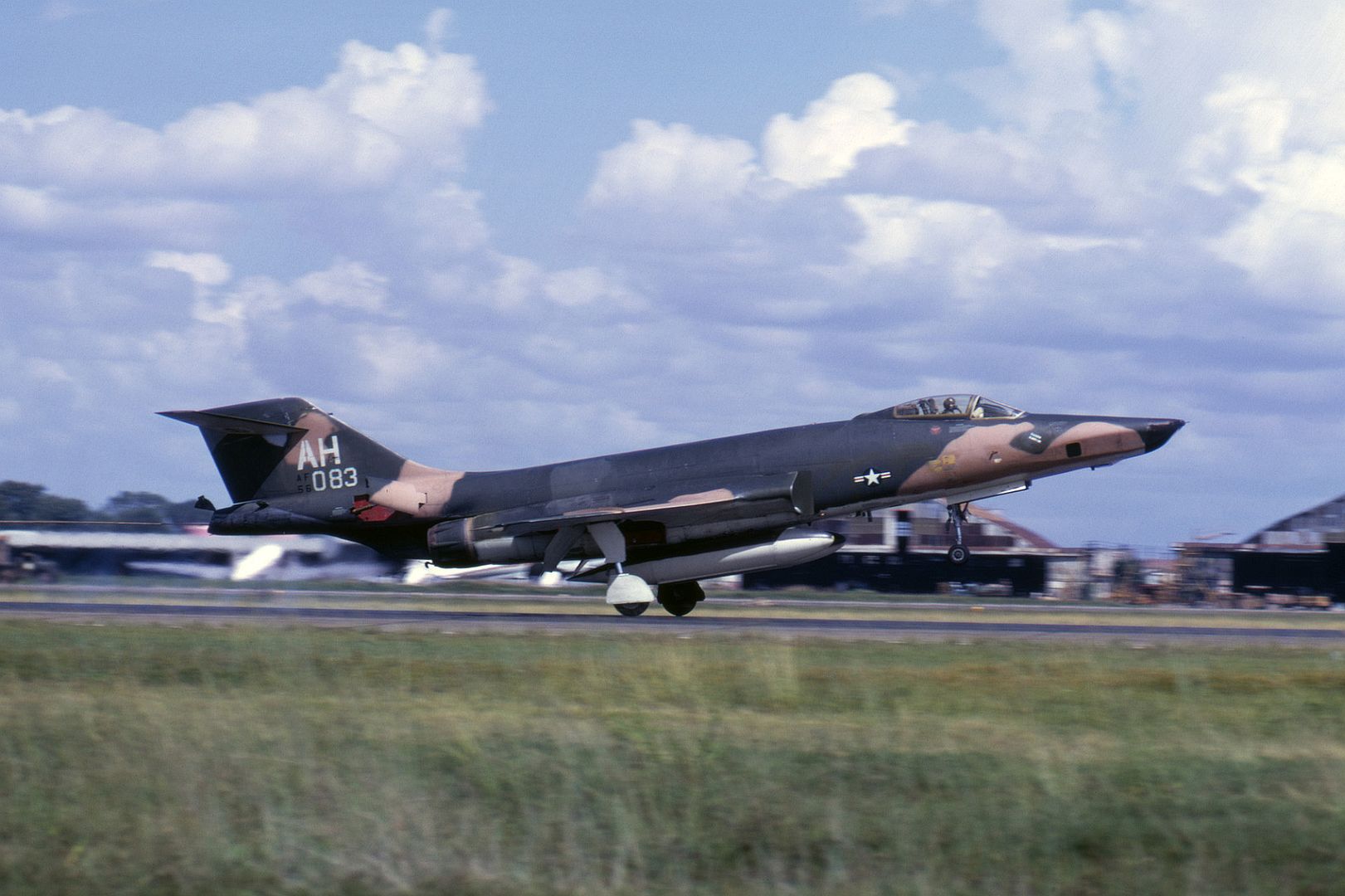
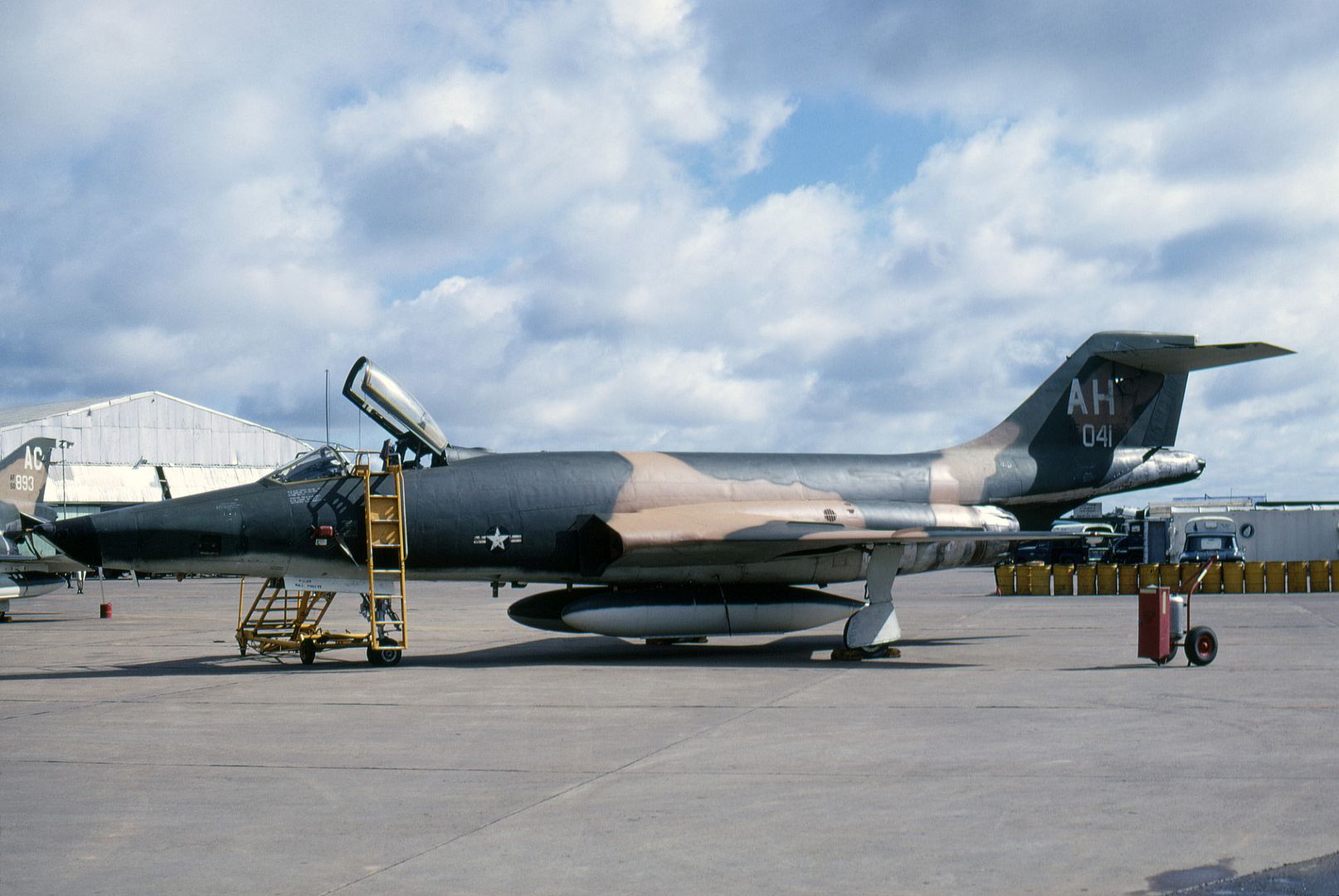
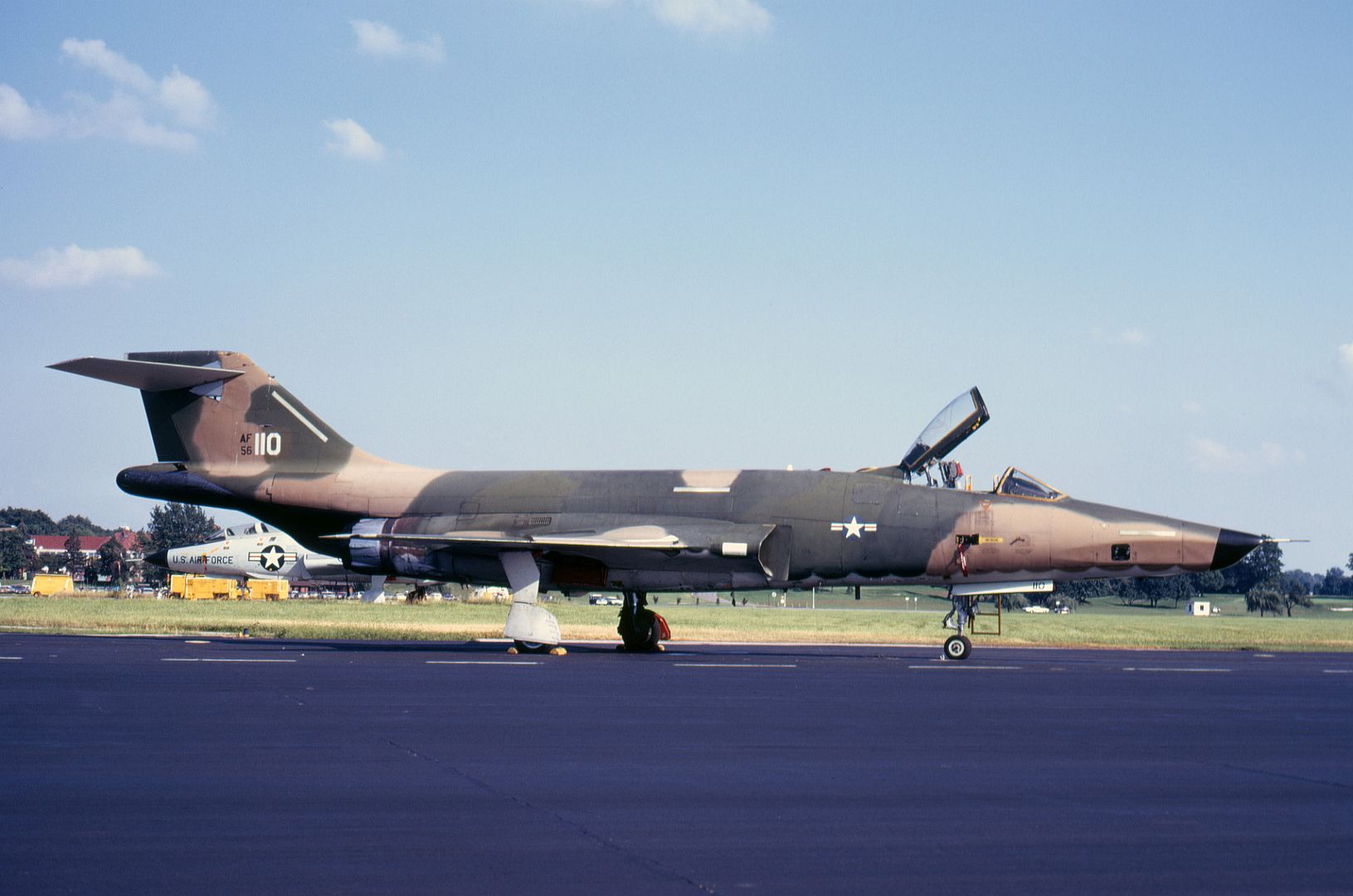

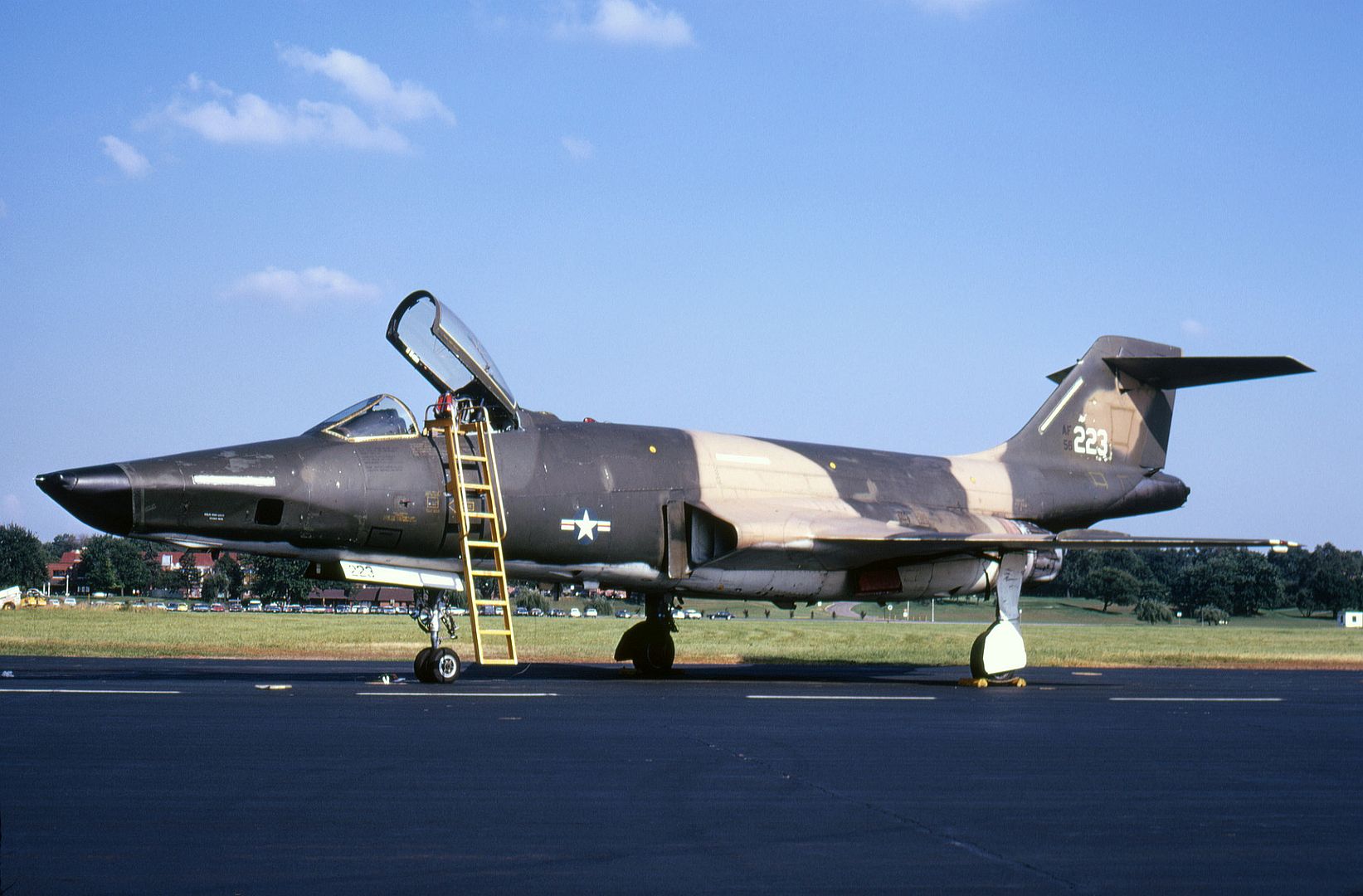
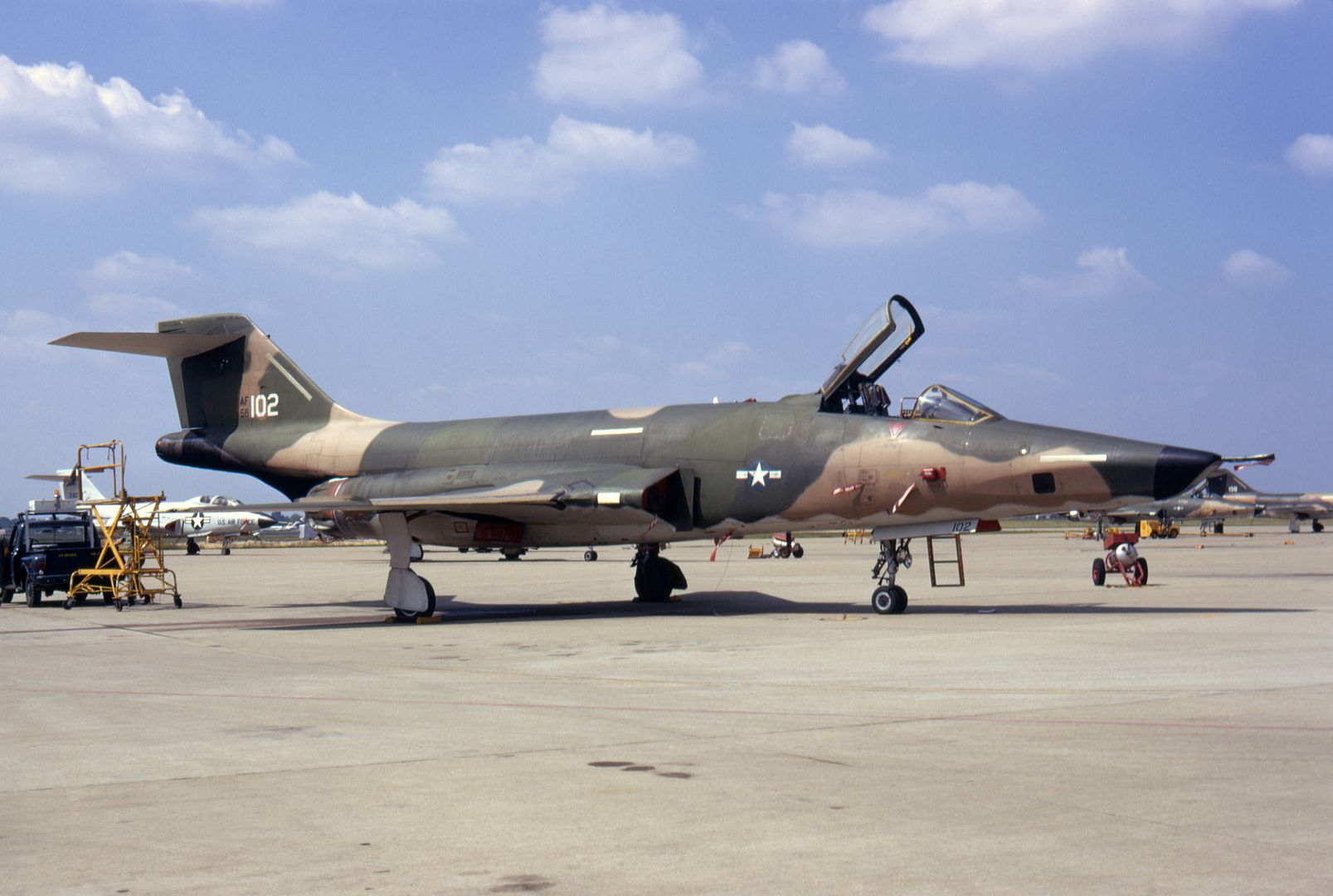
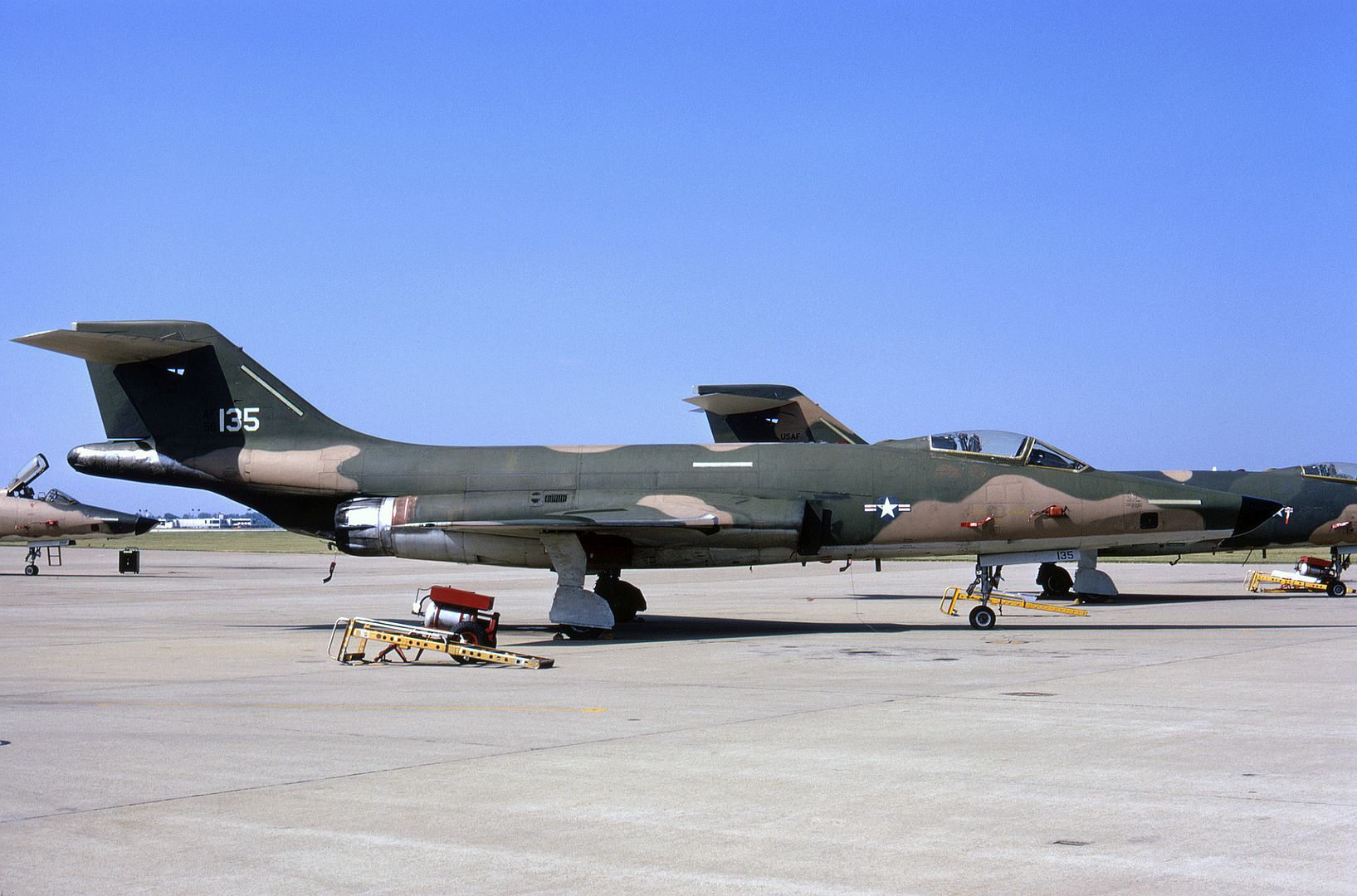

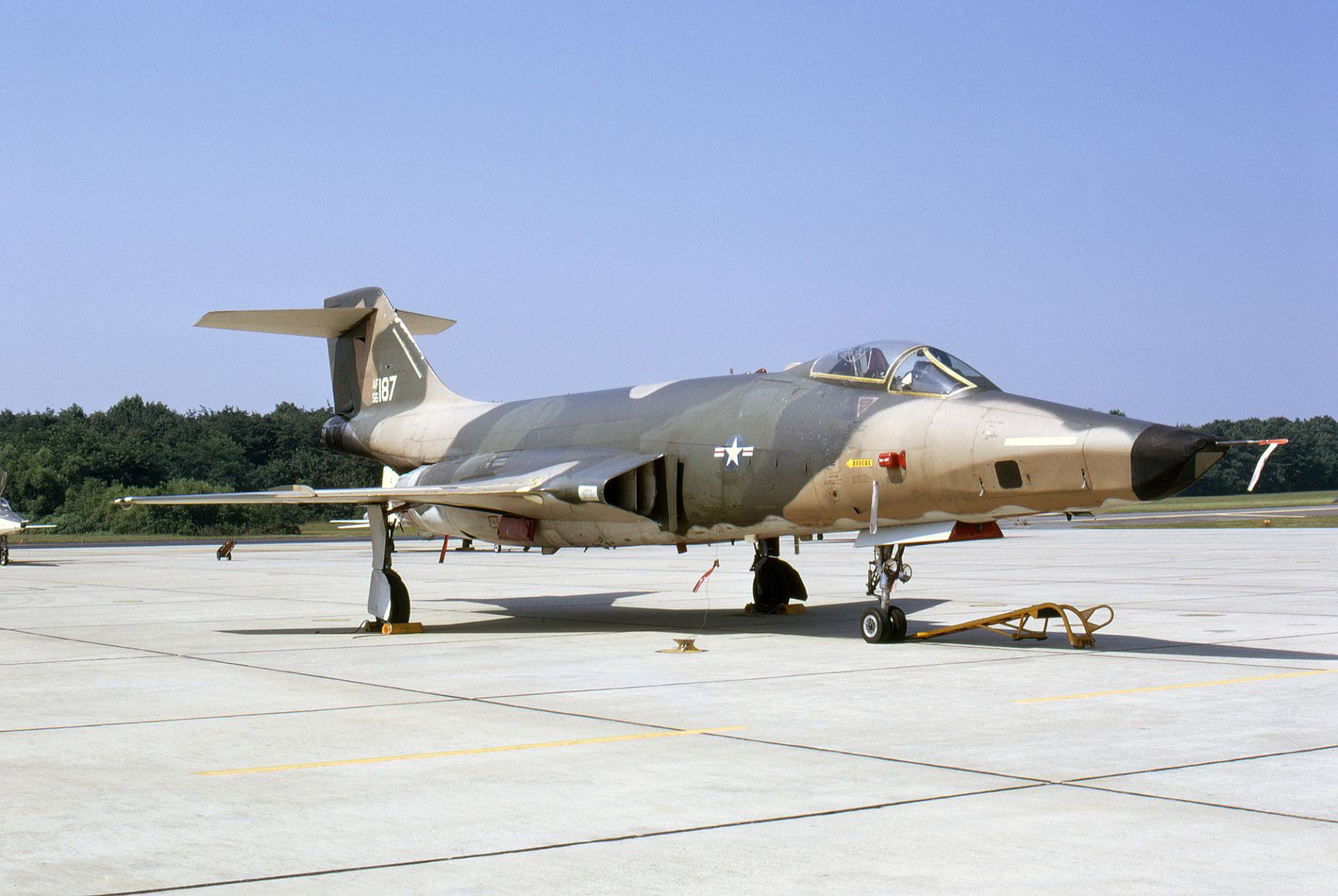

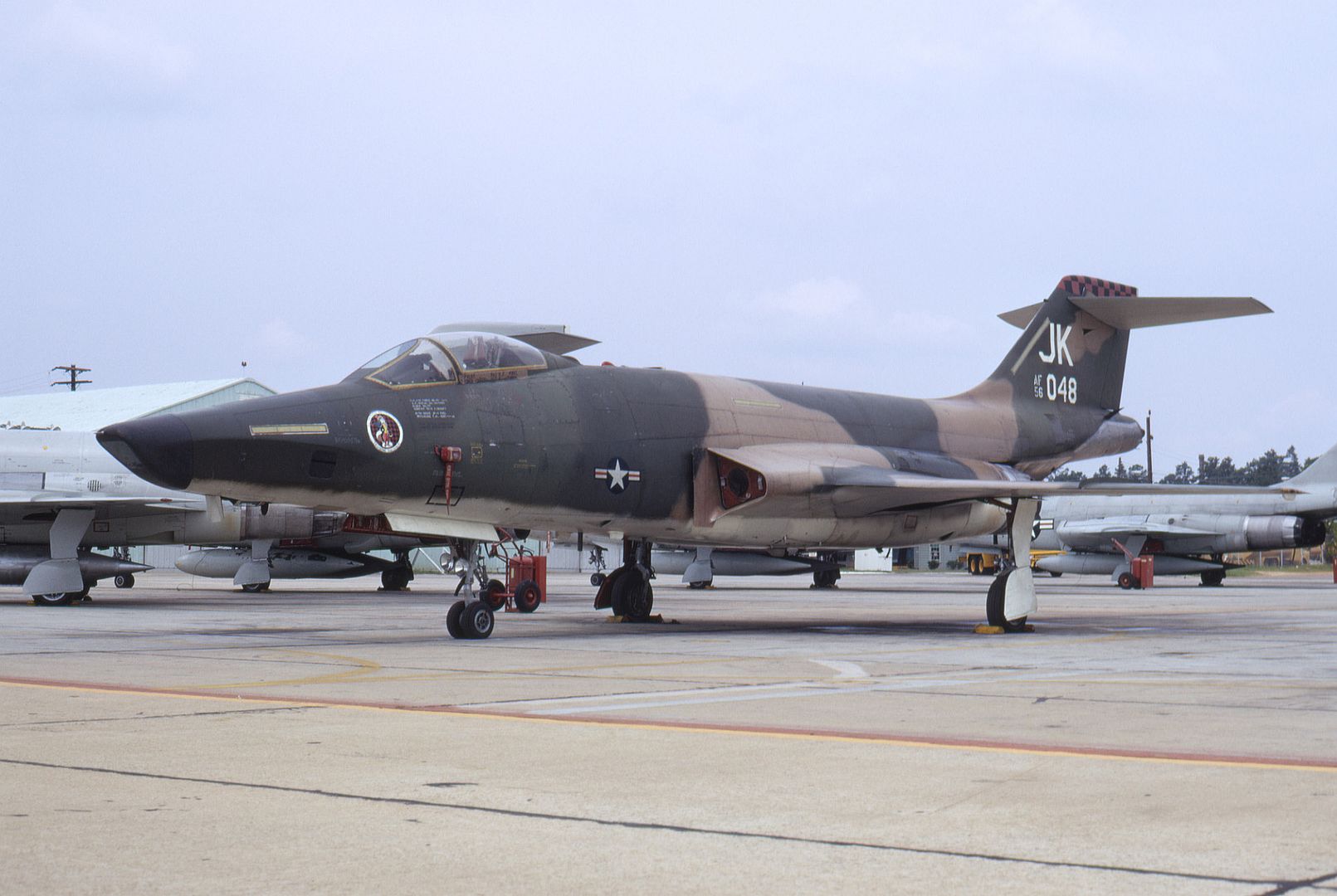
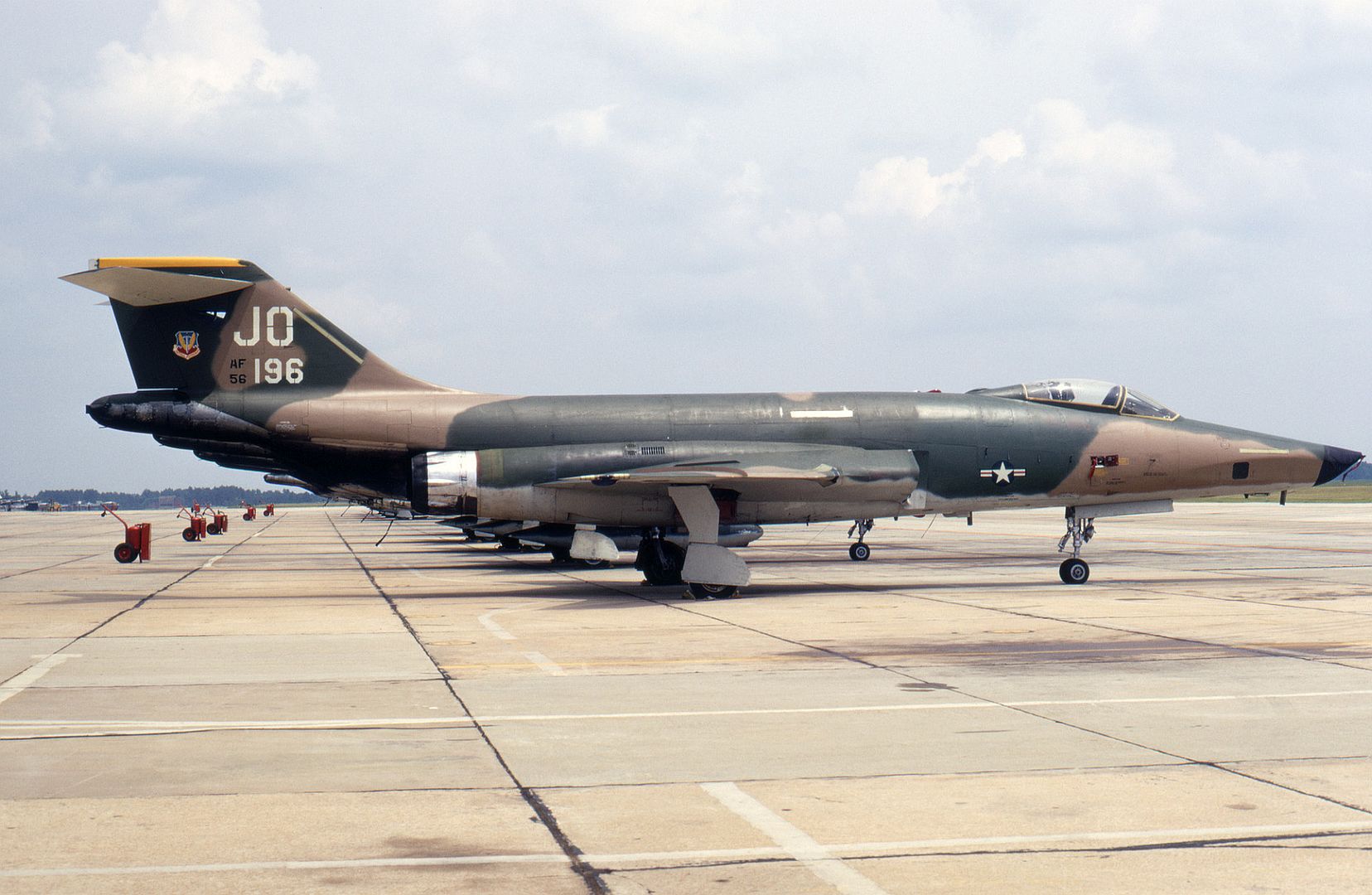
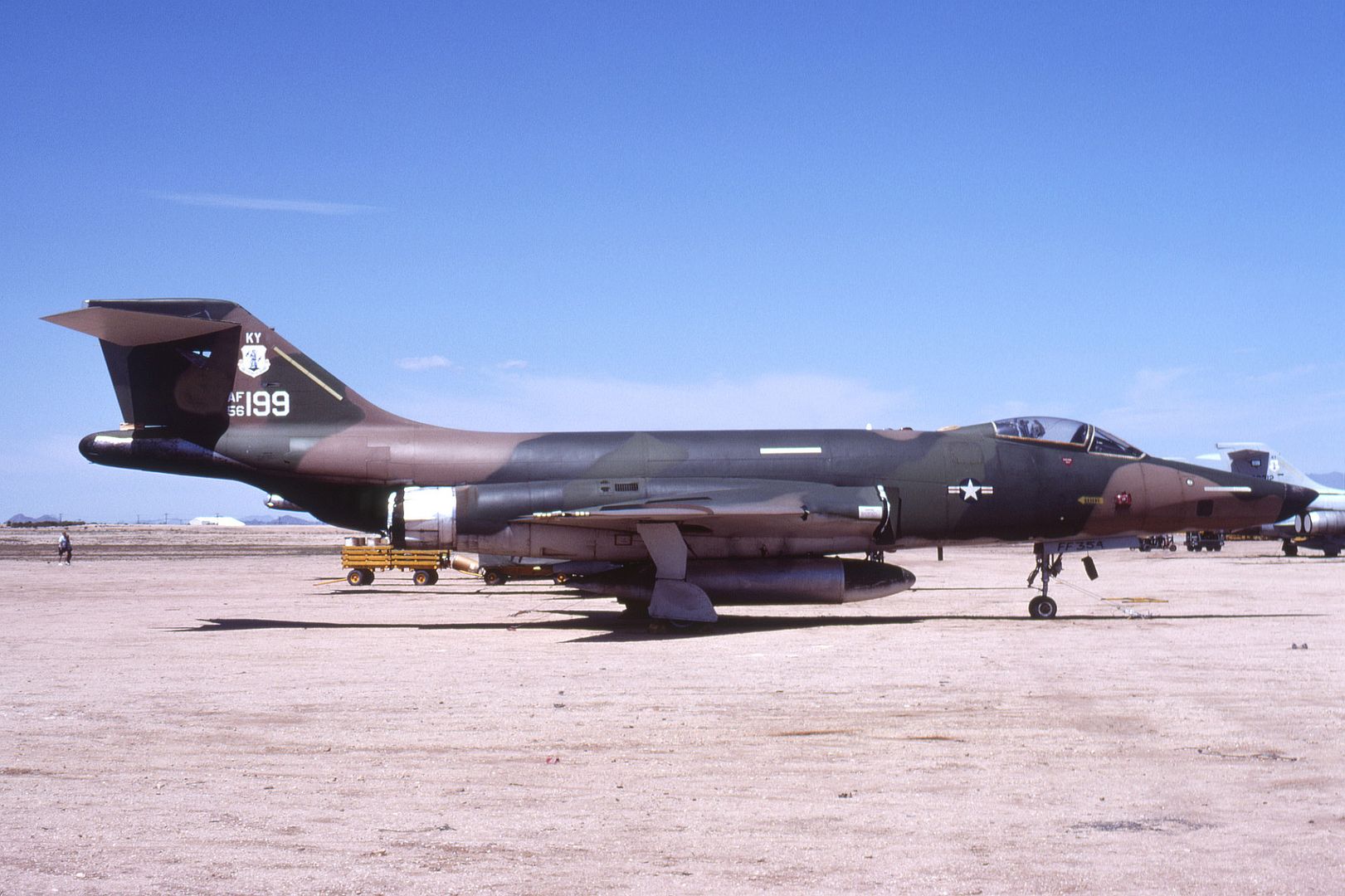
F-101D
proposed version with General Electric J79 engines, not built
F-101E
another J79 proposal, not built
F-101F
dual-control trainer version of F-101B; 79 re-designated TF-101Bs plus 152 converted F-101Bs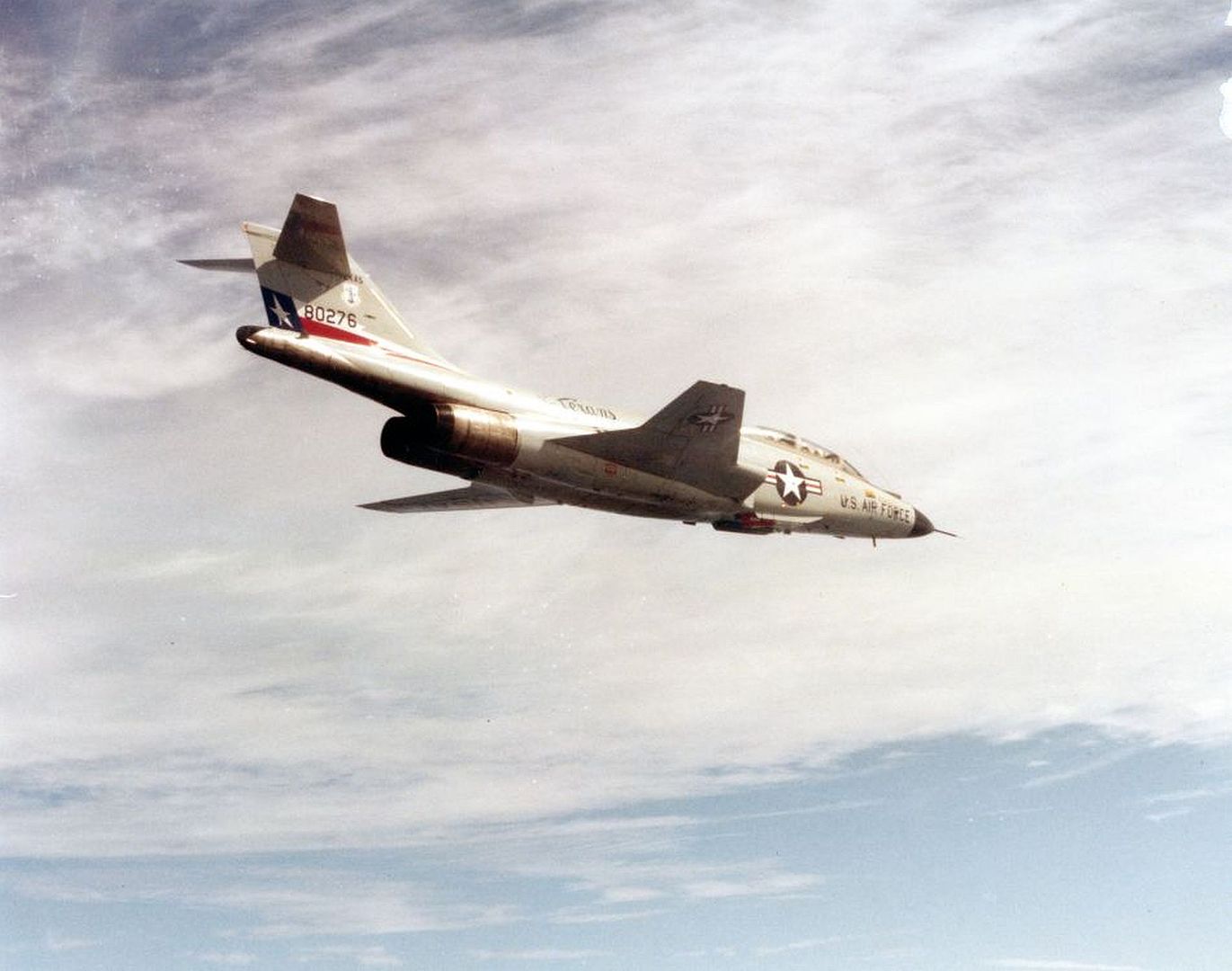
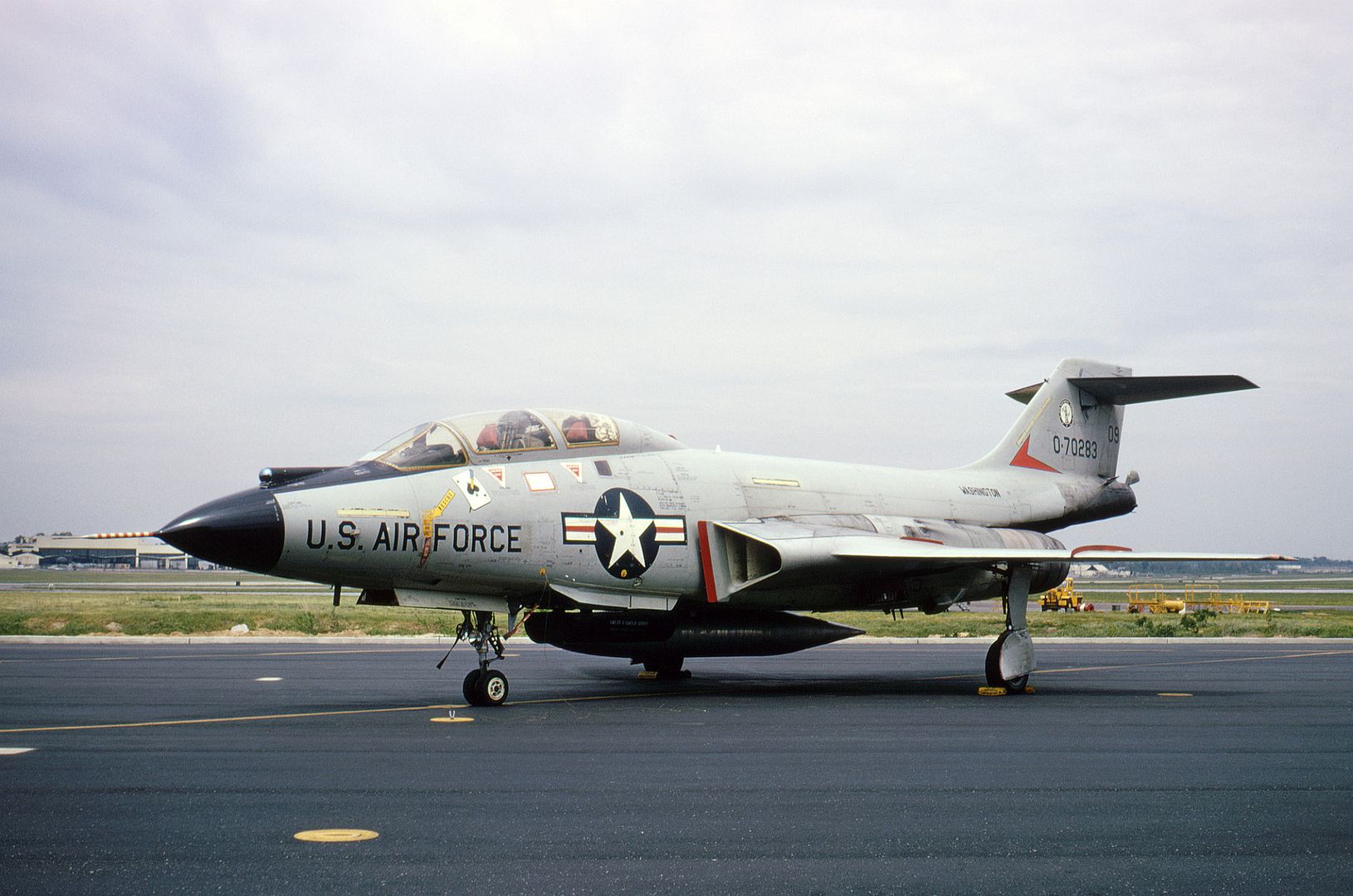
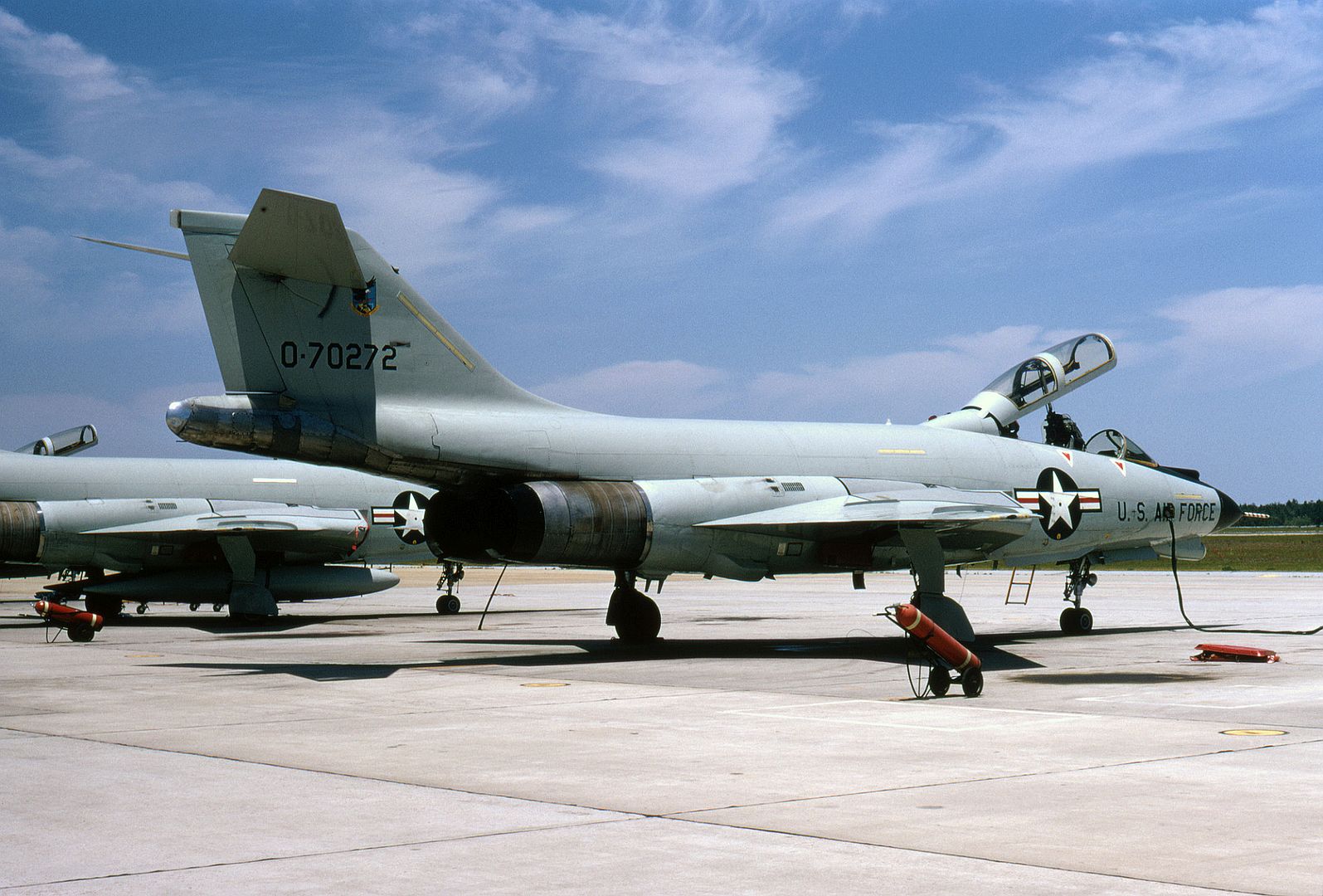
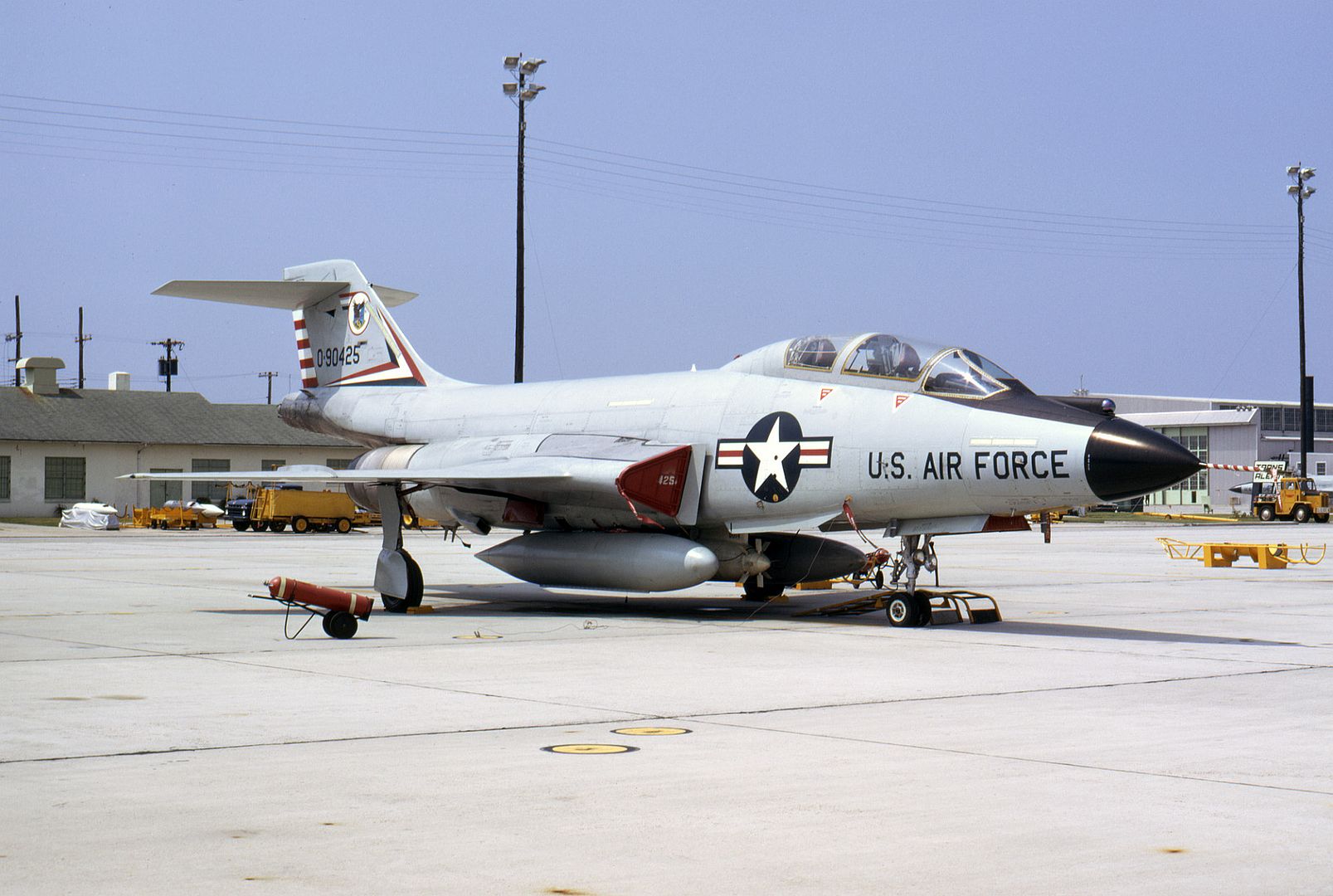
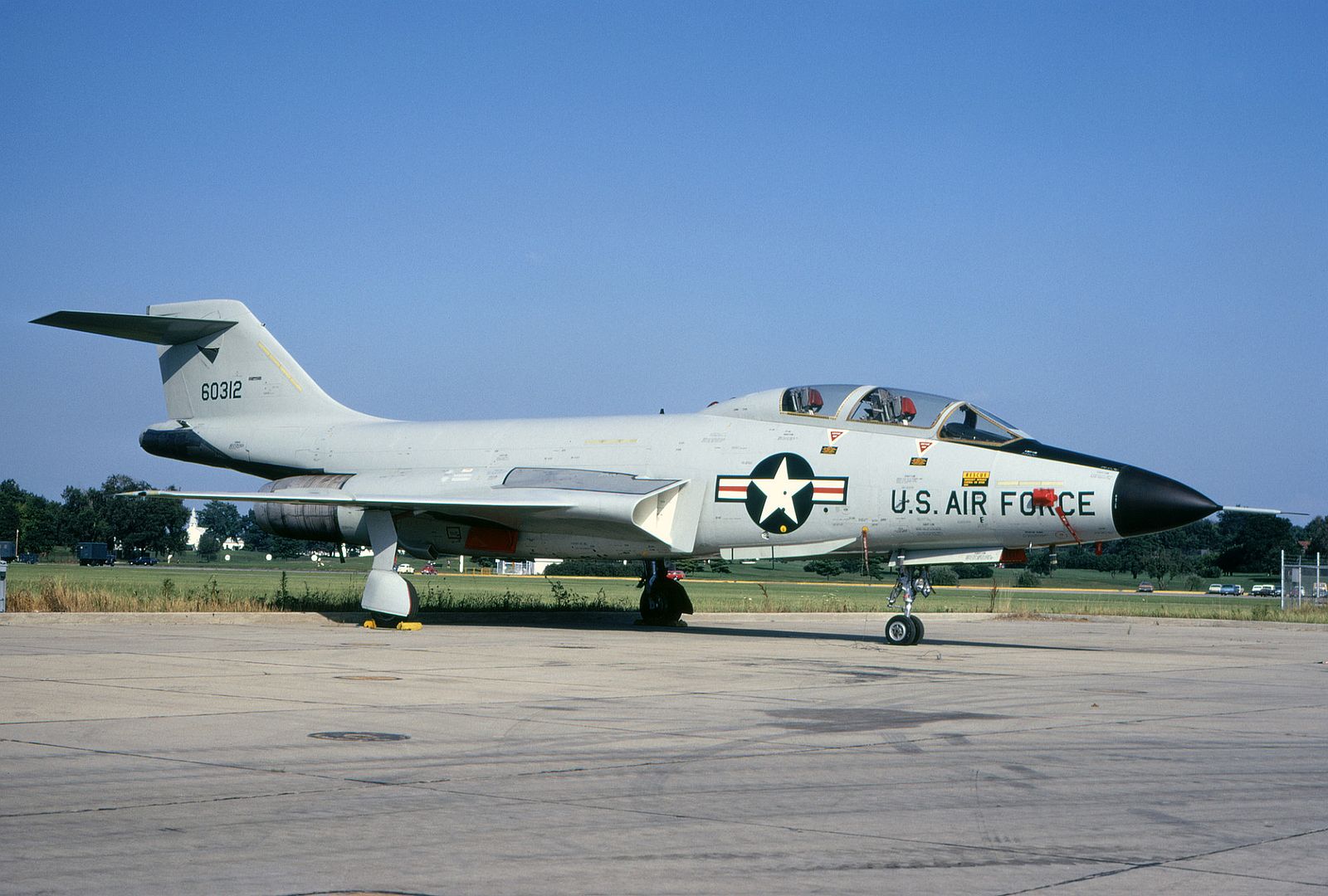
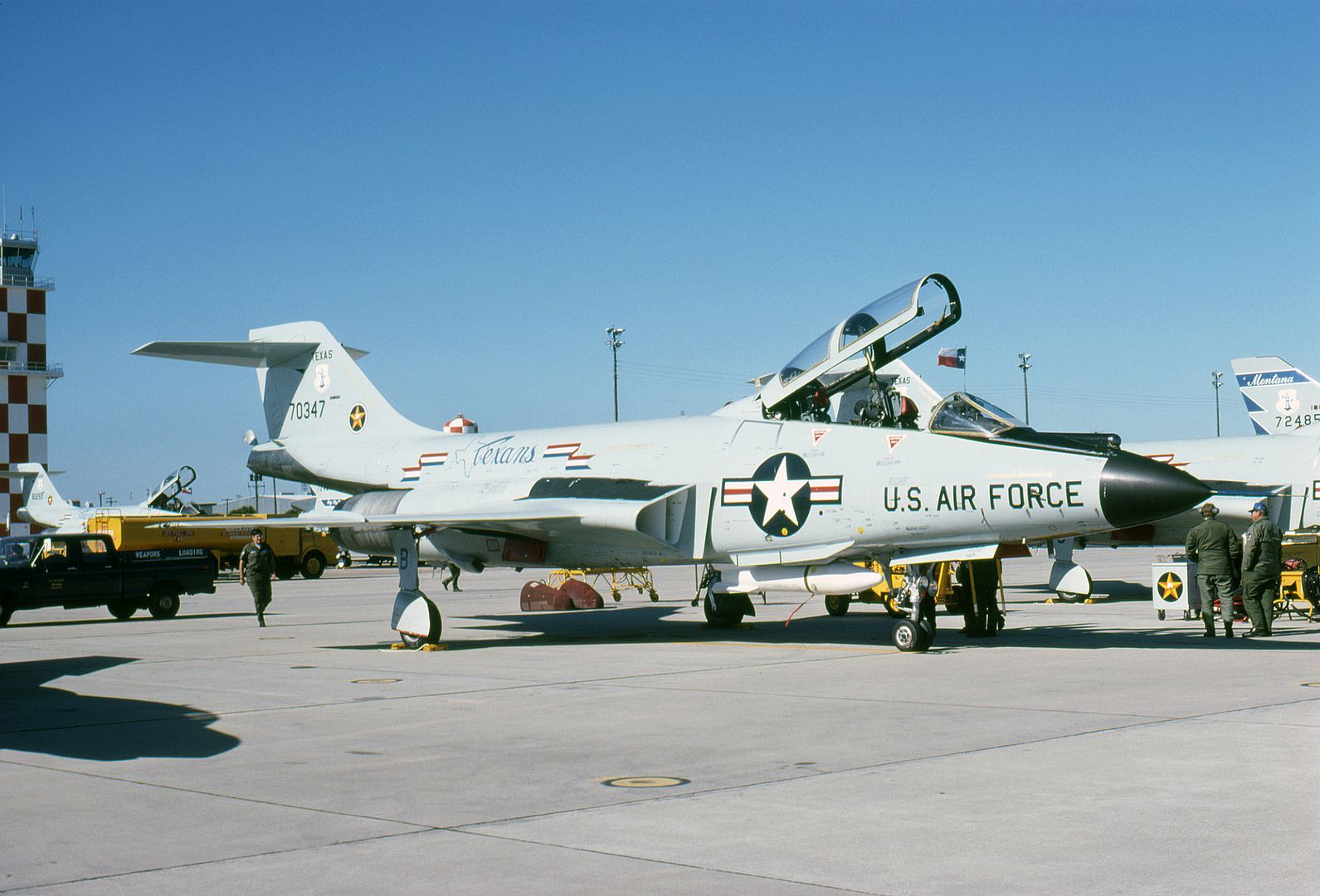
CF-101F
Canadian designation for 20 TF-101B/F-101F dual-control aircraft
TF-101F
24 dual-control versions of F-101B, re-designated F-101F (these are included in the -F total)
RF-101G
29 F-101As converted for ANG reconnaissance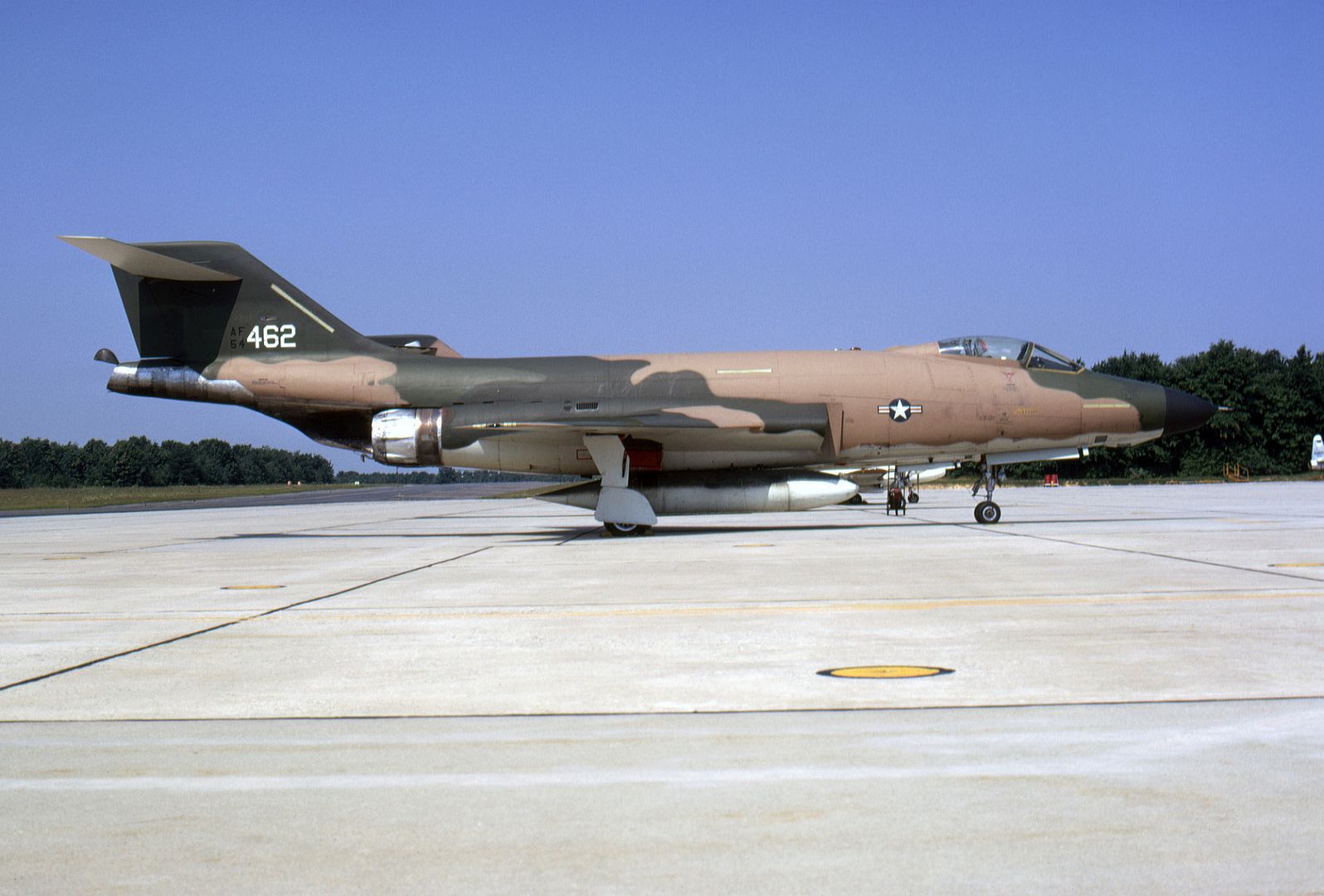
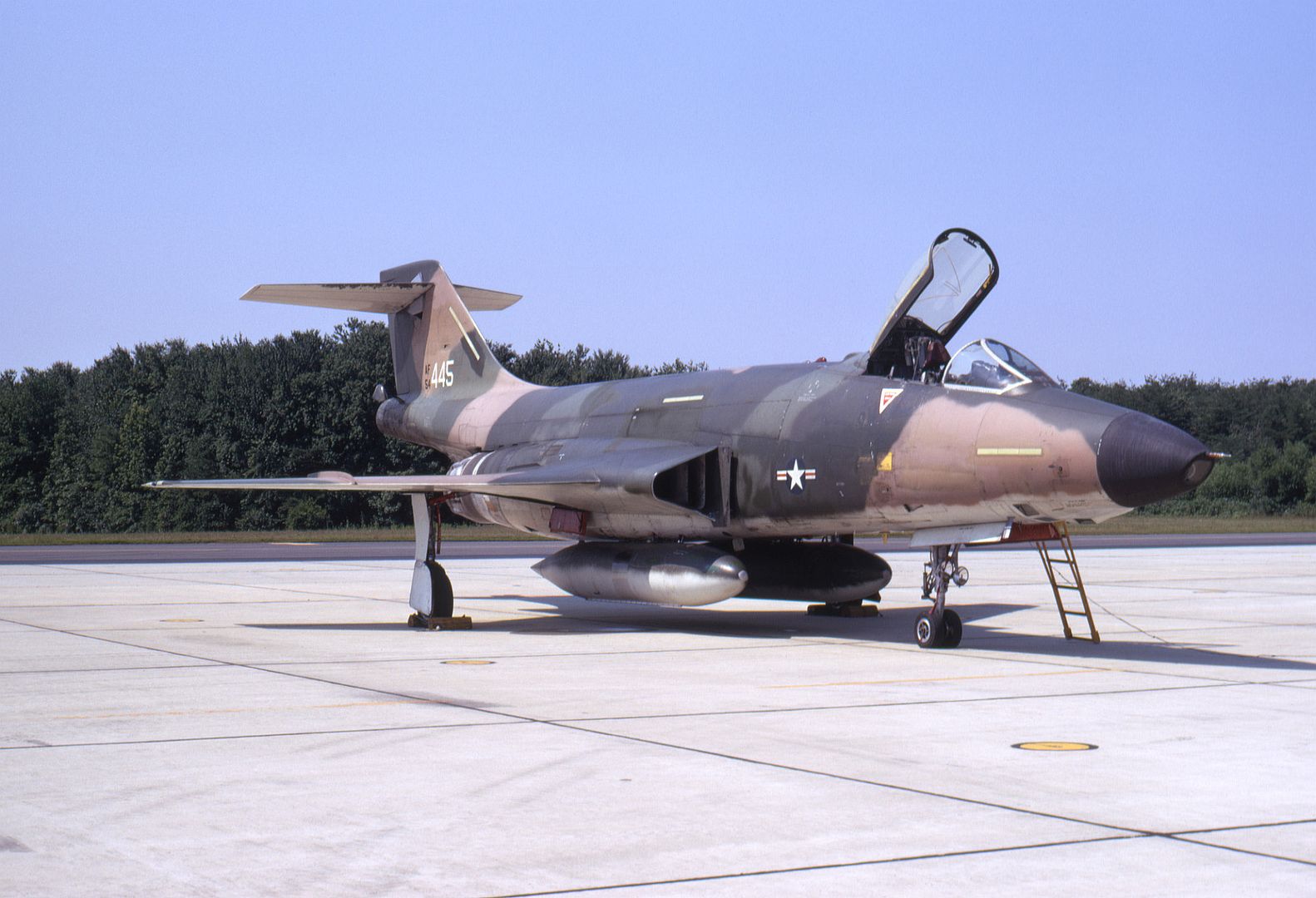
RF-101H
32 F-101Cs converted for reconnaissance use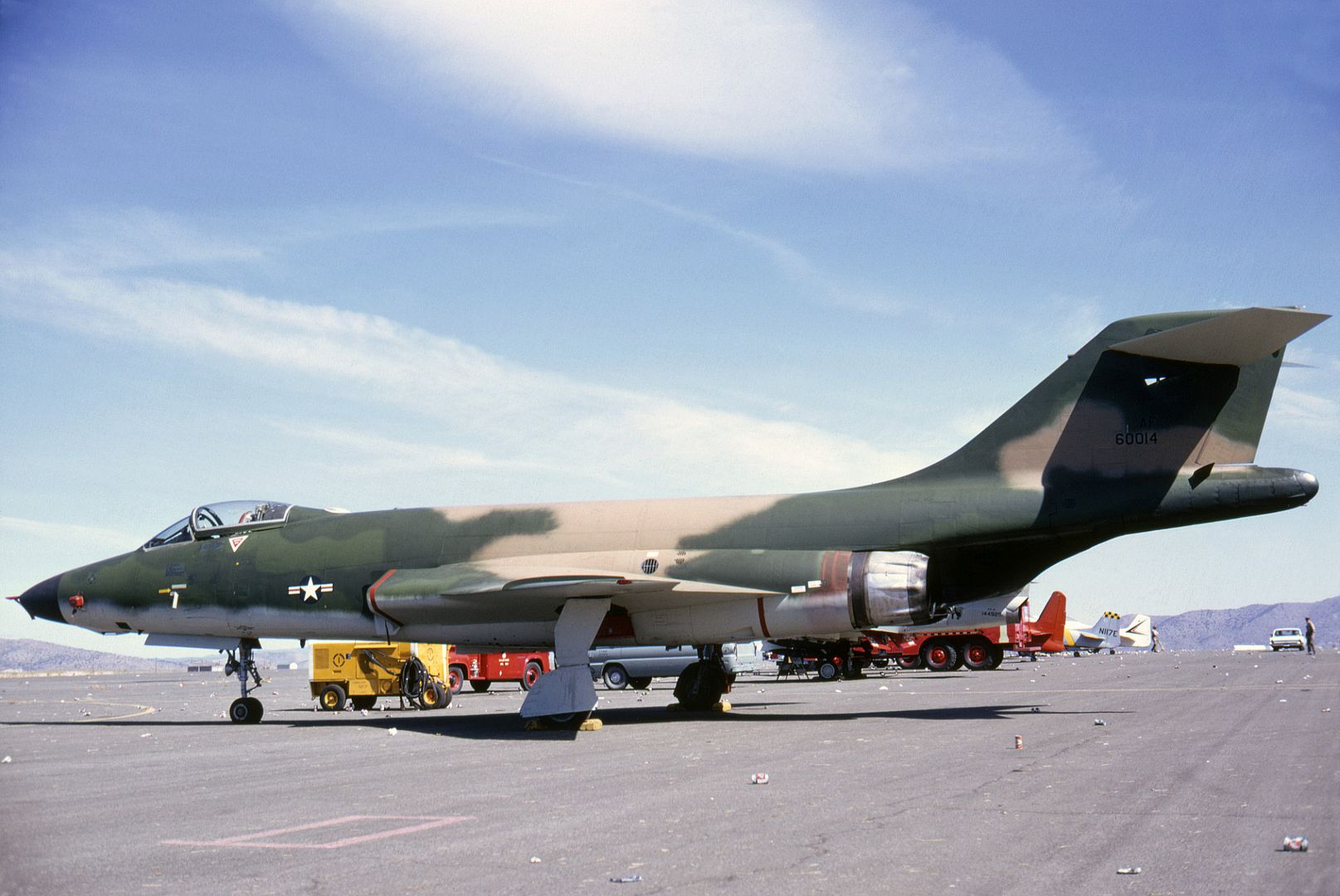
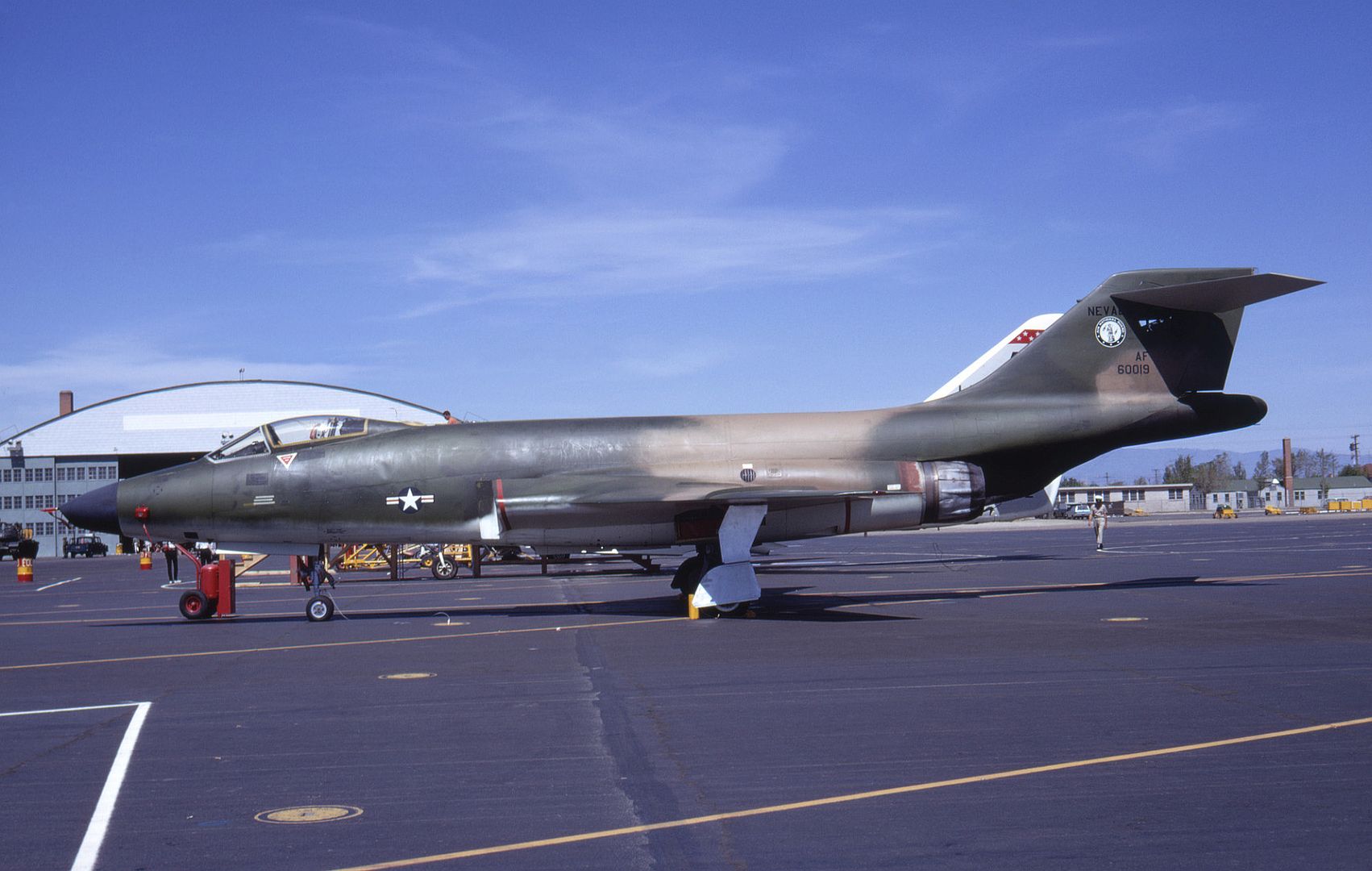

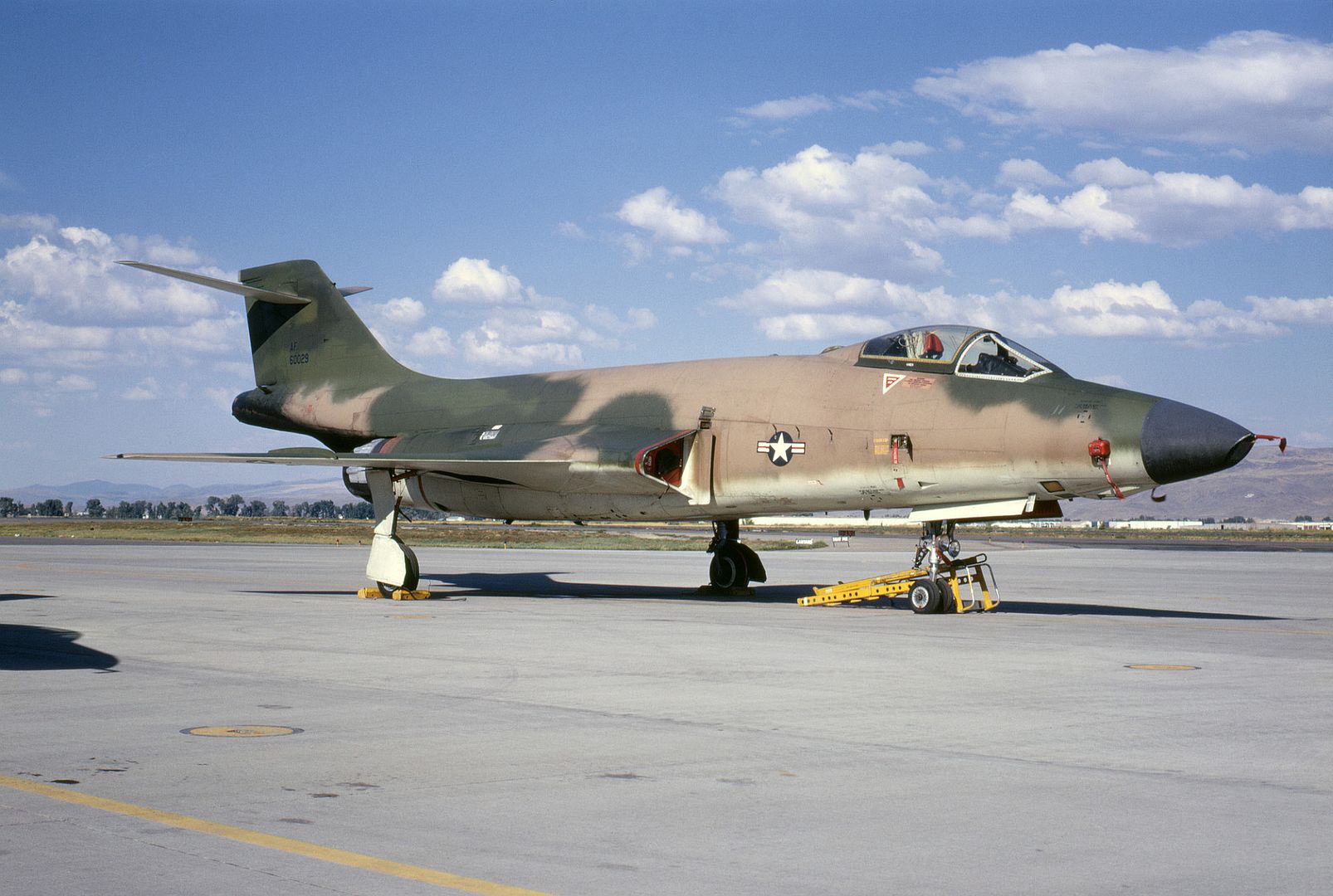
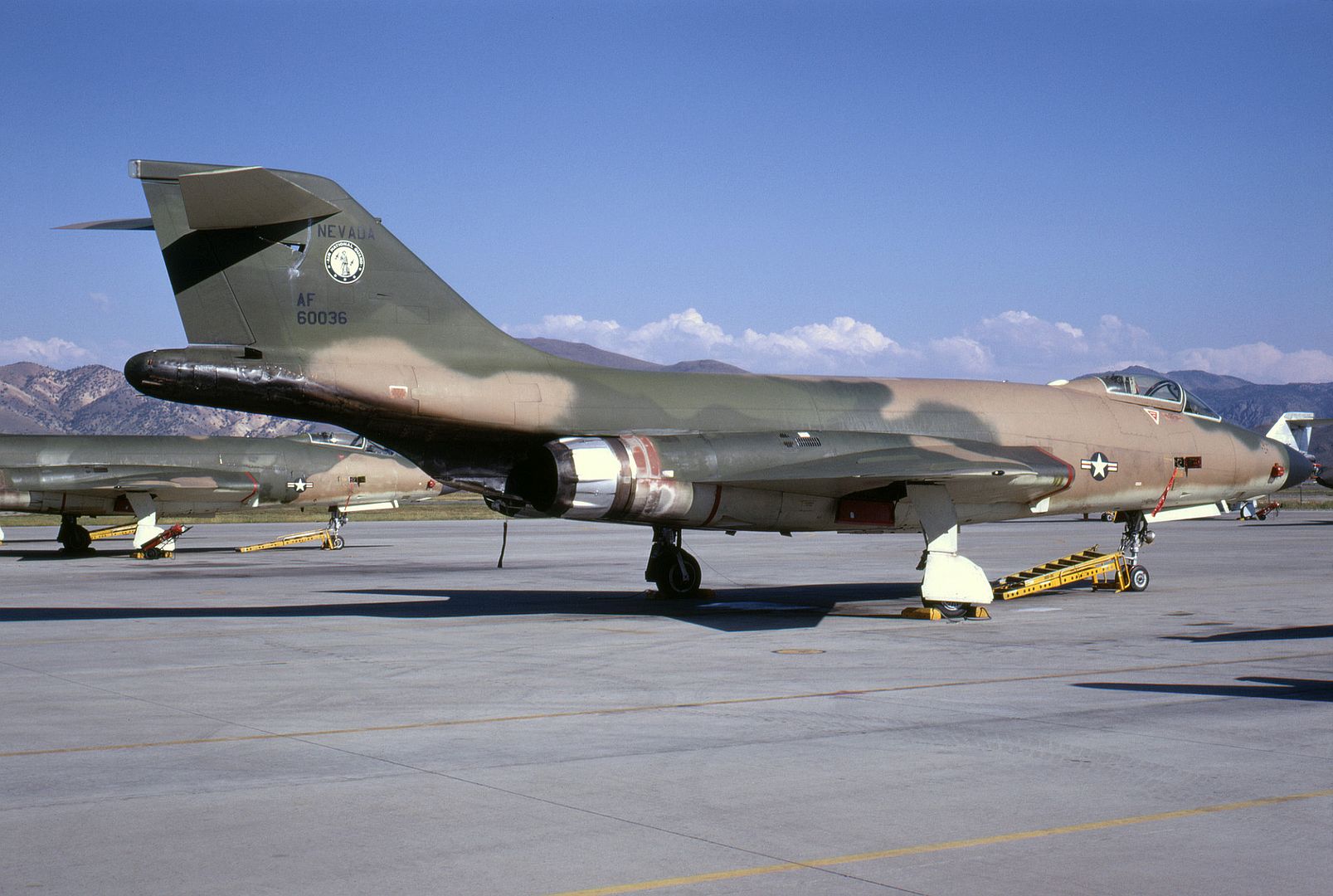
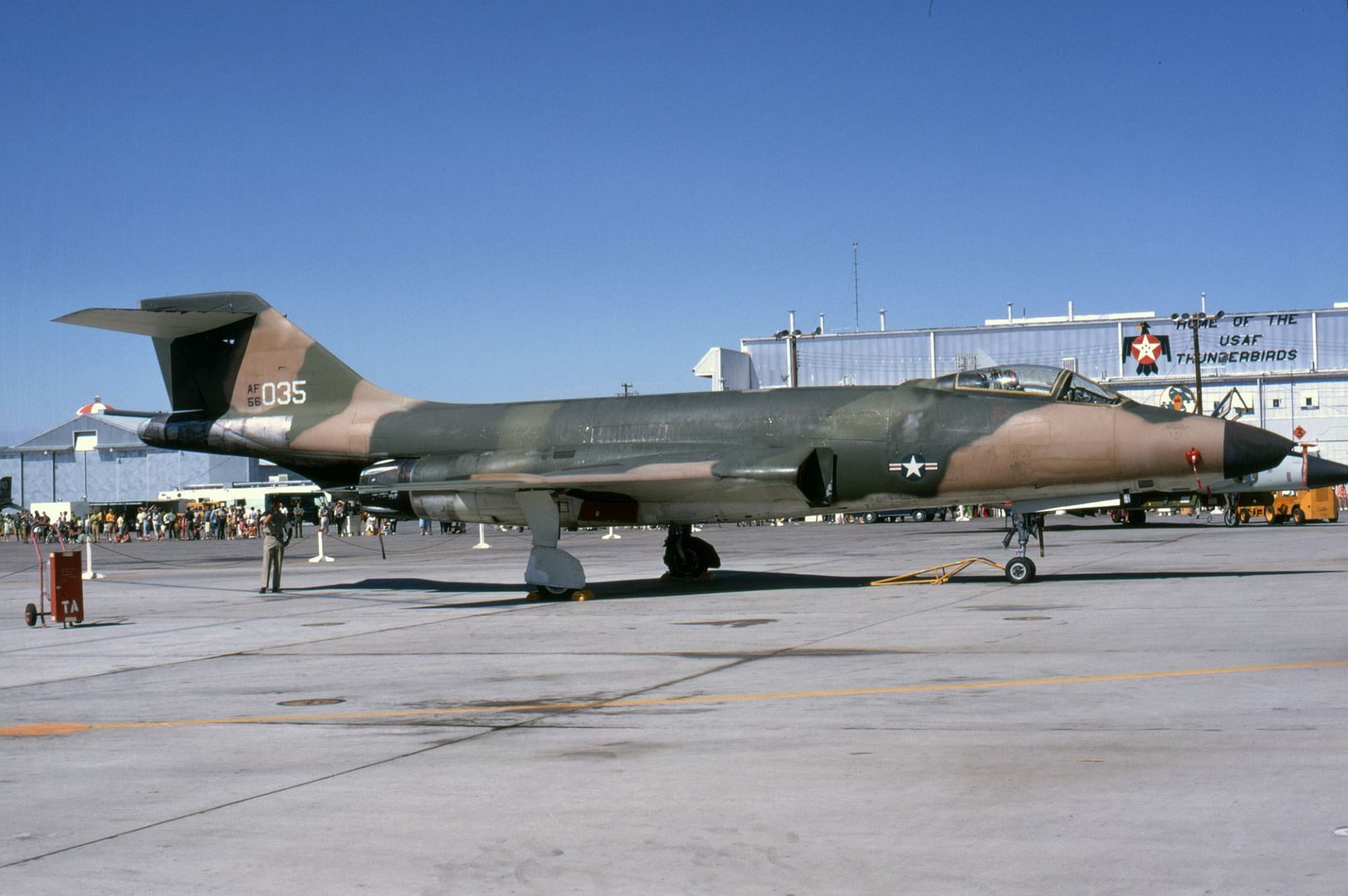
Specifications (F-101B)
General characteristics
Crew: 2
Length: 67 ft 5 in (20.55 m)
Wingspan: 39 ft 8 in (12.09 m)
Height: 18 ft 0 in (5.49 m)
Wing area: 368 sq ft (34.2 m2)
Airfoil: root: NACA 65A007 (modified); tip: NACA 65A006 (modified)[43]
Empty weight: 28,495 lb (12,925 kg)
Gross weight: 45,665 lb (20,713 kg)
Max takeoff weight: 52,400 lb (23,768 kg)
Fuel capacity: 2,053 US gal (1,709 imp gal; 7,770 l) internals plus 2x optional 450 US gal (370 imp gal; 1,700 l) drop-tanks
Powerplant: 2 × Pratt & Whitney J57-P-55 afterburning turbojet engines, 11,990 lbf (53.3 kN) thrust each dry, 16,900 lbf (75 kN) with afterburner
Performance
Maximum speed: 1,134 mph (1,825 km/h, 985 kn) at 35,000 ft (11,000 m)
Maximum speed: Mach 1.72
Range: 1,520 mi (2,450 km, 1,320 nmi)
Service ceiling: 58,400 ft (17,800 m)
Rate of climb: 36,500 ft/min (185 m/s)
Wing loading: 124 lb/sq ft (610 kg/m2)
Thrust/weight: 0.74
Armament
Missiles:
4 (originally 6)× AIM-4 Falcon, or
2× AIR-2 Genie nuclear rockets, plus 2× AIM-4 Falcon
Avionics
Hughes MG-13 fire control system
Thanks to Ron Downey via Aviation Archives for the majority of photos -
 Main AdminThe McDonnell CF-101 Voodoo was an all-weather interceptor aircraft operated by the Royal Canadian Air Force and the Canadian Forces between 1961 and 1984. They were manufactured by the McDonnell Aircraft Corporation of St. Louis, Missouri for the United States Air Force (as F-101s), and later sold to Canada. CF-101s replaced the obsolete Avro CF-100 Canuck in the RCAF's all-weather fighter squadrons. The Voodoo's primary armament was nuclear AIR-2A Genie unguided air-to-air rockets, and there was significant political controversy in Canada about their adoption. Although they never fired a weapon in wartime, the CF-101 served as Canada's primary means of air defence from Quick Reaction Alert facilities at Canadian airbases. The CF-101s were retired in the 1980s and replaced with McDonnell Douglas CF-18 Hornet fighters. Many examples are preserved in museums and parks in Canada and the United States.
Main AdminThe McDonnell CF-101 Voodoo was an all-weather interceptor aircraft operated by the Royal Canadian Air Force and the Canadian Forces between 1961 and 1984. They were manufactured by the McDonnell Aircraft Corporation of St. Louis, Missouri for the United States Air Force (as F-101s), and later sold to Canada. CF-101s replaced the obsolete Avro CF-100 Canuck in the RCAF's all-weather fighter squadrons. The Voodoo's primary armament was nuclear AIR-2A Genie unguided air-to-air rockets, and there was significant political controversy in Canada about their adoption. Although they never fired a weapon in wartime, the CF-101 served as Canada's primary means of air defence from Quick Reaction Alert facilities at Canadian airbases. The CF-101s were retired in the 1980s and replaced with McDonnell Douglas CF-18 Hornet fighters. Many examples are preserved in museums and parks in Canada and the United States.
[b]Origins[b]
After the cancellation of the CF-105 Arrow program in February 1959, George Pearkes, the Canadian Minister of National Defence officially maintained that the existing Avro CF-100 interceptors and the Bomarc missiles that had been ordered in September 1958 would be adequate for Canada's air defense needs. Unofficially, it was recognized that there was still a bomber threat, and discussions had been underway since before the formal conclusion of the Avro Arrow program concerning the RCAF acquiring an "off-the-shelf" interceptor from the United States.
The USAF indicated that it was prepared to make 56 F-101B interceptors and 10 F-101F trainers available (by employing Convair F-102 Delta Daggers in less demanding NORAD sectors) for Canadian purchase. The deal was delayed for over a year by negotiations over acquisition costs and offsets, as well as debate within the Diefenbaker government about Canada adopting nuclear weapons systems, which had been agreed to, in principle, in 1958. The financial arrangements were sorted out by Canada taking over the staffing and funding of 11 Pinetree Line radar stations within Canada that had formerly been operated and funded by the USAF. A detailed agreement signed in June 1961 covered the transfer of the aircraft, meant to equip five front-line squadrons (replacing nine CF-100 squadrons) and an Operational Training Unit (OTU).
Operational history
On 24 July 1961, the first two aircraft were transferred to Canada in a ceremony at RCAF Uplands in Ottawa, marking the beginning of Operation Queen's Row. 425 Squadron officially began Voodoo operations at RCAF Namao, Alberta, on 15 October 1961, initially acting as the conversion training squadron for 410, 416, 409, and 414 Squadrons. No. 425 Squadron then became an operational unit itself, turning the conversion role over to No. 3 All Weather OTU at RCAF Bagotville, Quebec. By the end of 1962, the squadrons were operating out of RCAF Comox, British Columbia, (409 Squadron), RCAF North Bay, Ontario, (414 Squadron), RCAF Uplands, Ottawa, Ontario, (410 Squadron), RCAF Bagotville, Quebec, (425 Squadron), and RCAF Chatham, New Brunswick, (416 Squadron). Defence cuts in 1964 eliminated Nos. 410 and 414 Squadrons (although a reformed 414 Squadron would operate the Voodoo years later).
CF-101 Voodoo 101060 from 409 "Nighthawk" Squadron, CFB Comox on the ramp at CFB Moose Jaw in 1982
Each Voodoo base was laid out to allow aircraft to be kept at immediate readiness at all times. A Quick Reaction Alert (QRA) facility was positioned at the end of the main runway to allow alert aircraft to launch as quickly as possible. Two aircraft and their crews were always on "five minute" alert — the aircraft were to be in the air, en route to intercept unknown aircraft, within five minutes of receiving the order. In one instance, 416 Squadron was able to get two alert aircraft in the air only 57 seconds after receiving the alert. Voodoos were dispatched with some regularity to intercept unidentified NORAD radar contacts, usually airliners flying off course, although 416 and 425 occasionally intercepted Soviet Tu-95 Bear bombers flying along the Atlantic coast to Cuba. Fortunately, no situation ever arose in which a CF-101 pilot fired his weapons in anger.
Between 1970 and 1972, Canada traded the 56 survivors of the original CF-101 fleet back to the USAF for 66 replacements under Operation Peace Wings. The "new" replacement aircraft were actually manufactured earlier than the original fleet, but the "new" airframes had a lower number of hours, plus the "new" Voodoos received updates which the original Canadian Voodoos had not received (including the addition of an IR tracking system). Bristol Aerospace of Winnipeg, Manitoba, performed modifications on the incoming fleet, which involved transferring some specifically Canadian items of equipment, including engines, from the "old" aircraft to the "new." Many of the "old" Canadian Voodoos were scrapped when they returned to the U.S., but 22 were converted to RF-101B photo-reconnaissance versions and flew with the Nevada Air National Guard until 1975.
During its service, the CF-101 was a popular performer at airshows and other events in Canada and the United States; displays ranged from a single aircraft's appearance to an entire squadron. In 1967, a CF-101 flew (in company with a CF-104 and The Red Knight T-33) in the Golden Centennaires display team to mark the nation's Centennial. In 1984, each squadron painted a special "show" aircraft to commemorate the type's impending retirement. 409 Squadron produced "Hawk One Canada," 416 Squadron produced "Lynx One Canada," and 425 Squadron produced "Lark One Canada/Alouette Un Canada."
Obsolescence and retirement
Through the 1970s, the increasing obsolescence of the CF-101 and the CF-104 led to the New Fighter Aircraft program. Launched in 1977, the program sought a replacement for the CF-5, CF-104 Starfighter, and CF-101 Voodoo. The Grumman F-14 Tomcat, F-15 Eagle, F-16 Falcon, McDonnell Douglas F/A-18 Hornet, Panavia Tornado, Dassault Mirage F1, and the Mirage 2000 were evaluated as potential replacements. Cost considerations reduced the choice to the F-16 and F-18; the F-18 was ultimately selected in April 1980. The Voodoo OTU converted to CF-18 Hornets in June 1982; 409 and 425 Squadrons also stood down in June 1984. In 1985 416 Squadron moved from CFB Chatham, New Brunswick to CFB Cold Lake, Alberta and converted from the CF-101 Voodoo to the CF-18 Hornet tactical fighter.With the stand down, the last nuclear weapons in Canada were returned to the United States.
Two Voodoos remained in service after the stand-down: the unique EF-101B electronic jamming aircraft (also known as the "Electric Voodoo") and a single CF-101F trainer, in service with 414 Squadron at North Bay, Ontario. The EF-101B was a conversion of a regular F-101B, incorporating the electronic jamming suite from an EB-57E Canberra. Only one aircraft was converted before the program was cancelled and this sole example was leased to Canada.The last two Voodoos continued to fly until April 1987, when they were finally retired.[The EF-101B was returned to the United States on 7 April 1987, while CF-101F 101006 made the world's last Voodoo flight on 9 April 1987, as it made a delivery flight from CFB North Bay to CFB Greenwood via CFB Bagotville and CFB Chatham for eventual display at CFB Cornwallis, Nova Scotia, where it decorated the parade square at the Recruit School.After CFB Cornwallis closed in 1995, 006 was moved to beside the Cornwallis Military Museum, located in the old St Georges Chapel on base. In October 2013, because of corrosion and security concerns, the museum donated 006 to the Jet Aircraft Museum in London, Ontario, where it is presently undergoing refurbishment.
Below CF-101B/F






































Below EF-101B

Post a reply
- Go to Previous topic
- Go to Next topic
- Go to Welcome
- Go to Introduce Yourself
- Go to General Discussion
- Go to Screenshots, Images and Videos
- Go to Off topic
- Go to Works in Progress
- Go to Skinning Tips / Tutorials
- Go to Skin Requests
- Go to IJAAF Library
- Go to Luftwaffe Library
- Go to RAF Library
- Go to USAAF / USN Library
- Go to Misc Library
- Go to The Ops Room
- Go to Made in Germany
- Go to Campaigns and Missions
- Go to Works in Progress
- Go to Juri's Air-Raid Shelter
- Go to Campaigns and Missions
- Go to Works in Progress
- Go to Skinpacks
- Go to External Projects Discussion
- Go to Books & Resources
